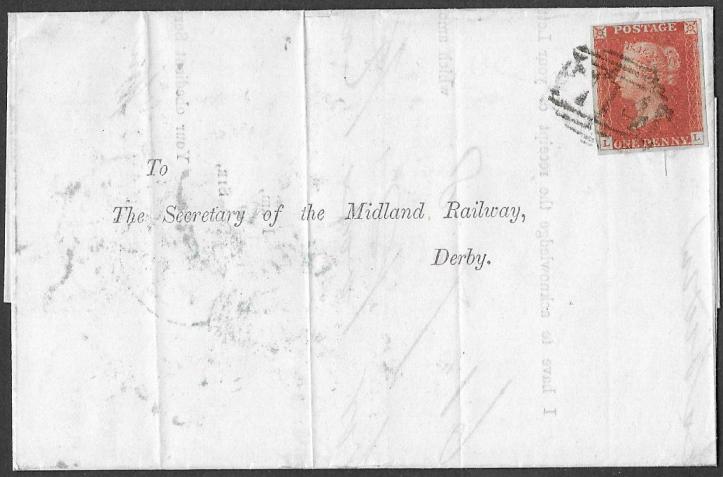
+
POSTAL HISTORY OF
SCOTLAND, IRELAND and
WALES.
This is a section devoted to the Postal History of Scotland, Wales and Ireland
from pre-stamp to the end of Victoria’s reign and includes stamped covers and stamps,
cancellations including Dotted
Circles and Experimental Types.
The selection
of items is a
representation only of our current stock so your Wants List is welcomed.
This Section contains a large range of stamps, pieces and covers from these three regions
so do scan down to the end.
1d Plate 41: Skipton numeral

154197.
1d Plate 41,'LL', very fine with full margins,
tied to a printed entire, dated July 8th 1848, by the '714' of Skipton.
On the reverse is a Derby receiver in blue for July 10th 1848.
Plate 41 was withdrawn from press on May 18th 1844 and destroyed on February27th 1845.
The example offered here is a usage of this plate. more than 3 years after it was destroyed.
A fine display item.
Price: £55.00
1d Plate 72 on entire from Castle Douglas
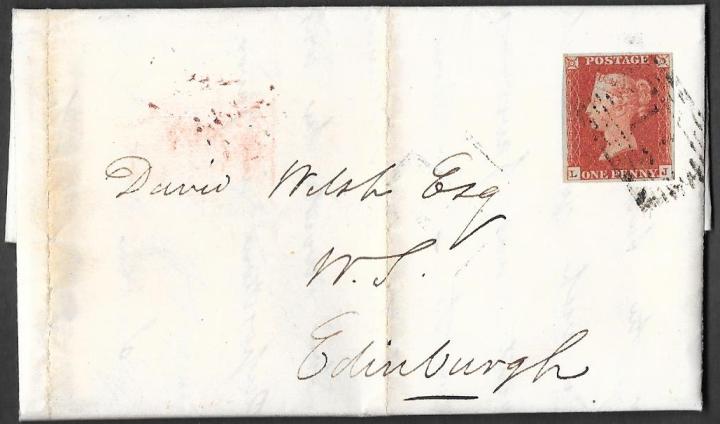
154200
1d Plate 72, fine full-margined, 'LJ', tied to an entire to Edinburgh by the '71' of Castle Douglas.
On the reverse is a Castle Douglas boxed date stamp in bluey-green for June 23rd 1847.
1d SG Spec BS61c 'Constant varieties on 'LJ'.
Price: £40.00
Edinburgh Blue Duplex
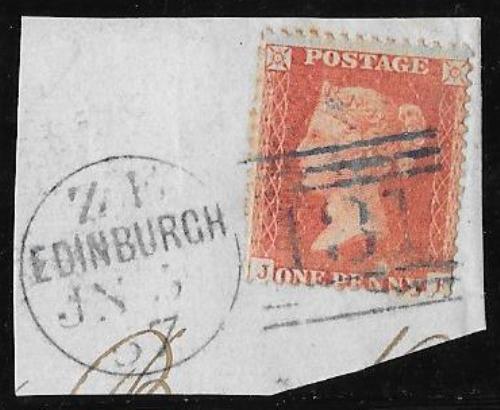
153678.
1d SG33, plate 43, tied to a piece by a
fine Edinburgh blue duplex for June 5th 1857.
Gibbons Spec C8vb, priced at £375 on piece.
A very collectable example of this coloured duplex.
Price: £75.00
2d Plate 8: Edinburgh Dotted Circle Type A1
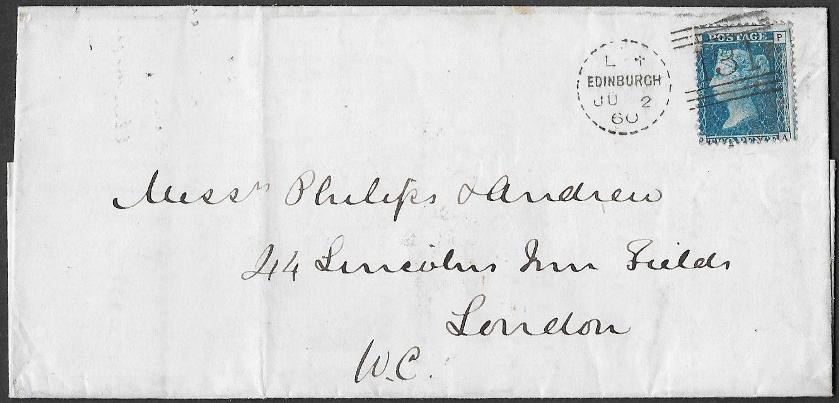
154123.
2d SG45,'PA', Plate 8: fine used, very small rub top left side, tied to a clean wrapper
by a very fine First Type of Edinburgh Dotted Circle issued A1, for June 2nd 1860 with an unrecorded combination of codes.
Arundel makes the observation that decidedly rare is the use of this cancel on any issue other than the contemporary 1d.
This is our experience too.
He does record a 2d Plate 8 on cover with Type A1
and prices it at six times that of its usage on a 1d on cover.
A very scarce and attractive example of the first issue of a Dotted Circle which displays well.
Price: £50.00
Edinburgh Dotted Circle Type A3: very rare usage on 6d SG70
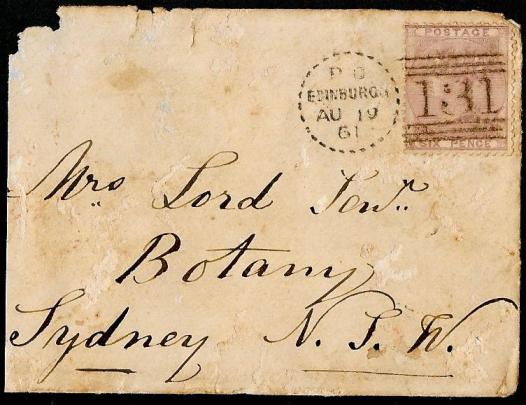
154174
A reduced envelope at left, from Edinburgh to BOTANY NSW, Australia.
Tied by a fine strike of the Edinburgh Dotted Circle Type A3 for August 19th 1861.
Unrecorded usage by Arundel on any other value except the contemporry 1d.
This is a very rare usage as he does not record this 6d issue
on any of the other Types A or B Dotted circles of Edinburgh,
nor on any other Dotted Circle Types of Dundee or Greenock.
A tired envelope but a true rarity.
Price: £95.00
NB: we have previously not seen an item of mail sent to Botany.
The internet has information re the history of this interesting location.
A very unusual usage of a Dotted Circle

154077.
A clean,1d pink embossed envelope, light horizontal crease as per scan, to Peebles.
Cancelled possibly initially by a Dotted Circle Type A3, November 13th 1861,
which missed the 1d Postage embossing.
Then struck by a very fine duplex for this same 1861 date.
Have not seen previously a Dotted Circle used in this way.
Would make a fine Display item.
Price: £45.00
Edinburgh Dotted Circle Type A9 on 1/2d Plate 10
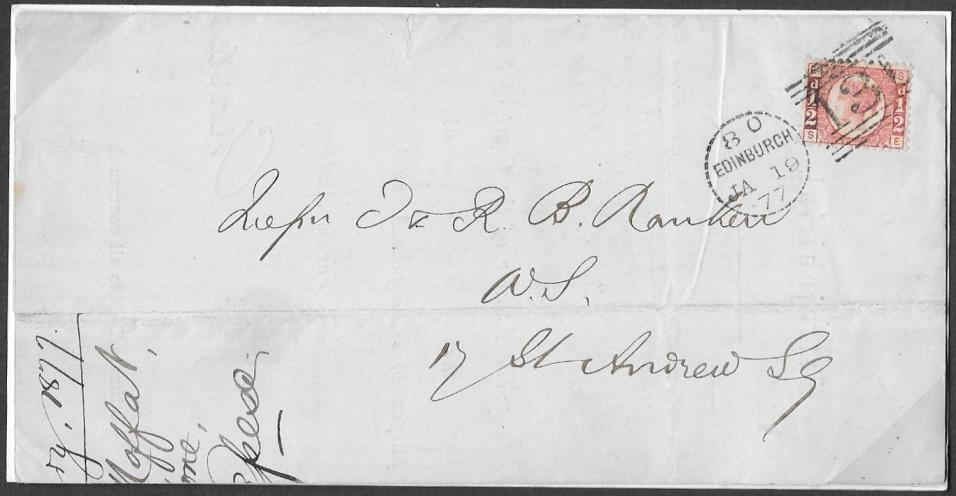
154178.
Printed entire used locally in Edinburgh.
The very fine 1/2d plate 10 is tied by a very fine Edinburgh Dotted Circle for January 19th 1877.
Arundel notes that this Type is normally found cancelling the Penny Plate Numbers:
usage on 1/2d SG48 is scarce.
Price: £50.00
1/2d Plate 6 Pair Edinburgh Dotted Circle Type A9: perforation variety on one stamp
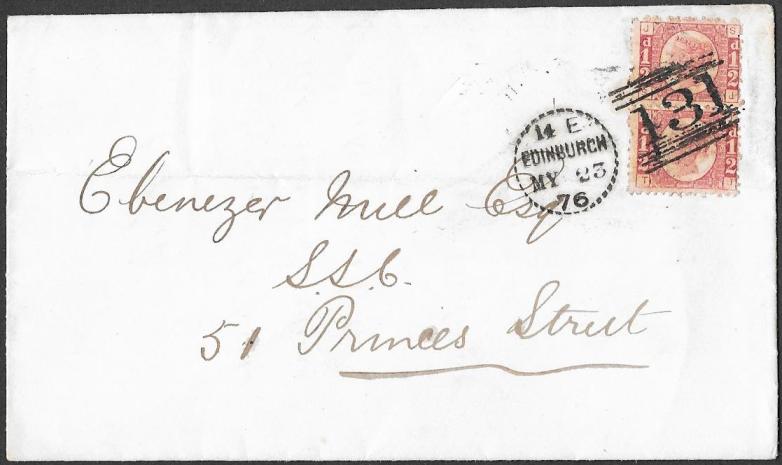
154153.
Bantam 1/2d Plate 6, vertical pair, 'SJ-TJ', tied to a clean envelope used locally
by a fine/very fine Edinburgh Dotted Circle Type A9 for May 23rd 1876.
A horizontal filing crease crosses the bottom of 'TJ' but 'SJ' is fine.
The usage in May 1876 is unrecorded by Arundel.
Although this is a Type frequently found cancelling the contemporary 1d,
Arundel notes that its usage on the 1/2d SG48 is scarce.
Stamp 'SJ' shows unusual incomplete perforation along the top:
the first time we have seen this variety on this issue.
A rare combination of features which make this a Display item.
Price: £50.00
Edinburgh Dotted Circle Type A13
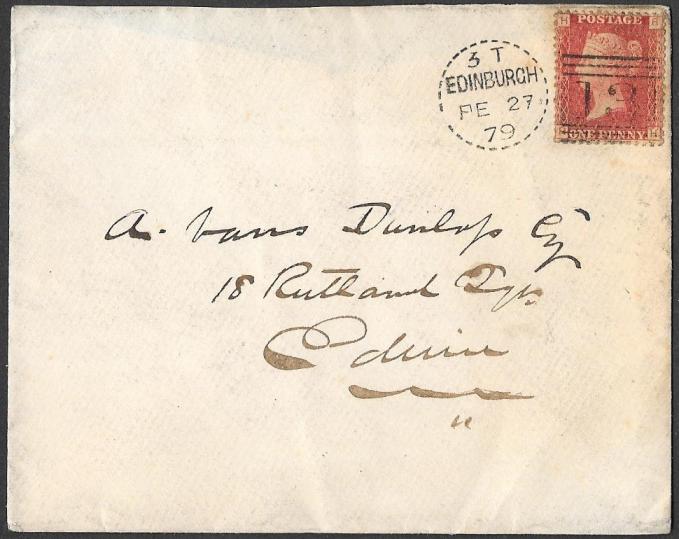
154148.
1d Plate 205, fine, 'RH', tied to a clean envelope used locally in Edinburgh
by a fine/very fine strike of the rare Edinburgh Dotted Circle Type A13.
In September 1878, one of the cuts opposite the left of the plug for month sustained damage.
The example here shows this damage.
Ranked 17th in Rarity out of 25 Types noted by the Scottish Postal History Group (SPHG).
Four of the Extremely Rare Types are only known as a single example.
Price: £75.00 SOLD
Edinburgh Dotted Circle Type A13: coloured crest on reverse.
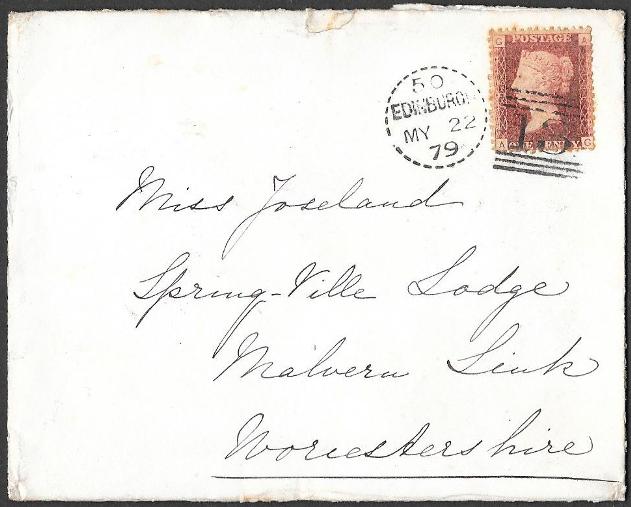
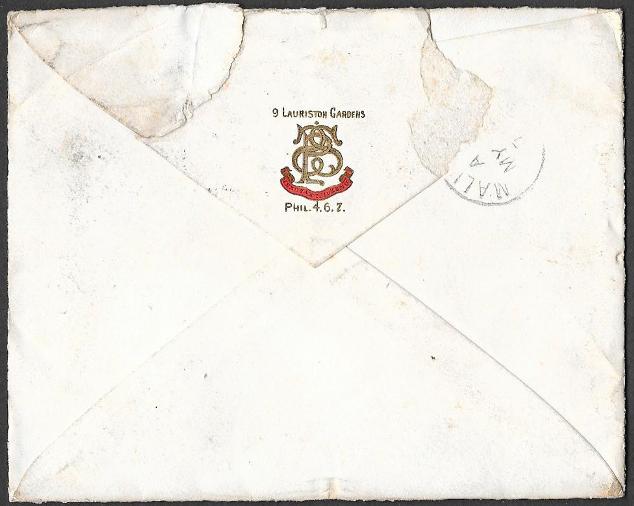
154005.
1d plate 196, tied to an envelope, roughly opened, from Edinburgh to Malvern
by the very scarce/rare Edinburgh Dotted Circle Type A13: the only Type A with 30 cuts.
In September 1878, one of the cuts opposite the date plug was damaged and it is clearly seen in this 1879 example.
Arundel notes that this cancel appears to have been in light use June 1878 until June 1879.
After this date only one example is known in 1880: the last recorded date of February 16th 1880.
Apart from the top flap damage, the envelope is fine/very fine and
on the reverse are printed coloured entwined initials of presumably the sender.
A fine item that would display well.
Price: £65.00
Edinburgh Dotted Circle Type B1
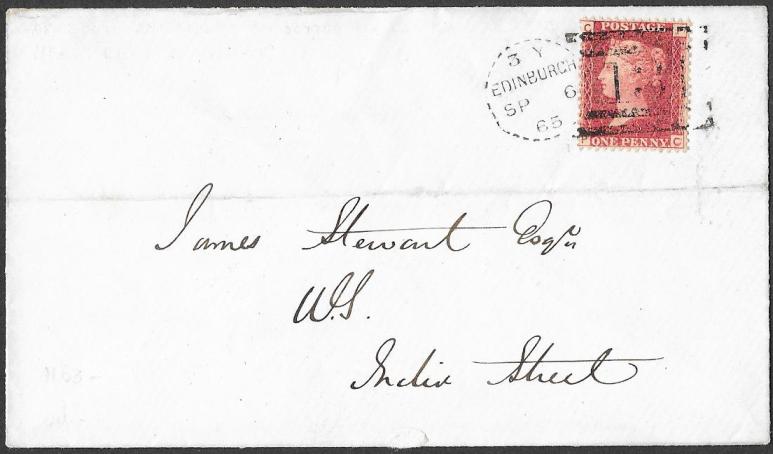
154154.
1d plate 71, 'PC', tied to an envelope used locally
by the scarce/very scarce Edinburgh Dotted Circle Type B1 for September 6th 1865.
It was in concurrent service with Types A3 and A5:
the latter two were employed for the bulk of the work resulting in Type B1 being lightly used.
It would seem that Type B1 was held in reserve for peak periods when the volume of mail was heavy.
The code combination 3 Y is unrecorded by Arundel.
Price: £50.00
The Rare Type C2 Edinburgh Dotted Circle
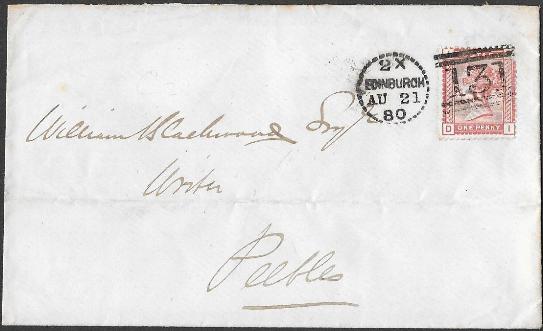
154151.
1d SG166, damaged at the right, tied to a clean envelope to Peebles
by a very fine Edinburgh Dotted Circle Type C2 for August 21st 1880.
Arundel notes this as a rare Dotted Circle in service for less than a year.
Its Latest Known Date of usage is September 10th 1880:
less than three weeks after the example offered here.
There is a horizontal filing crease well away from the stamp and cancellation.
Arundel lists only two '2' code combinations ie 2 W and 2X.
Price: £40.00
Edinburgh Dotted Circle Type C3 Earliest Known Date of Usage
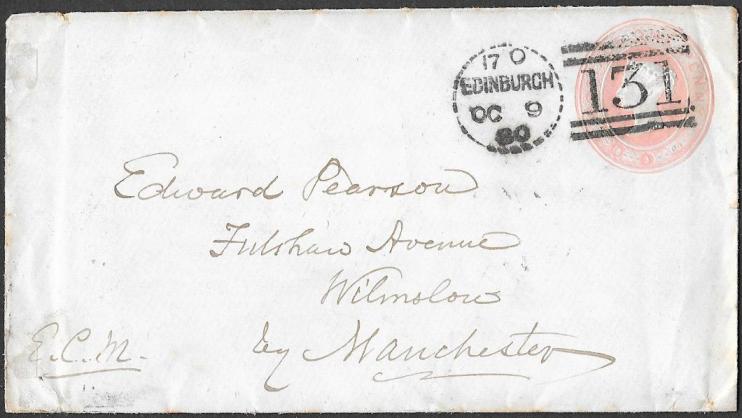
154150.
A neat 1d Pink Stationery Envelope to Manchester cancelled by a
fine Edinburgh Dotted Circle Type C3 for October 9th 1880:
on the reverse is a very fine Manchester receiver for October 10th 1880.
Although this Type is frequently seen, it is very rare on the 1d Stationery Envelope.
Arundel records the Earliest Date of Usage as November 25th 1880.
The example offered here at October 9th 1880, predates it by several weeks.
The code combination of 17 O is unrecorded by Arundel.
A very rare/unique set of features making this a very interesting Display item.
Price: £65.00
Edinburgh Dotted Circle Type C3 with original contents
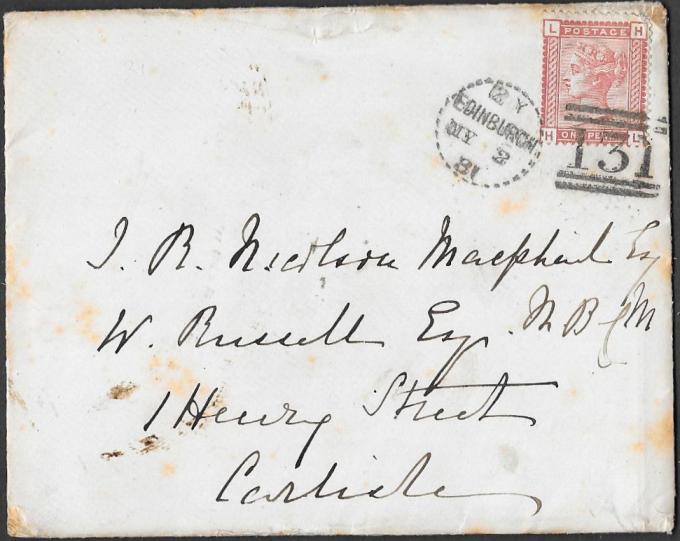
154149.
1d SG166, with an almost clear QV head, tied to a clean envelope to Carlisle,
by a fine/very fine Edinburgh Dotted Circle Type C3 for May 2nd 1881.
Unrecorded by Arundel Codes 12Y.
A frequently seen Type but a fine example on an envelope
which is finer than the scan suggests:
the browning is either much fainter or not there at all.
The letter has been cross written in parts.
Price: £27.00
Type C3 Unrecorded usage on 1d lilac Die 1 and on Mail to Ireland
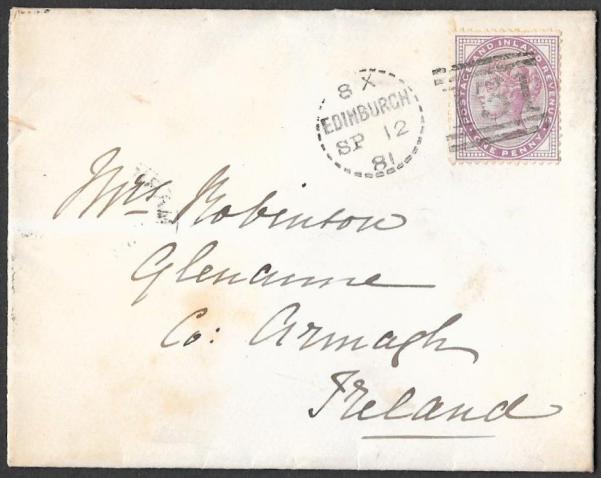
154100.
Edinburgh Dotted Circle Type C3 tieing a fine 1d lilac Die 1 to a tidy envelope to Ireland.
The browning is much fainter than the scan suggests.
Arundel comments that it is the most often seen of the Type C Dotted Circles.
This Type is normally found on the 1d Plate numbers and on the 1d Venetian Red.
Rarely used on the 1d pink stationery envelope and on the Threehalfpence Venetian.
The example offered here is an unrecorded usage on the 1d lilac Die 1.
Its usage on mail to Ireland is also very rare:
we cannot recall being able to offer ANY Type of Dotted Circle to Ireland.
Its Latest Known Date of usage is September 17th 1881.
The example offered here is close to that date: just 5 days earlier.
A rare combination of features that would make an interesting Display page.
Price: £58.00
Edinburgh Dotted Circle Type C5
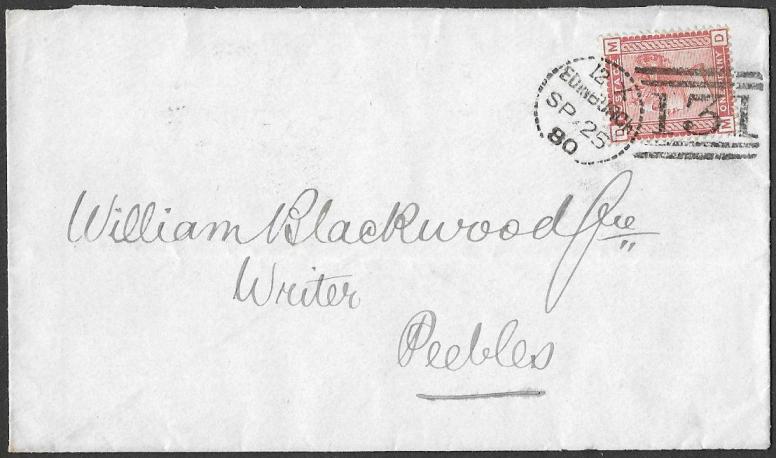
154152.
1d SG166, fine, on a clean envelope (light horizontal crease away from the stamp),
tied by a fine/very fine Edinburgh Dotted Circle Type C5 for September 25th 1880.
A fairly common Dotted Circle largely used in 1879 and 1881 but lightly in 1880.
Arundel records only two '12' code combinations ie 12T and 12X.
A fine example of this Type.
Price: £28.00
Edinburgh Dotted Circle Type C5: several unrecorded features
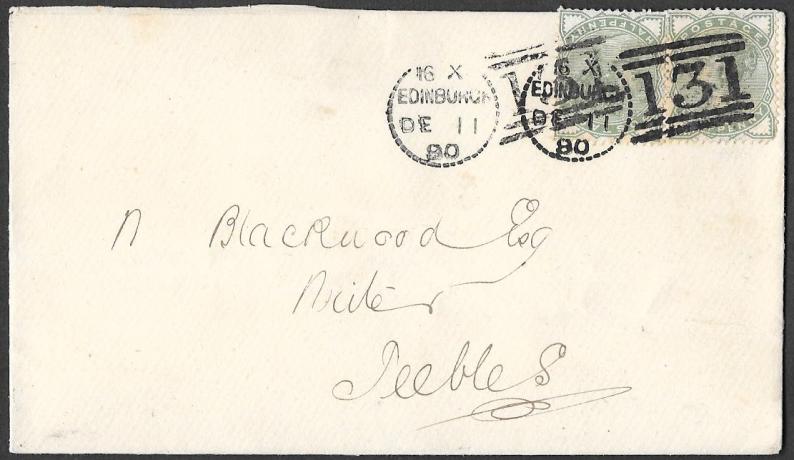
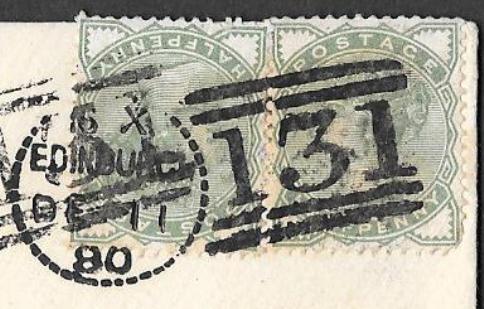
154081.
Edinburgh Dotted Circle Type C5, Code 16X, tied to a clean envelope to Peebles for December 11th 1880.
Unrecorded month of usage by Arundel, unrecorded Code 16X and very scarce on the 1/2d green.
Arundel aslo notes that this Type was heavily used in 1879 and 1881 but lightly in 1880.
Unusually, the 1d postage paid by two 1/2d's SG164 rather than the contemporary 1d.
They have been affixed in a tete beche orientation which we have not seen previously.
An interesting and unusual set of features that make it a Display item.
Price: £40.00
Edinburgh Dotted Circle Type C6 used locally
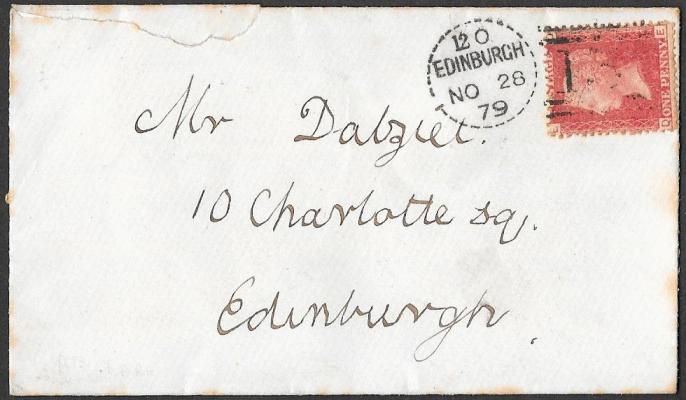
154147.
1d Plate 212, a scarcer plate, 'DE', fine with an almost totally clear head, tied to an envelope
used locally in Edinburgh by an Edinburgh Dotted Circle Type C6 for November 28th 1879.
The dater circle was that used in Type A13
and has the same break in the cuts at the left opposite the date plug.
The SPHG note that 1879 dates are scarce.
A fine example.
Price: £32.00
NB: There are many more Dotted Circle items further down this Section
of Edinburgh, Dundee and Greenock including examples on values other
than the contemporary 1d.
A pair of superb Entires with 1d reds in deep original colours
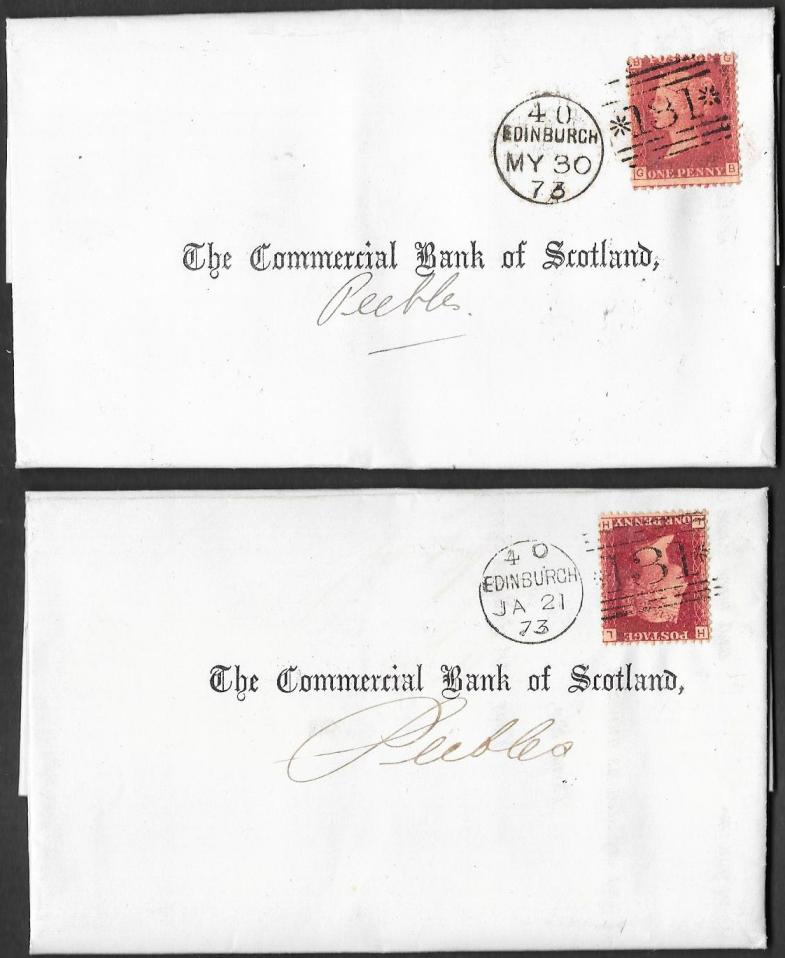
154155.
A pair of entires in superb condition from Edinburgh to the same Bank in Peebles.
The 1d plates have superb original colour:
'GB', May 30th 1873 is Plate 134 and 'LH', stamp affixed inverted, January 21st 1873, is Plate 159.
They would make an attractive Display page.
Rarely found in such superb overall condition
and the finest we have seen or indeed able to offer.
Price the pair: £27.50
NB: the scan does not do justice to the colour of the 1d reds.
2d SG23: Aberdeen Type 1a: damaged 'E'
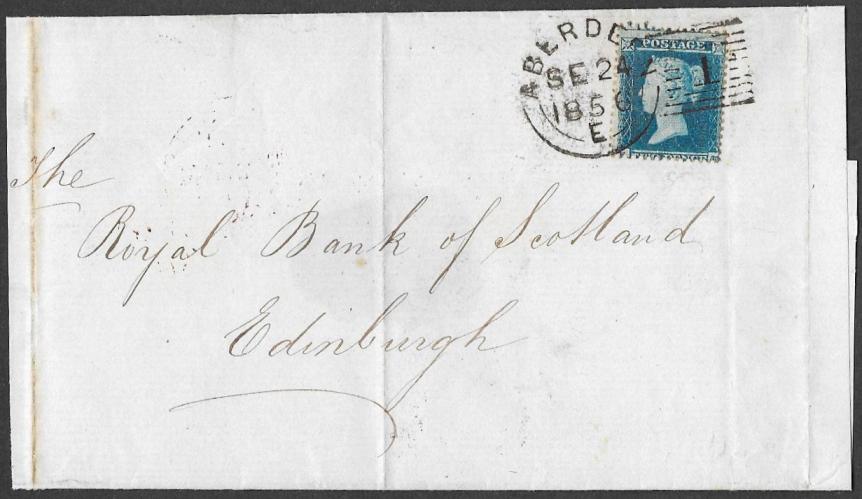
154201.
2d SG23, fine, on a wrapper to Edinburgh with side flaps removed for display purposes.
The 2d is tied by a very fine Aberdeen Duplex for September 24th 1856.
The top of the first 'E' in ABERDEEN was damaged in March 1856 and not repaired until 1859.
Not a rare strike but its usage on cover with this 2d issue is rare
as these Experimental duplexes are usually found on the contemporary 1d issues.
Gibbons prices 2d SG23 on cover at £375 without an addition for the cancellation.
Price: £95.00
An Exceptional Stirling Experimental Duplex on entire
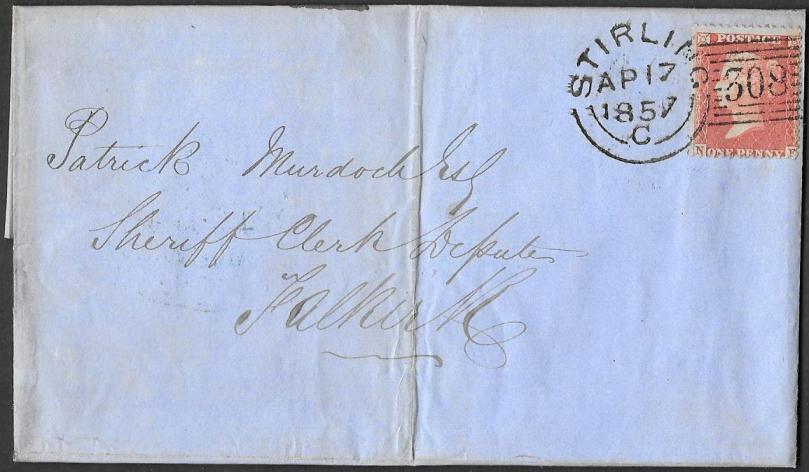
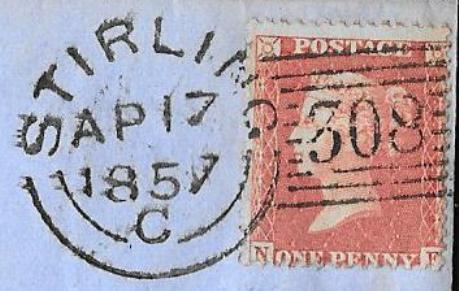
154156.
1d SG29/33 fine, 'NF': tied to an entire to Falkirk
by an exceptional, almost proof-like, strike of the Stirling Experimental Duplex for Apri 17th 1857.
This is a very scarce Type and rated 10th rarest out of 18 Types by
The Scottish Postal History Group (SPHG)
An Exhibition-quality strike.
Price: £65.00
Stirling Experimental Duplex used on cover with 2d SG19 Plate 4
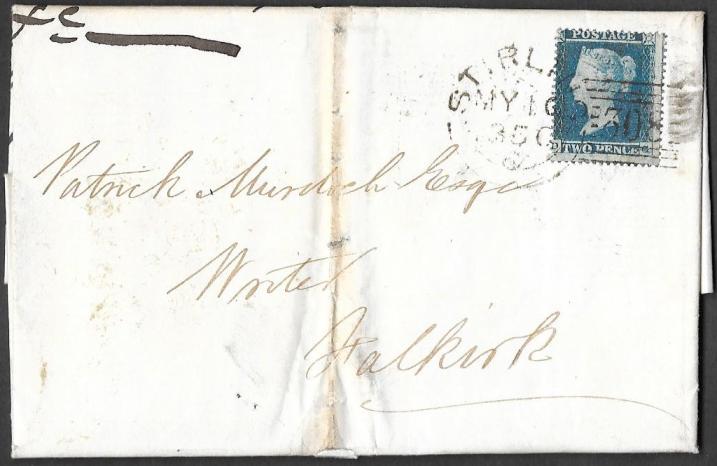
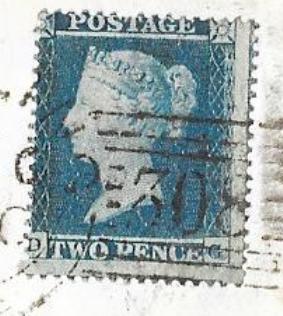
154203.
2d SG 19 Plate 4, 'DG', fine, showing missperfing,
tied to a Banking entire to Falkirk by a Stirling Experimental duplex for May 16th 1856.
A very scarce Type and rated 10th rarest out of 18 Types
by The Scottish Postal History Group (SPHG).
Usually found used with a contemporary: rare to find it on cover with a 2d issue.
Price: 68.00
Superb Greenock Experimental Duplex: rare Type 1

153025.
1d SG29, ‘SK’, (semi gothic ‘K’), very fine, tied to a piece by a
superb strike of the rare GREENOCK Experimental Duplex Type 1 for May 28th 1856.
The Scottish Postal History Group in their publication on Experimental Duplexes,
places this cancellation as the 14th rarest out of 18 types.
In our experience it is as rare as the Leith Type 1 which is 16th rarest.
The number ‘6’ in the year slugs is out of position.
The proof strike does not show this.
A superb and rare item.
Price: £55.00
Rare Greenock Type 1 Experimental Duplex: very late usage


151842.
1d perf 14, SG 29, on an envelope to Burntisland, tied by a fine strike of
the rare GREENOCK Experimental Duplex Type 1 for December 2nd 1856.
The '6' in the year date slugs is twisted and in a similar position to that in item 153025
and the other examples offered here: the proof strike does not show this.
Only four other types are listed as rarer than the Greenock Type 1.
The latest recorded usage in the Scottish Postal History Group publication is December 8th 1856.
This example is hence very close to the latest date of usage.
The 1d SG29, is in the period, October 1856 to March 1857.
Known as the transitional period, the printers were gradually trying to remove the blueing in the paper.
The example here shows some slight blueing.
A rare item which displays well.
Price: £165.00
The Rare Greenock Type 1 Experimental duplex
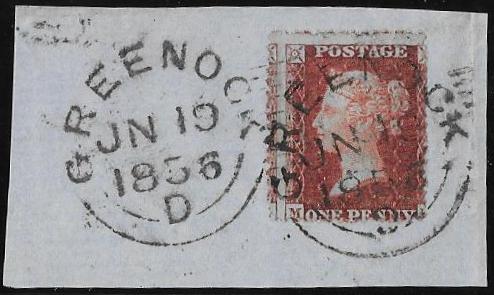
154140.
1d SG29/33, fine, missperfed showing portions of four stamps,
tied to a piece by two very fine strikes of the dater portion of
the rare Greenock Type 1 Experimental Duplex '163':
cancelled Contary to PO Regulations by this double strike.
We have never seen previously such a usage of the Dater Portion only of this rare duplex:
there is just a trace of the first bars of the duplex with each.
The SPHG rank this as the 14th rarest out of the 18 recorded Types.
An extremely unusual, and possibly unique, usage of this rare duplex.
The number ‘6’ in the year slugs is out of position.
The proof strike does not show this.
Price: £68.00
Greenock Type 1 Experimental duplex.
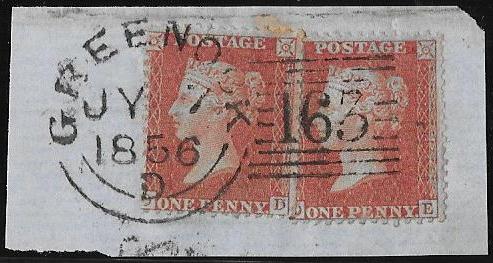
154141.
Two singles, 1d SG29/33, 'OD' and 'OE', both fine, tied to a piece by a
superb complete strike of the rare Type 1 Greenock Experimental Duplex '163' for July 7th 1856.
Ranked 14th rarest out of 18 recorded Types by the SPHG.
The number ‘6’ in the year slugs is out of position: the proof strike does not show this.
A Display-quality item.
Price: £58.00
Greenock Type 2 Experimental Duplex
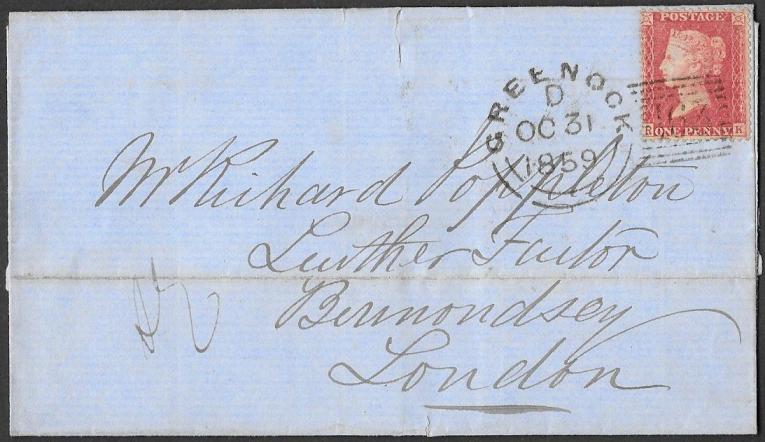
154145.
1d SG39/41, 'RK', fine/very fine with a clear profile, tied to a wrapper to London by a
very fine Greenock Experimental Duplex '163' Type 2 for October 31st 1859.
The latest known date of usage for this duplex is November 19th 1859
so the example offered here is inside the last three weeks of its use.
Although SPHG rank this cancel as the 7th rarest of the 18 Types,
our experience is this is a very difficult cancel to find so finely struck on cover.
Price: £48.00
Greenock Type 2 Experimental Duplex: unprinted area
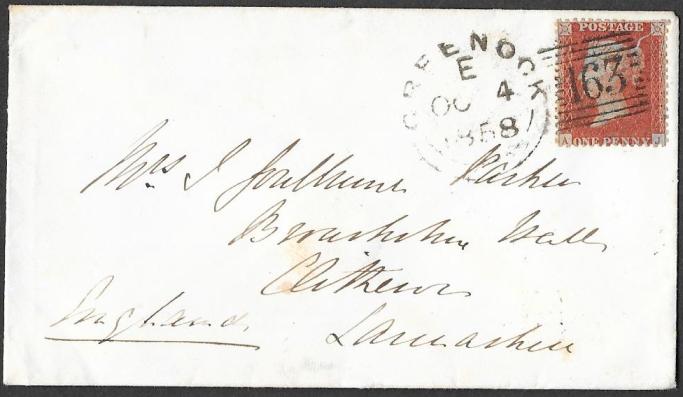
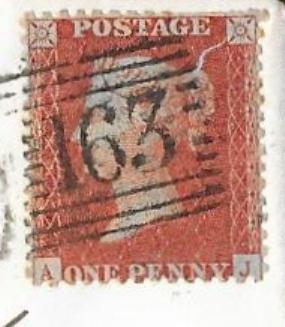
154146.
1d perf 14, tAJ, fine, tied to a clean envelope to Clitheroe
by a Greenock Dotted Circle Type 2 for October 4th 1858.
As seen in the scan an area above QV's head at the right is unprinted.
Caused by foreign material on the printing plate or possible damage to the plate itself?
An unusual and rare combination of features: a Display item.
Price: £45.00
An Exceptional Stirling Experimental Duplex on entire


154156.
1d SG29/33 fine, 'NF': tied to an entire to Falkirk
by an exceptional, almost proof-like, strike of the Stirling Experimental Duplex for Apri 17th 1857.
This is a very scarce Type and rated 10th rarest out of 18 Types
The Scottish Postal History Group (SPHG)
An Exhibition-quality strike.
Price: £65.00
A printed Advertisement for the letting of FERNIE CASTLE (Fife) in 1846
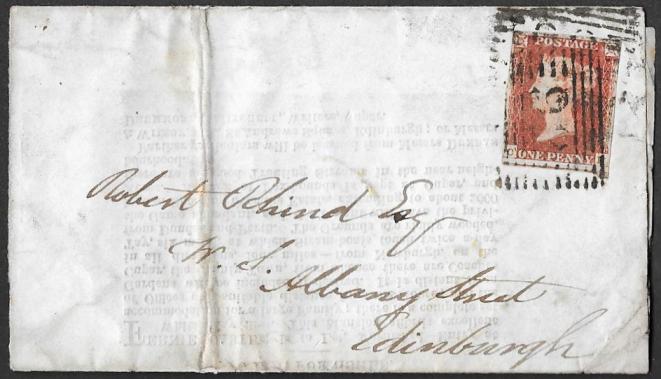

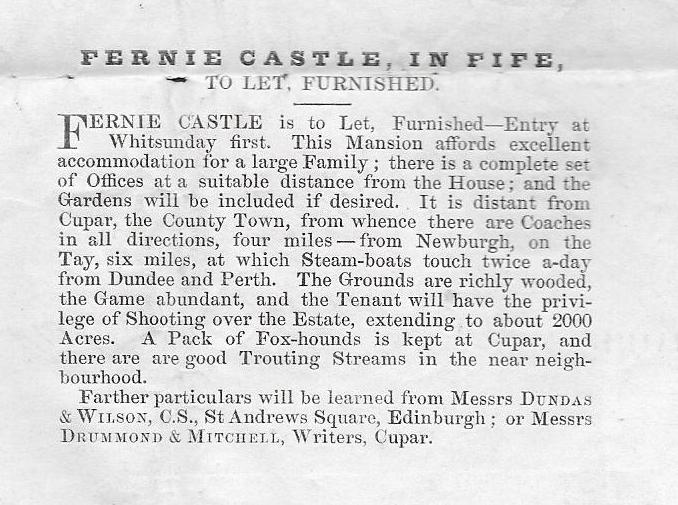
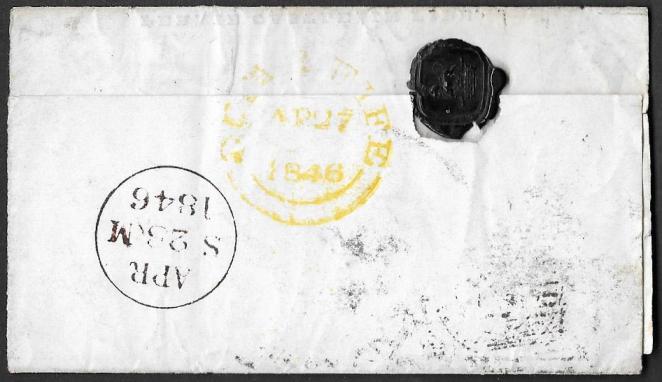
154134
1d red, 'CE'? fine full-margined, tied to an entire by unusually a double strike of the '92' of Cupar (Fife).
On the reverse is a dated cancel for April 27th 1846 struck in an unusual shade of yellow.
The name is unclear except for ending in 'FIFE' .
On the inside is an Advertisement to Let, Furnished, FERNIE CASTLE, IN FIFE.
The advertisement re what the Castle offers and the advantages of its location
could be incorporated in a Display page.
A glimpse of how some people lived and travelled in that part of Scotland in 1846.
A very rare survivor and likely to be unique.
Price: £45.00
NB: there are images of, and a considerable amount of information about,
the long history of Fernie Castle
that would be helpful in developing this item into a very fine Display page(s).
Dumfries Distinctive Cross on envelope to Castle Douglas
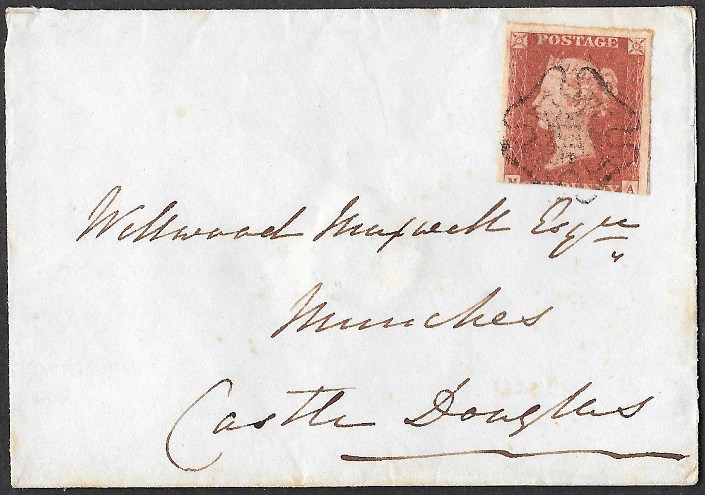
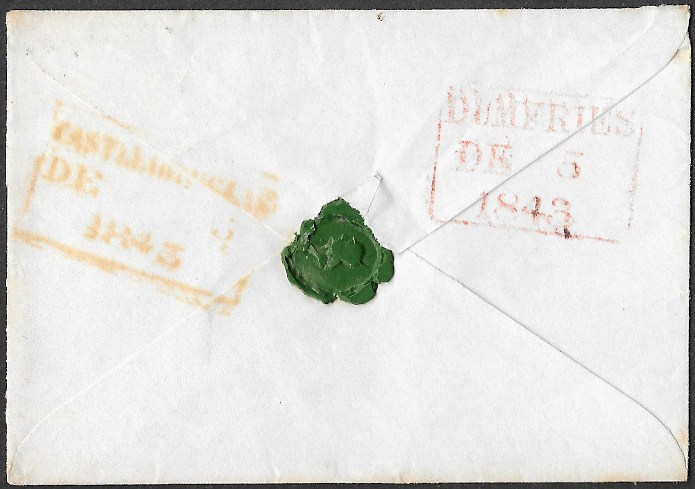
153058.
A small, neat envelope from Dumfries to Castle Douglas, December 5th 1843.
The 1d red, 'MA', fine, 3-margined, is tied by a neatly applied Dumfries distinctive cross.
Listed by Gibbons, Spec SG B1tj and priced at £1,100 on cover.
This attractive example, which would make a fine Display page,
is unrecorded by Rockoff and Jackson Volume 1.
Price: £220.00
Greenock Characteristic Cross: superb strike
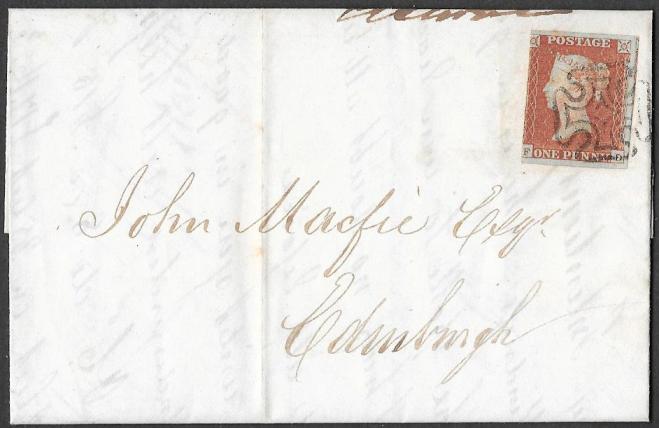
154111.
1d Red Plate 23, 'FD', a fine 3-margined example with a clear QV profile.
Tied to an entire from Greenock by a superb and complete Greenock disinctive cross,
SG Spec B1tm, and priced at £500 on cover.
Not a scarce cross but rarely is it found so fine and complete.
On the reverse top flap is a boxed Greenock date stamp for March 24th 1843.
Display quality.
Price: £55.00
Group of Illustrated Envelopes to the USA advertising Hotels
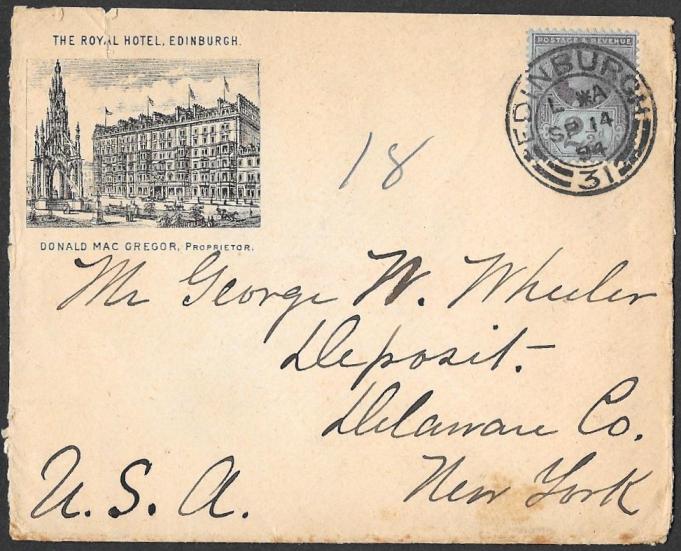
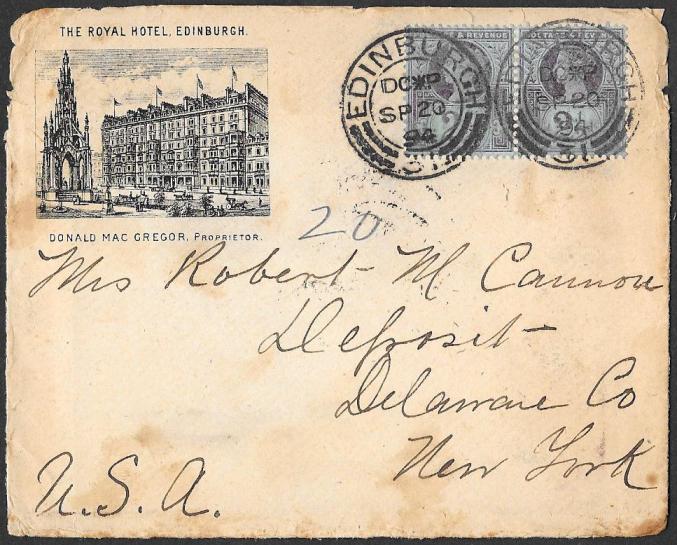
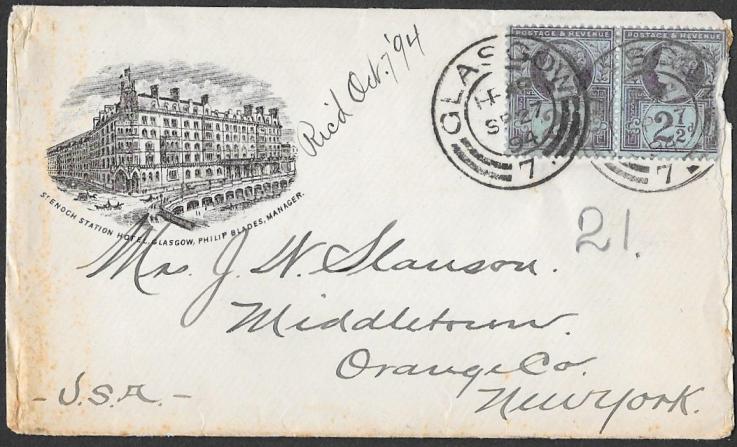
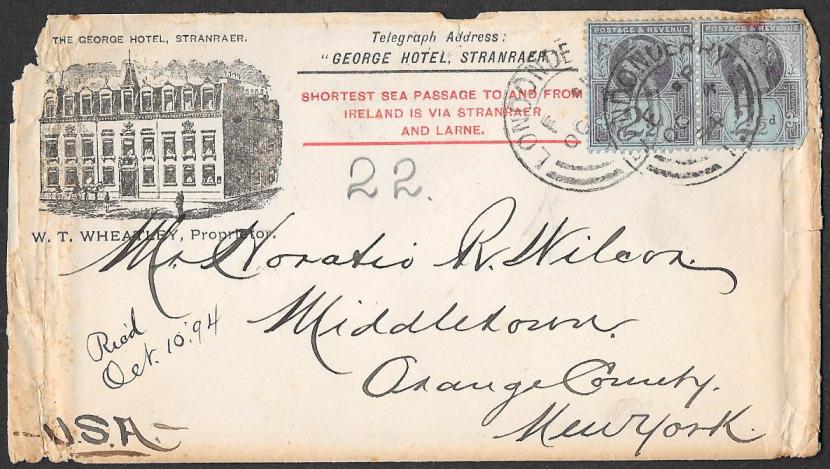
154105.
Four envelopes each with a line engraving of a Hotel: and each posted to a location in the USA.
Dates range from September 14th 1894 to October 4th 1894.
Written in pencil is a number, 18, 20, 21, and 22.
This is the order in which they were sent to the USA clearly written by the same person who was travelling.
It poses the obvious question how many in total did he/her send and do others of the sequence survive?
Number 21 has the name of the Hotel embossed on the reverse.
Printed on Number 22 is: 'Shortest Sea Passage to and from Ireland is via Stranraer and Larne'.
The group would make an interesting and memorable display page(s) when fully written up eg with details of the Hotels.
Some peripheral faults but a very unusual and rare assemblage that displays well.
Price: £60.00
NB: the postage paid by either a single or a pair of the 'Jubilee Issue' twopence halfpenny, SG201.
Letter from India to Edinburgh redirected to Paisley 1826
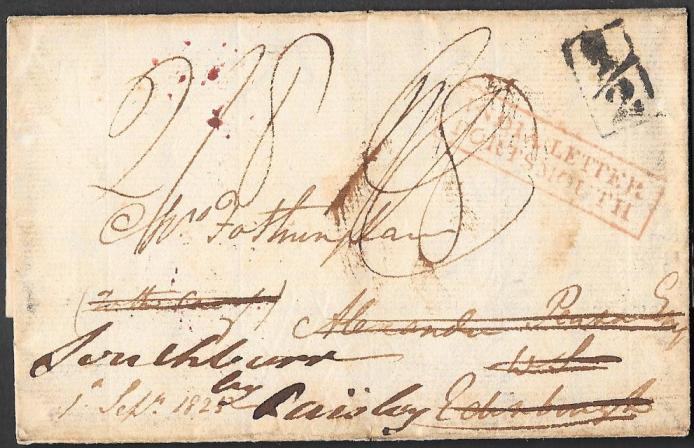
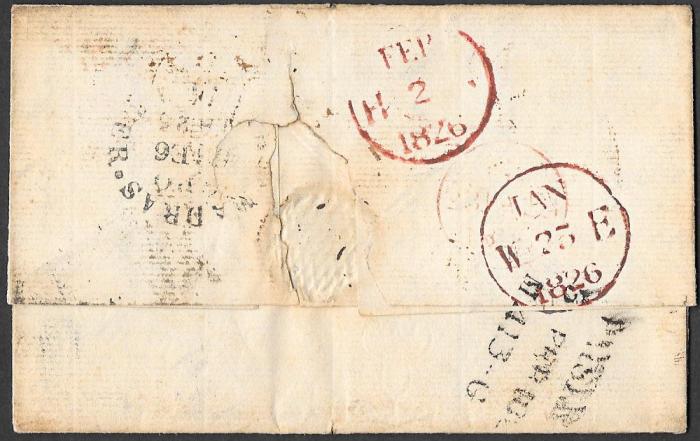
154094.
Fine last page of a letter from India to Edinburgh redirected to Paisley.
On the front is a London Additional 1/2d, Sedgewick Fig 141 and
a boxed Portsmouth Ship Letter, 'India Letter /Portsmouth', County Cat. HA1670, in red from 1820.
There is also a clear m/s for 2/8 on the front.
On the reverse are various transit date markings including that of Paisley:
the letter's final destination.
A very scarce/rare combination of features which could display well.
Price: £58.00
A rare combination of Markings
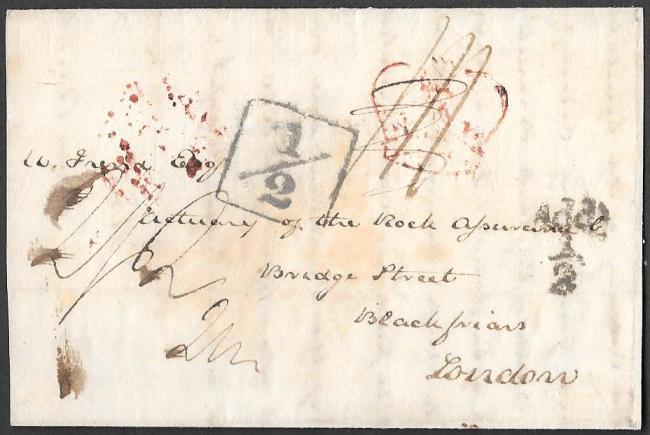
154095
Part letter, sides removed for display purposes, London from Edinburgh in 1827.
Edinburgh Additional 1/2d, Sedgwick Figure 14, and a London Additional 1/2d Figure 140.
Sedgwick comments that this London Add 1/2d was probably a special duty cancel.
An Inspectors Crown strike has doubled the postal charge from one and a penny to two and twopence.
The only example we can recall or trace where this mark has been used on mail with two Addtional 1/2d's.
A rare/very rare combination of marks, all on the front and clear of each other:
it would make an attractive display page.
Price: £75.00
NB: see the next Item 154128: it would make a very interesting Display pairing.
Dundee Additional 1/2d: postage charge doubled
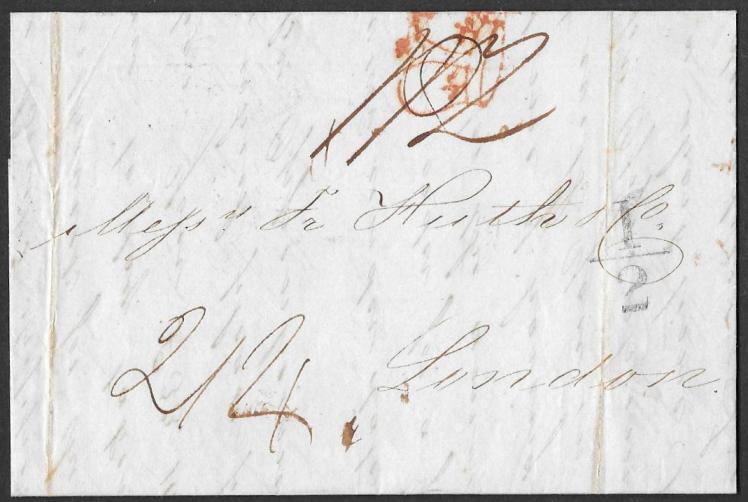
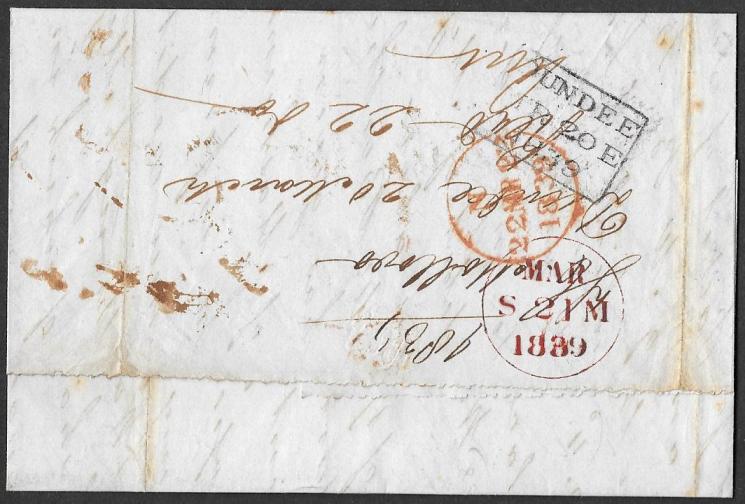
154128.
Entire from Dundee to London, March 20th 1839.
On the front is a very fine Dundee Additional 1/2d,
Sedgewick and Hodgson, Figure 54, Type 1VA.
The letter was charged one and tuppence, in m/s, but an Inspectors Crown was struck over it
and a m/s postal charge of double ie two and fourpence applied.
A rare combination of an Additional 1/2d with a rate change by an Inspector with a Crown applied.
The postal transit markings on the reverse display well when the rear flap is raised.
Price: £58.00
NB: This item and item 154095 would make an excellent Display pairing.
Dundee Dotted Circle Type A2: rare 1875 usage
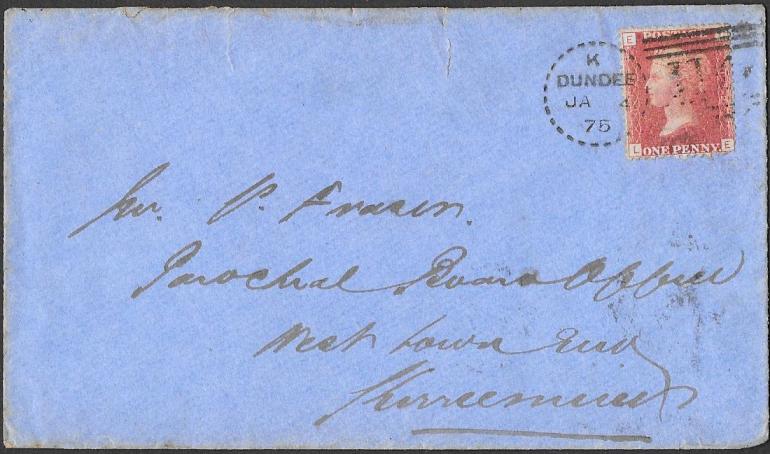
154054.
1d plate 172, fine, ‘LE’, Type A2:
tied to a clean envelope to Kirriemuir by a Dundee Dotted Circle, January 4th 1875.
Arundel notes that this is a scarce Type which appears to have been infrequently used
and he had not seen any examples used in 1875 or 1876.
This concurs with our experience of these dates.
A scarce/very scarce usage.
Price: £43.00
Dundee Dotted Circle Type A1 on a scarcer plate
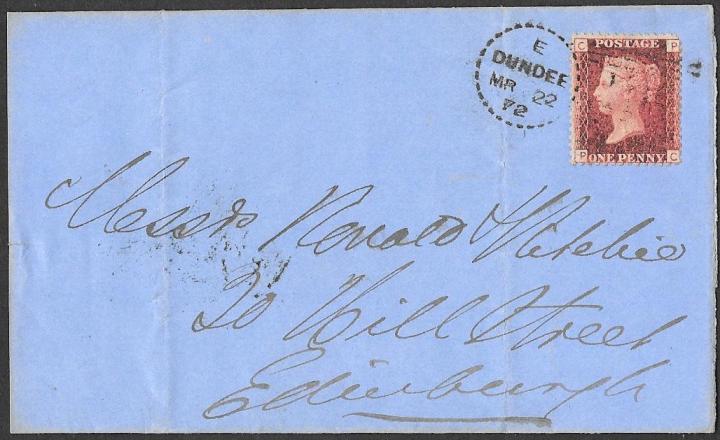
154055.
1d plate 139, a scarcer plate, fine, ‘PC’, Type A1:
tied to a wrapper to Edinburgh by a Dundee Dotted Circle for March 22nd 1872.
A scarce combination.
Price: £22.00
Dundee Dotted Circle Type A5:
unrecorded usage on 1/2d SG187
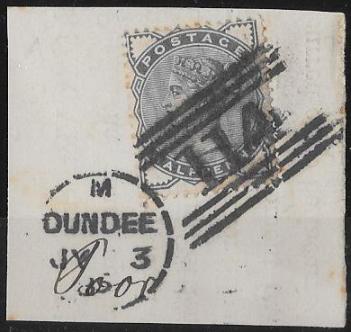
154057.
1/2d SG187:
tied to a piece by a Dundee Dotted Circle Type A5 for July 3rd 1885.
Arundel does not record a usage of this scarce cancel in July 1885
and notes that its usage appears to have been infrequent.
The only other date of usage in 1885 was in January.
No usage of the 1/2d SG187 is recorded
on any of the nine Types of this cancel.
A very rare item.
Price: £35.00
Dundee Dotted Circle Type A5
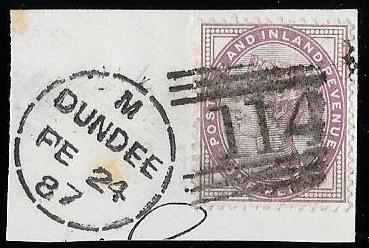
154058.
1d lilac tied to a piece by a very fine strike of a
Dundee Dotted Circle Type A5 for February 24th 1887.
Arundel comments that its usage was infrequent
and only one date recorded in 1887 ie for April.
Price: £17.50
NB: the couple of brown spots are hardly visible: trick of the scanner
Dundee Dotted Circle Type A1: Latest Date of Usage
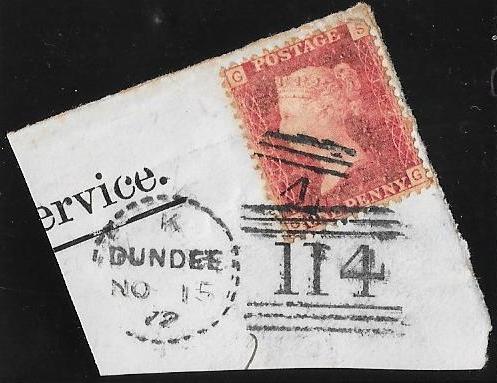
154060.
1d plate 154, ‘SG’, tied to piece by a fine
Dundee Dotted Circle Type A1, for November 15th 1872.
This date matches the Latest Known Date of usage recorded by Aurundel.
Very scarce item.
Price: £33.00
Dundee Dotted Circle Type A2
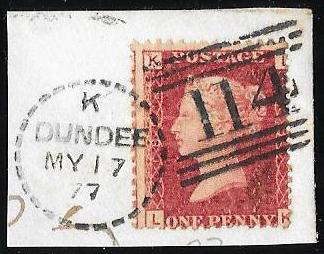
154062.
1d plate 185, ‘LK’, creased, tied to a piece by a
very fine Dundee Dotted Circle Type A2 for May 17th 1877.
Arundel records only two months of usage in 1877 of this scarce cancel:
April and May.
Price; £16.00
Dundee Dotted Circle Type A2
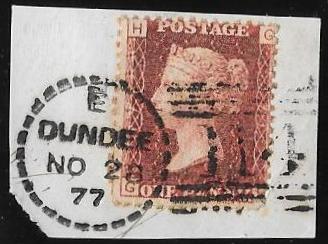
154064.
1d plate 174, ‘GH’, very fine, tied to a piece by a very fine
Dundee Dotted Circle Type A2 for November 28th 1877 Code E.
An unrecorded month of usage by Arundel and he notes that
Codes D and E less frequently found than K and M.
Price: £17.00
Dundee Dotted Circle Type A2
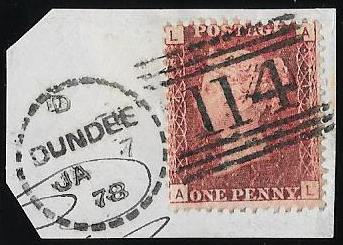
154063.
1d plate 174, ‘AL’, very fine, tied to a piece by a superb strike of
the scarce Dundee Dotted Circle Type A2, for January 7th 1878 Code D.
An unrecorded month of usage: only two others recorded by Arundel for 1878.
He also notes that Codes D and E are less frequently found than K and M.
Price: £18.00
Dundee Dotted Circle Type A7: unrecorded features
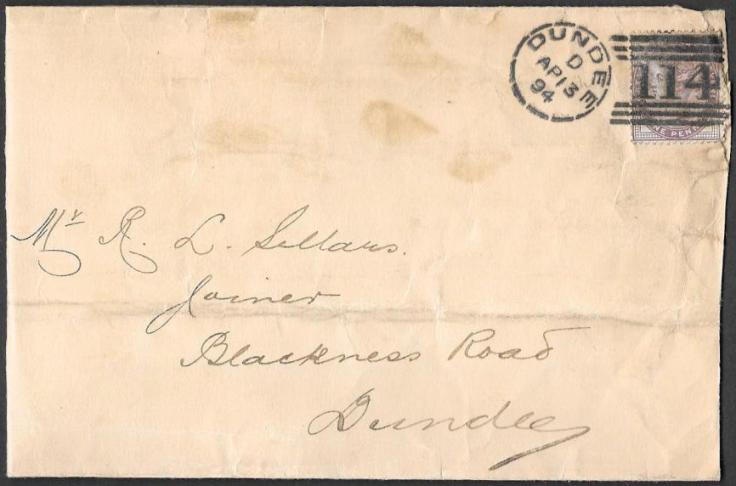
154066.
1d lilac, fine, tied to a long envelope, used in Dundee, folded at the left for display purposes,
by a superb Dundee Dotted Circle Type A7 for April 13th 1894, Code D.
Arundel notes that this cancel was used lightly for a few months and thereafter only spasmodically.
NO examples are recorded by him used during 1894.
He notes only codes B, H, M and O were employed.
The Scottish Postmark Group list 12 codes, derived from the Proof books
rather than actual examples used.
No Code D is recorded in use by Arundel.
A rare item with a local use
Price: £46.00
Dundee Dotted Circle Type A2 with a superb 1d Plate
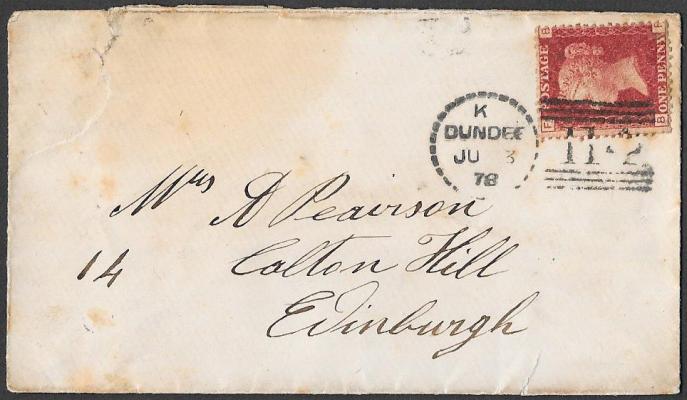
154067.
1d plate 205, ‘BF’ superb colour with almost all of QV's head clear>
Tied by a Dundee Dotted Circle Type A2 for June 3 1878 to an
envelope to Edinburgh with a receiver cds for the same date.
Arundel notes the infrequent usage of this Type:
and records only two monhs of usage in 1878
ie June and September, the latter being its last month of usage.
Price: £28.00
NB: the browning on the front is very much fainter than in the scan.
Rare Dundee dotted circle Type B1, EKD, unrecorded usages

153663
Dundee dotted circle Type B1,
a very fine/superb strike for December 22nd 1885,
on a piece of a one penny brown postcard.
Aurndel notes this Type in usage from January 28th 1886 to April 4th 1893.
The example offered here shows a
usage some 5 weeks EARLIER than this.
It has an unrecorded Code K.
Arundel also notes that this type has few examples recorded
and appears to have been used very infrequently:
he records only a usage on the Penny Lilac.
The item offered is hence showing an unrecorded usage.
A very rare/unique combination of usages.
Price: £50.00
Rare Dundee dotted circle Type B1 unrecorded usages

153664
Dundee dotted circle Type B1,
A very fine/superb strike tieing a 1/2d vermilion SG197
to a piece, dated March 28th 1891: an unrecorded month of usage.
Arundel notes that this type has few examples recorded
and appears to have been used very infrequently:
he records only a usage on the Penny Lilac.
The item offered is hence showing an unrecorded usage.
A very rare combination of uses.
Price: £40.00
153663 and 153664 would make a superb display and possibly a unique pairing.
Unrecorded usage on this UPU card and rare to an overseas location


15086:
Dundee Type A7:
Fine/very fine strike on a very fine 1d
red UPU postcard, August 5th 1893,
to Holland with a hand written message re vegetable supplies.
An unrecorded usage by Arundel on any postcard type and
in fact
no Dundee dotted circle has been recorded used on this UPU card.
A rare usage of a Dundee dotted circle to an overseas destination.
Very rare item in excellent condition.
Price:
£95.00
6d Plate 11: Dundee Dotted Circle Type A1

153327
6d Plate 11, SG123, 'GA': couple of tight perfs at NE 'G' square.
Cancelled by a DUNDEE Dotted Circle, June 21st 1872.
An unrecorded usage of Type A1 by Arundel in June 1872
and one of the latest recorded.
Arundel does not record ANY of the Dundee Dotted Circle nine types,
on any surface printed issues.
A rare item and usage.
Price: £50.00
Dundee dotted circle Type A2

154028.
2d1/2d SG141, Plate 6, 'BD', very fine used:
cancelled by a very fine/superb Dundee Dotted Circle dater of Type A2, for April 17th 1877.
Arundel notes this is a scarce Type infrequently used in its period of usage.
No examples are recorded by him on any surface printed issue:
only on the contemporary 1d plate numbers and bantam 1/2d.
Gibbons prices Plate 6 at £85 before a premium of 100% is added for a CDS cancel
and a further premium for the Type of dotted circle cds.
A superb display item with a very rare combination of features.
Price: £68.00
Scots Local Type XV111 on 1d pink envelope
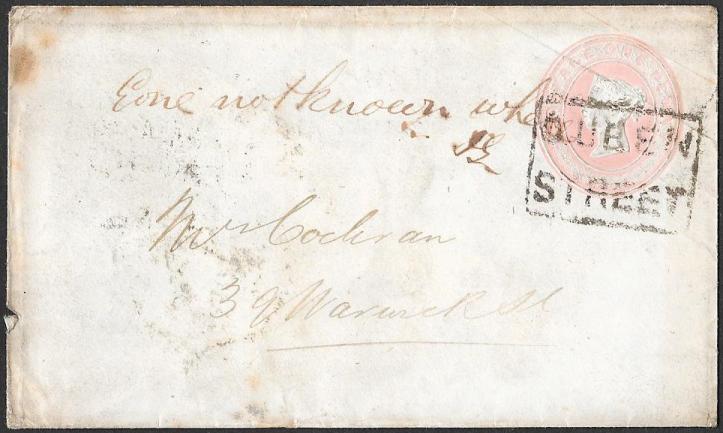

154003.
A 1d embossed envelope, used locally in Glasgow, February 26th 1856,
cancelled by a fine/very fine Queen Street Scots Local Type XV111 of Glasgow.
On the reverse is evidence of the Post Office having problems delivering the item.
This explains the second date stamp on the reverse for March 4th 1856.
Very scarce usage on other than the contemporary 1d.
Alcock in 'Scots Local Cancellations Illustrated' gives this strike the lowest rarity grade, 'A',
but comments that 'clear impressions are exceptionally hard to find and are worth a substantial premium'.
This is our experience too and especially on embossed envelopes..
A rare combination of usage on a stationery envelope and quality of strike.
Price: £40.00
Cork English Type Spoon in GREEN
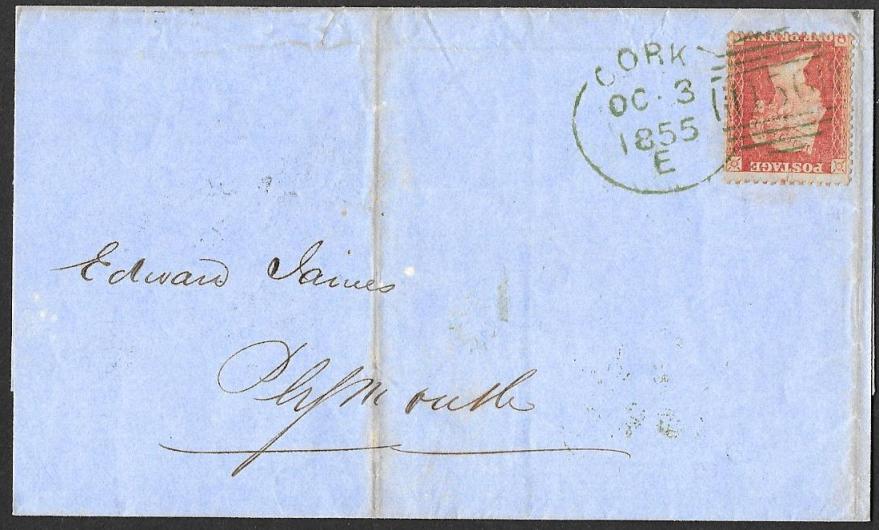
153970
A clean wrapper to Plymouth from Cork. a fine 1d star LC perf 14, 'QC'.
Tied by a very fine strike, neatly applied, of the CORK English type spoon in GREEN.
The scan does not do justice to the green ink.
The stamp appears to have been affixed over a pre-existing light crease in the wrapper
which does not affect the surface of the stamp.
Gibbons prices a green spoon, Spec vd.on cover at £1,500 in their latest QV Specialised Catalogue.
A very fine Display item and the best strike of this coloured spoon we have seen.
Price: £375.00
Dublin Special Cross
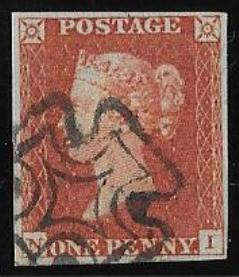
153947.
1d red Plate 19, 'NI' with constant variety Spec BS8e, illustrated by Gibbons.
A superb four margined example.
Dublin Cross priced by Gibbons at £125 on a non-variety stamp.
The MX leaves the variety clearly visible.
Exhibition quality.
Price: £75.00
Dublin Special Cross
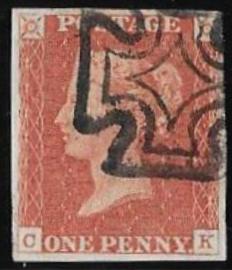
153946.
1d red Plate 37, 'CK', superb four margined example.
Plate 37 is a scarce stamp with an 'ordinary' MX but very scarce/rare with a Dublin Special MX:
the first such conbination we have seen or been able to offer.
Dublin Cross priced by Gibbons at £125 on an 'ordinary' plate.
Exhibition quality.
Price: £100.00
Lockerbie duplex used as a backstamp
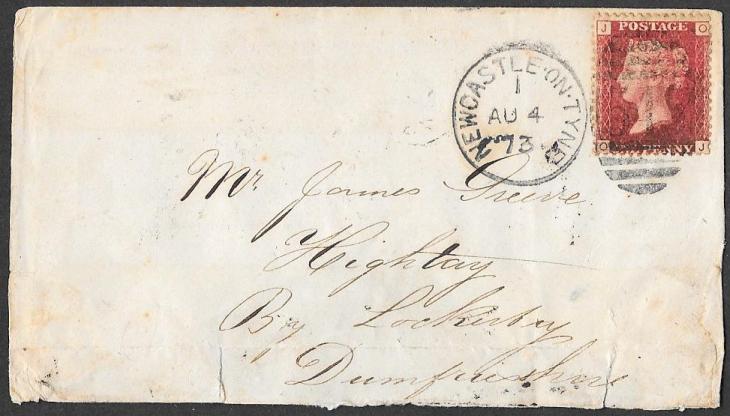

153943.
1d Plate 134, 'OJ', fine, tied to a white envelope, the browning is a trick of the scanner,
by a Newcastle duplex for August 4th 1873.
On the reverse is a Lockerbie duplex, '233', used as a receiving backstamp and is a very scarce usage.
The first such usage we have seen for a considerable time and not previously at Lockerbie.
Price: £35.00
Early printed Advert for sending Newspaper Publications in UK and to East and West Indies
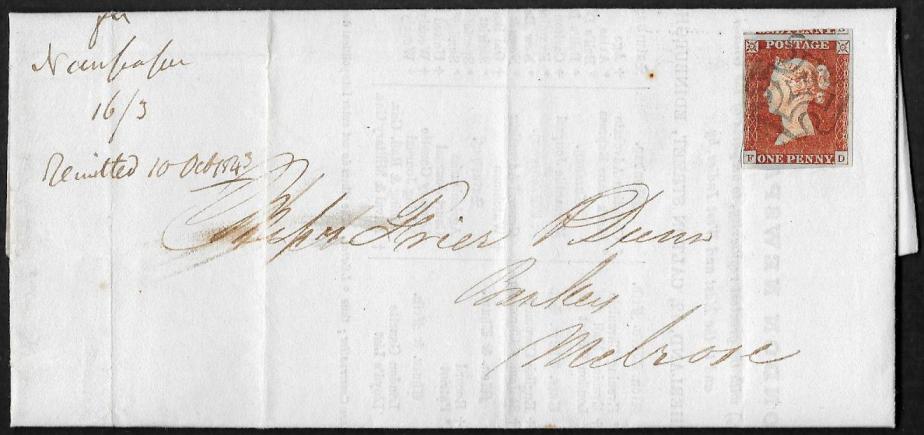

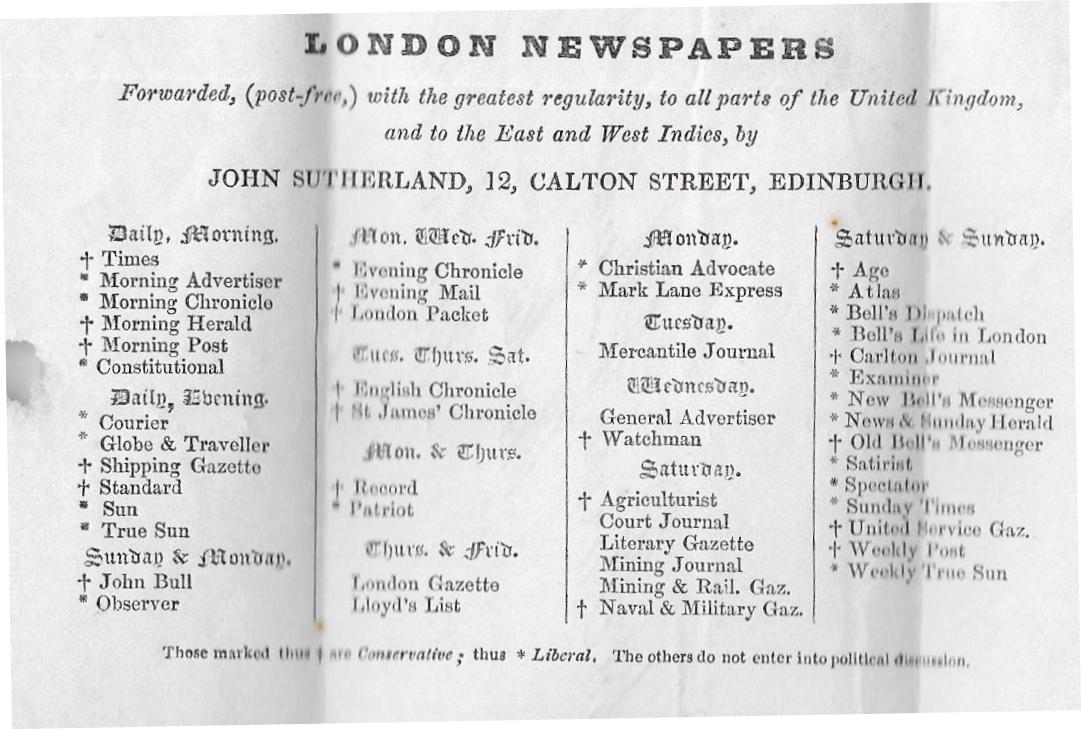
153670.
1d red, 'FD', fine Plate 28, virtually full margins but just touched at left, cancelled by a neatly applied EDINBURGH cross, on an
Invoice and Advertising list of the London newspapers and other publications that John Sutherland of Edinbugh,
a London Newspaper Agent, sent free of charge within the UK and to the East and West Indies.
This item sent to Melrose from Edinburgh, with an Edinburgh date stamp on the top flap for October 4th 1843.
An early example of such advertising.
Could be developed in to a very interesting Display page(s).
Price: £55.00
NB: 1d appears to be affixed over a light pre-crease with no disturbance on the stamp.
The 'Frying Pan' Surcharge mark of Glasgow
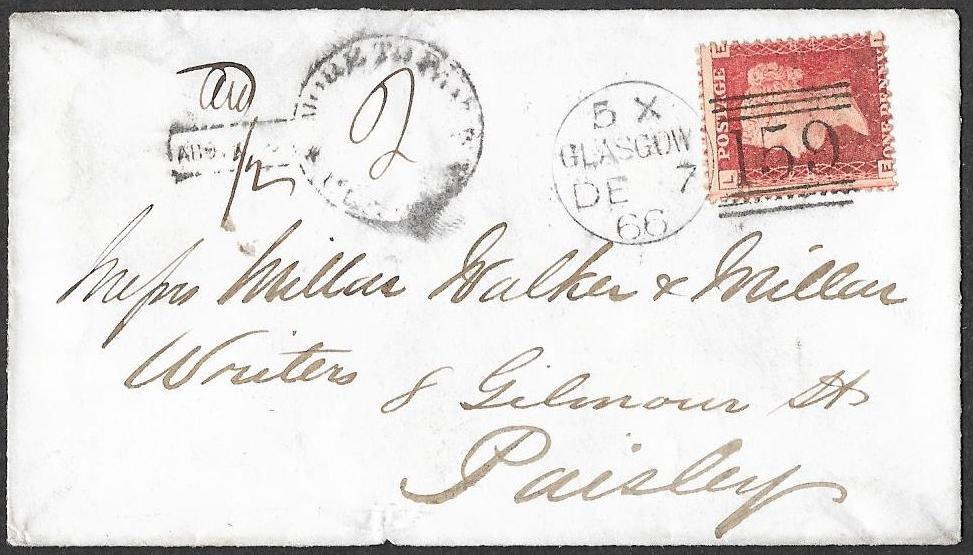
153675.
A fine envelope from GLASGOW to Paisley with a 1d plate 84 tied by a very fine duplex for December 7th 1866.
Neatly placed alongside is a strike of the Glasgow 'Above 1/2oz' with 'More to Pay Glasgow' around the top and bottom
with a hand inserted '2' in the centre being the 2d surcharge: the '1/2 oz ' has also being inserted by hand.
This is McKay Fig 718 in 'The Postal History of Glasgow'.
He comments that this was a cumbersum cancellation, not very practical and is consequently a scarce postmark.
The few examples we have seen were also not well struck.
The first example we have been able to offer for a considerable time.
Price: £70.00
NB: over the years collectors nicknamed this surcharge mark 'The Glasgow Frying Pan'.
Lesmahago to Hamilton
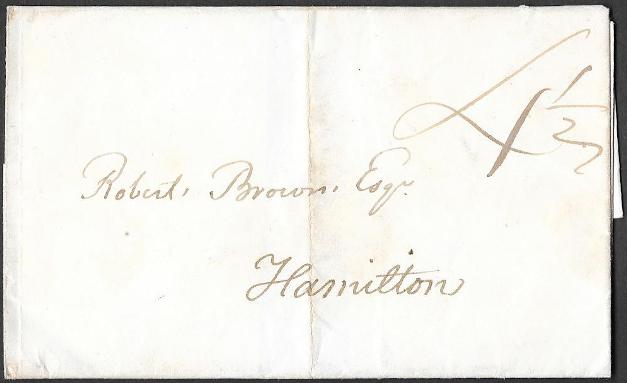
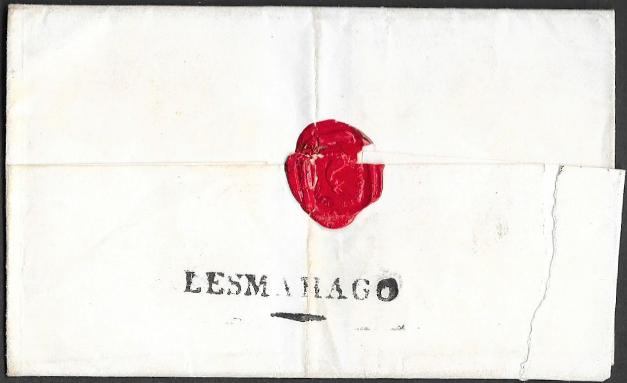
153926.
An undated wrapper from LESMAHAGO to Hamilton.
On the reverse is a variant strike of the Auckland LK194b, and on the front a ms '4 1/2'.
Lesmahago had an Additional 1/2 tax strike from 10/9/37 and Hamilton from 21/3/34.
An unusual item that displays the name when the rear flap is raised.
Price: £28.00
The next four items are examples, on entires, of the DUMFRIES Special Cross.
Believed to come from an original find and have not been previously on the open market.
Each is unrecorded by Rockoff and Jackson.
All are offered at a small fraction of the Gibbons price.
DUMFRIES Special Cross: this example unrecorded by Rockoff and Jackson
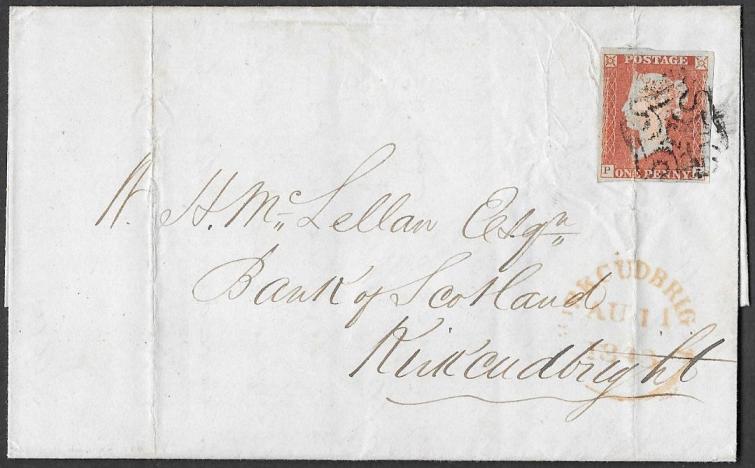
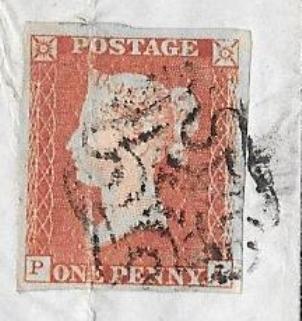
153906.
1d ‘PJ’, four margined, tied to an entire to Kirkcubright, by a fine/very fine strike of the characteristic DUMFRIES Cross.
Letter dated inside ‘Dumfries 10th August 1843’; the 1d is crossed by a filing crease.
The Special Dumfries Cross listed by Gibbons, SG Spec B1tf, and priced at £1,100 on full cover.
Rockoff and Jackson record and illustrate examples from June 1843.
On the reverse is a partial Dumfries boxed date stamp for August 11th 1843.
And on the front a Kirkudbright date stamp for August 11th 1843.
The example offered here is unrecorded by Rockoff and Jackson
and only three earlier examples are listed by them.
Price: £110.00
DUMFRIES Special Cross: an example unrecorded by Rockoff and Jackson
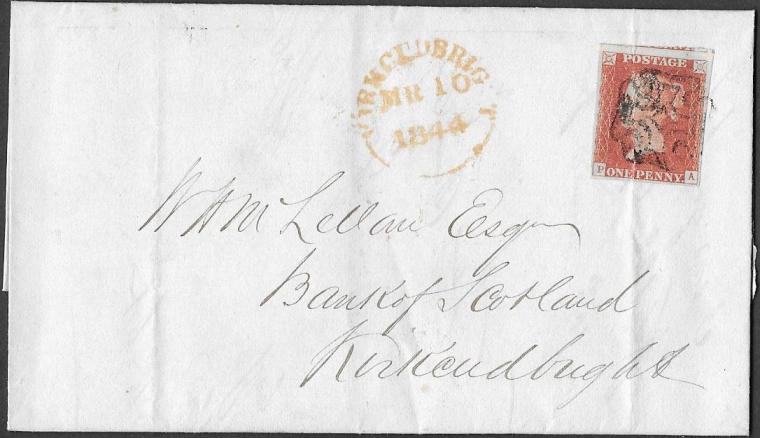
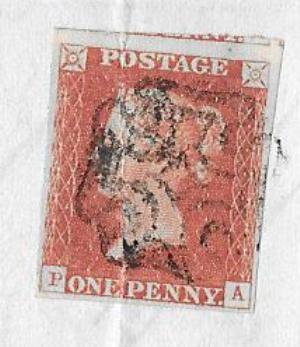
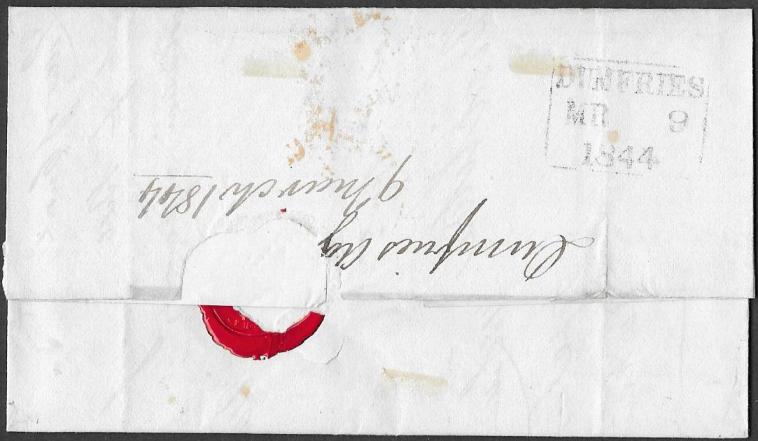
153907.
1d ‘PA’, four margined, tied to an entire to Kirkcubright, by a fine strike of the characteristic DUMFRIES Cross.
Letter dated inside ‘Dumfries March 10th 1844’; the 1d crossed by a filing crease.
The Special Dumfries Cross listed by Gibbons, SG Spec B1tf, and priced at £1,100 on full cover.
On the reverse is a Dumfries boxed date stamp for March 9th 1844.
And on the front a Kirkudbright date stamp for March 10th 1844.
This example in not recorded by Rockoff and Jackson.
Only three later examples are noted by them and none for March 1844.
As with the previous example, the ‘H’ in Kirkcudbright is missing.
The receiving Kirkcudbright date stamp is for a SUNDAY.
Price: £95.00
DUMFRIES Special Cross: example unrecorded by Rockoff and Jackson
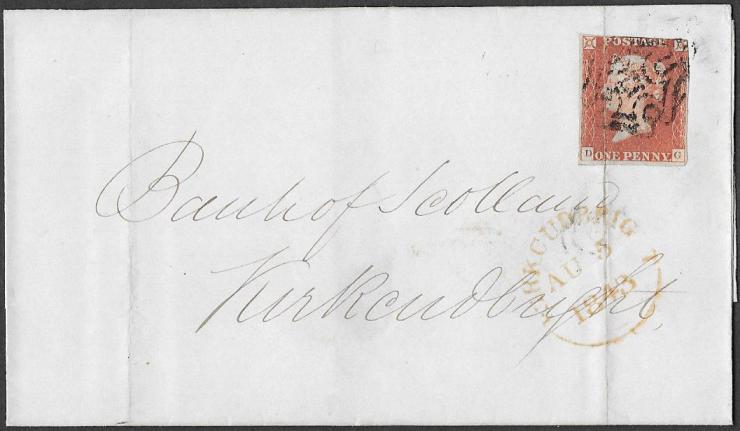
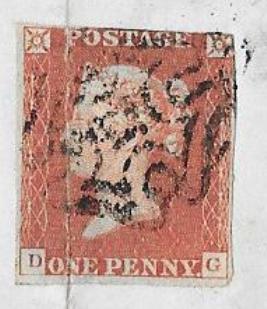
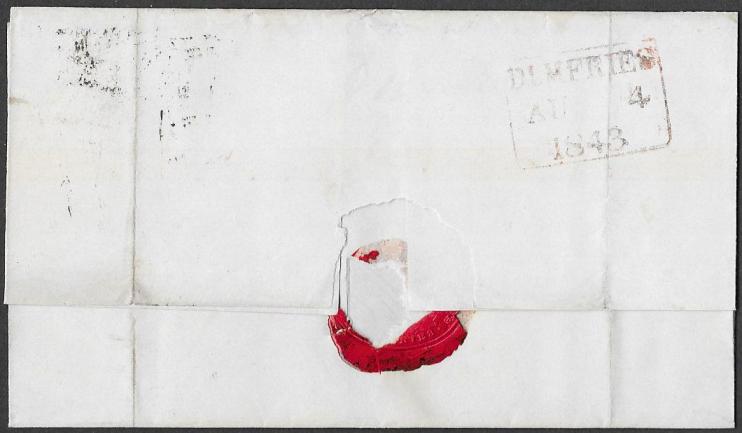
153908.
1d ‘DG’, three margined, on a wrapper to Kirkcudbright.
On the reverse is a Dumfries boxed date stamp for August 4th 1843.
The stamp crossed by a filing crease but is cancelled by the Special Dumfries Cross,
Gibbons, SG Spec B1tf, and priced at £1,100 on full cover.
The example offered here is not recorded by Rockoff and Jackson
and only three earlier examples are noted by them: see item 153906 above.
This Special Dumfries Cross listed by Gibbons, SG Spec B1tf, and priced at £1,100 on full cover.
As in the two previous examples listed above, the letter ‘H’ in the Kirkcudbright date stamp is missing.
Price: £70.00
DUMFRIES Special Cross a rare multiple usage.
This example unrecorded by Rockoff and Jackson: only one other pair listed by them.
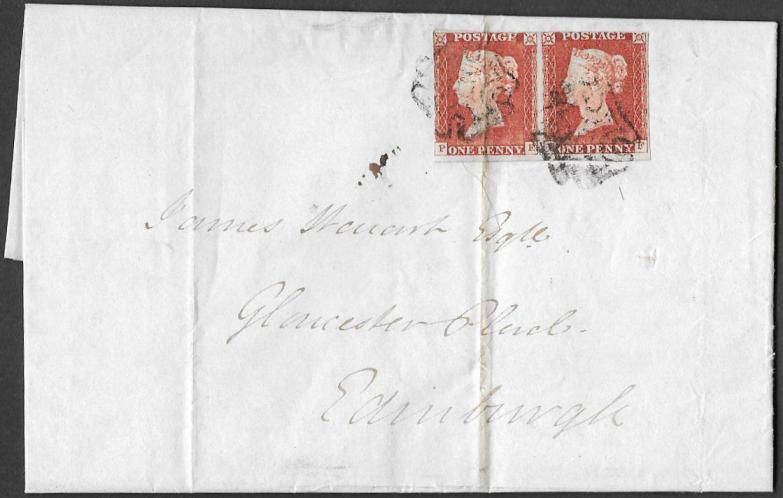
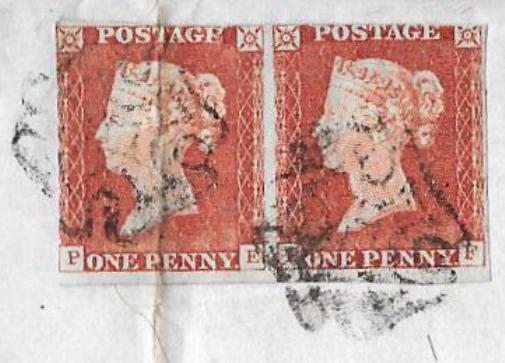
153909.
1d, ‘PE-PF’, a 2/3 margined pair on an entire letter to Edinburgh, dated April 27th 1844.
There is an Edinburgh date stamp for April 28th 1844 on reverse which overlaps with a Dumfries date stamp for April 27th 1844.
Both 1d’s tied by the Dumfries Special Cross, Gibbons, SG Spec B1tf, and priced at £1,100 on full cover for a single 1d.
Stamp ‘PE’ is crossed by a filing crease but stamp ‘PF’, 3-margined, is fine and uncreased.
This example is unrecorded by Rockoff and Jackson and none for a usage in April 1844.
They list only three later usages of this cross and only ONE other usage on a 1d PAIR.
Multiple usages of this characteristic cross are rarely found.
Price: £135.00
Rare late usage of SG198 on transatlantic mail and posted on board SS Caledonia
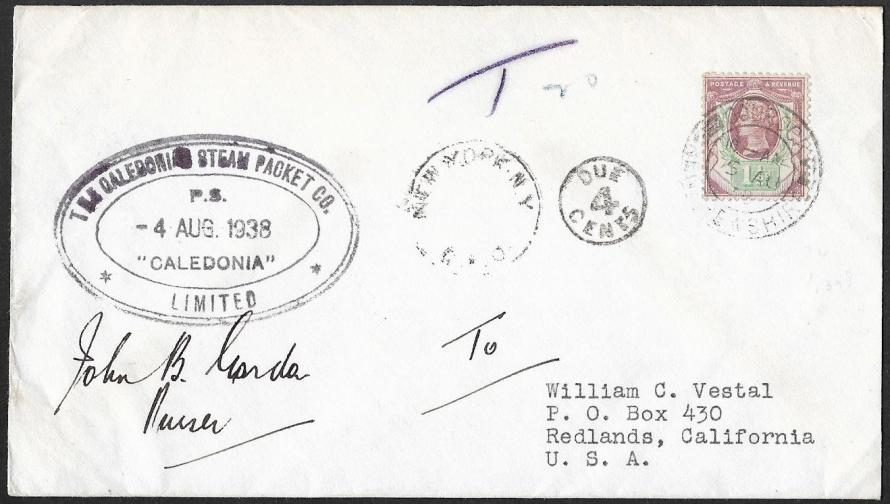
153904
A clean envelope from Gourock to California, August 4th 1938 and posted on board SS Caledonian
of The Caledonian Steam Packet Company 'Caledonian' with a fine strike of its scarce cachet.
The postage has been 'paid' by a 'QV Jubilee' issue threehalf pence, SG198.
This stamp was demonitised in June 1915 and is the latest usage we have seen of this stamp.
The signature bottom left is of the Purser, John B Gordon.
On receipt in New York it was surcharged Due 4 Cents.
There are no markings on the reverse.
A rare item which would display well.
Price: £45.00
TWO Christmas Day, SUNDAY, Cancellations 1853
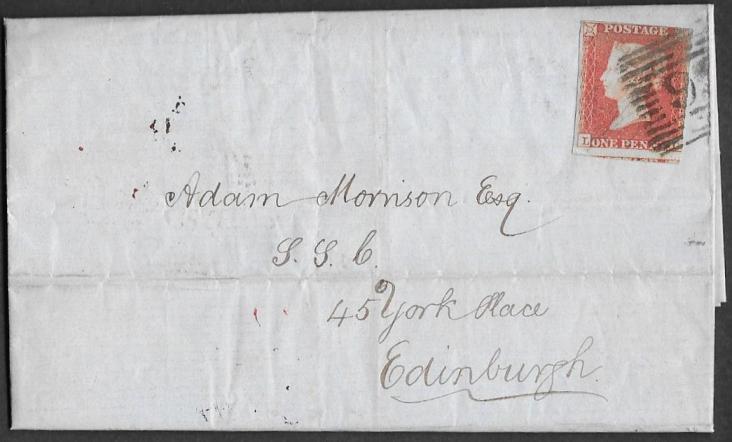
153676.
1d Red, 'LG', Plate 174?, QV clear profle, tied by a partial CUPAR FIFE numeral, to a legal entire to Edinburgh: Letter dated December 24th 1853.
On the reverse top flap are TWO Christmas Day date stamps: Cupar Fife Dec 1853 and Edinburgh receiver for the same date.
Very scarce to find an item which has two different Chrtistmas Day cancellations.
The rarity of this item is considerably enhanced as Dec 25 1853 was a SUNDAY and this example
is the only multiple Christmas Day SUNDAY Cancellations we have seen during the period 1840-1901.
An Exhibition item.
Price: £45.00 SOLD
2d Plate 6 a single Maybole numeral Contrary to PO Regulations
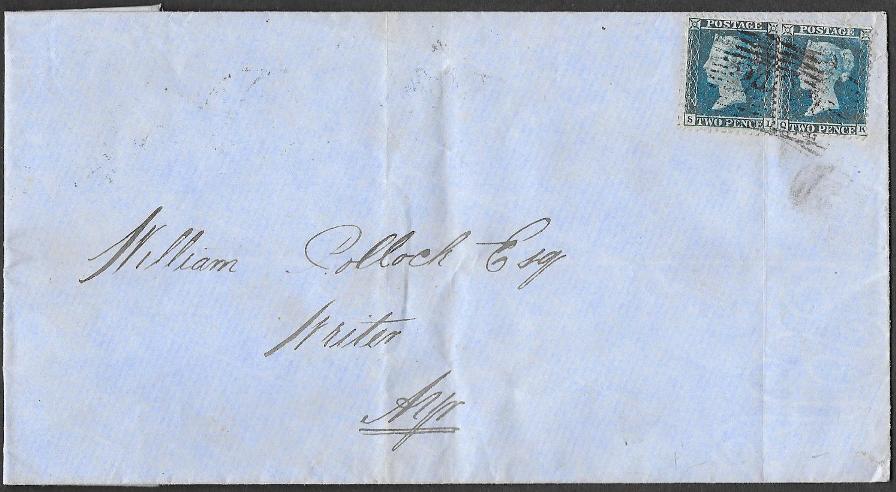
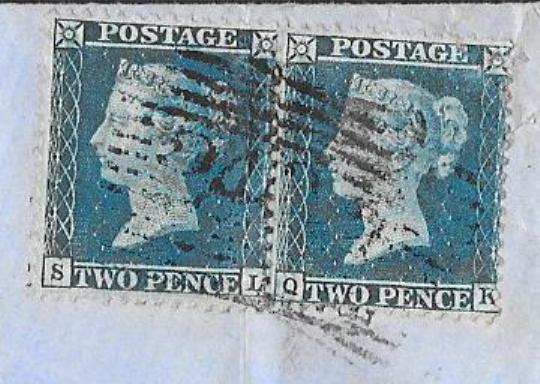
153902
2d, SG35 plate 6, 'SL and QK': two singles,
'SL' affected by a vertical filing crease but not visible from the front.
Affixed to an envelope from MATBOLE to Ayr by a SINGLE strike of the '243' of Maybole.
For display purposes the envelope has been folded at the left.
The single '243' is Contrary to PO Regulations at that time.
A single of this Plate 6 is priced by Gibbons at £200 on cover.
On the reverse are cds's for Maybole September 21st and for Ayr September 22 1858.
A very collectable example of a single numeral cancel on 2d's on cover.
Price: £45.00
A scarce Single usage of three halfpenny SG51/2
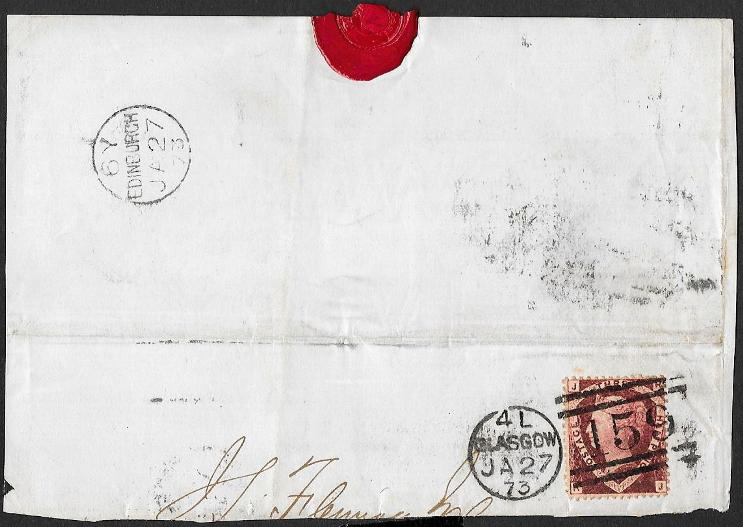
153890.
Three half penny, SG51/52, 'RJ', fine, Plate 1,
tied to a dated piece by a very fine Glasgow duplex for January 27th 1873 with a same Edinburg date.
The stamp shows the 'oxidation' effects of the contemporary atmospheric pollution.
The scarcer Plate 1 is priced by Gibbons at £110 on stamp
and £275 on cover for the less scarce Plate 3.
Single usage of this stamp is scarce.
Displays well.
Price: £40.00
Cancelled Contrary to Regulations
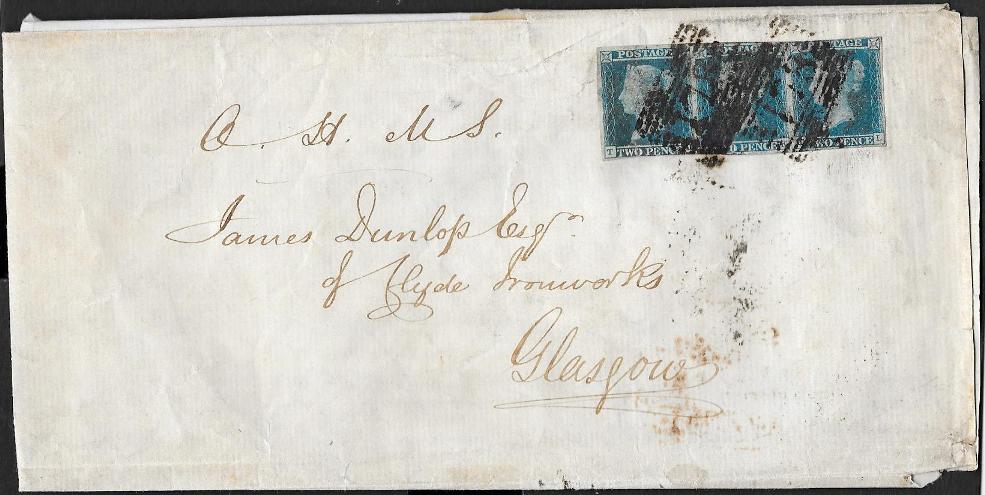
153889
2d Plate 3, 'Tj-TL', tied to an envelope, folded at left for display purposes,
by two strikes of the HAMILTON '173' and cancelled Contrary to Post Office Regulations.
On the reverse are boxed May 13th 1846 date stamps for Hamilton, a partial boxed Glasgow Receiver for May 14th 7: 30 AM.
and a full complete red wax seal with LANARKSHIRE in a shield.
'TJ' has a fault at the bottom and the strip is not full-margined
but a scarce collectable example of the 6d rate with only two cancellations.
Price: £58.00
1d Plate 83: listed and illustrated re-entry variety on cover, Spec BS72a
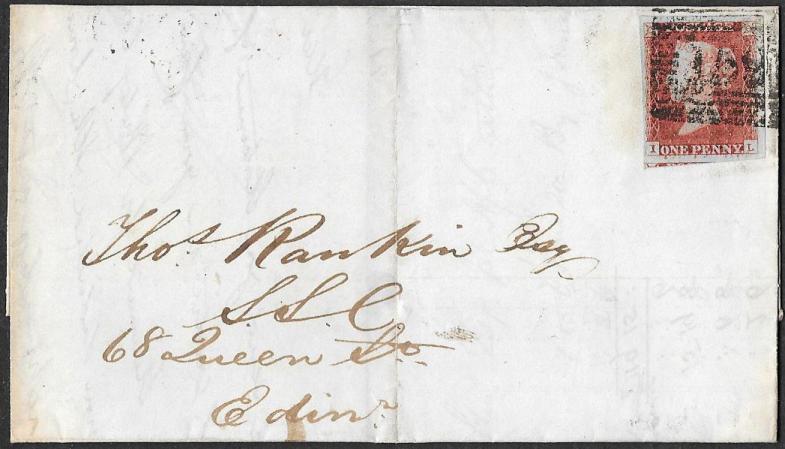
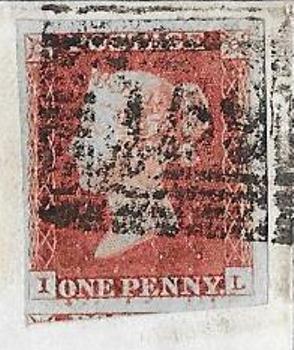
153852.
1d Plate 83, ‘IL’ with very large margins and a portion of the stamp beneath.
There is a very light and small ‘scratch ‘in the margin at the side of the ‘L’ square.
The numeral, '159’ of Glasgow ties the stamp on a clean wrapper to Edinburgh.
On the reverse is a date stamp of Edinburgh, June 27th 1849,
and a partial strike of the Queen Street (Edinburgh) Scots Local.
The ‘159’ of Glasgow is well clear of the bottom margin in which are the re-entry marks,
listed and illustrated by SG, on page 214/215 in the latest Line Engraved Volume I Specialised Catalogue.
The variety is SG Spec BS72a.
Gibbons prices this on stamp off cover at £100 which in our experience is much underpriced.
We have previously been able
to offer only one other example of a re-entry on Plate 83 ie on stamp only
The item here is the first example we have been able to offer on cover, or can recall seeing on cover.
An exceptional and rare item of Exhibition quality.
Price: £110.00
4d Plate 7: strip of three used in Ireland: with a duplex and separate numeral cancels

153743.
4d SG93, Plate 7, HD-HF’: a wing margined strip of three on a flimsy envelope to Rome from Dublin.
The left stamp is cancelled by the full Dublin duplex for April 19th 1865:
the year plug is an error as Plate 7 was issued on July 4th 1865.
The AMB ANGL CALAIS AVRL 21st 1866 confirms the error.
The other two 4d’s are cancelled by the ‘186’ numeral of Dublin and not the duplex:
separate canceller and very unusual as such.
The flimsiness of the envelope was the reason for the damage to the envelope at the right side and reverse flap.
A single Plate 7 on cover priced by Gibbons at £240 and the third rarest plate of the series plates 7-14.
Very scarce to find a multiple of Plate 7 on cover and we have seen only a few examples
of a multiple surface printed issue on cover with both duplex and single numeral cancellations.
Price: £95.00
Stirling Experimental Duplex with Sunday Dates
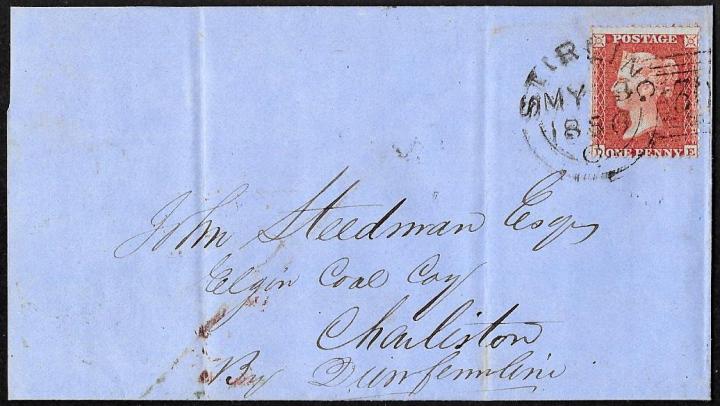
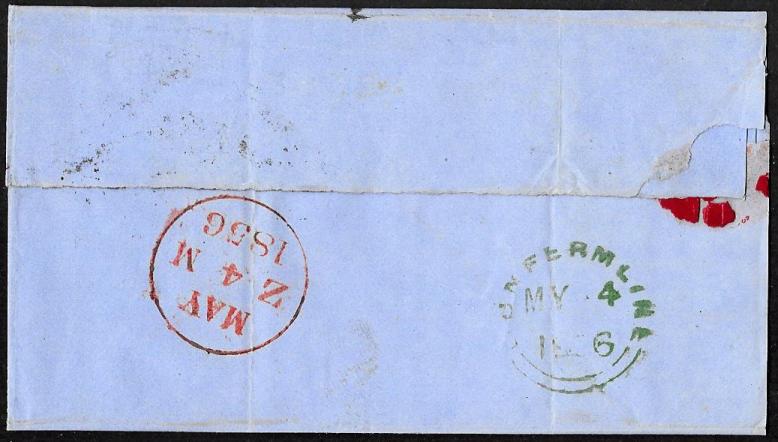
153733.
Fine 1d star, ‘DE’, perf 14: tied to a commercial entire by a STIRLING Experimental duplex for May 3rd 1856.
On the reverse are two transit date stamps, one from Dunfermline, both dated May 4th 1856 – both are SUNDAY dates.
The SPHG place this duplex as the 10th out of 18 types in its rarity.
Our experience rates it as more like 12th or 13th in their rarity table.
A fine and very scarce item especially with two Sunday transit dates.
Price: £47.00
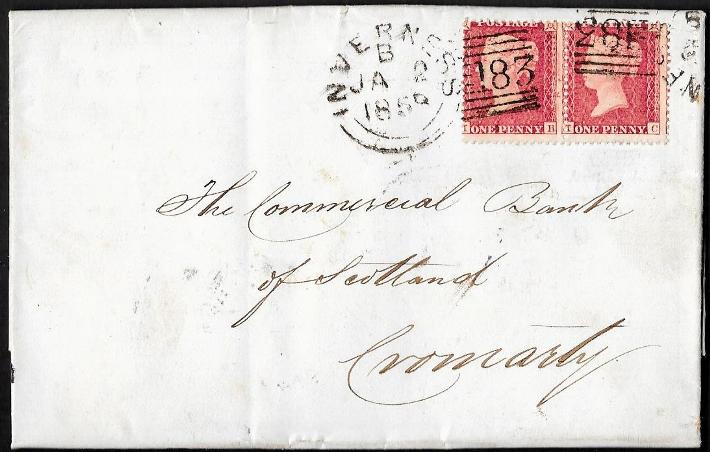
153734.
A fine pair of 1d stars, ‘TB-TC’, perf 14: tied to a letter from The Bank of Scotland in Inverness to Cromarty.
Both tied by either a full part of a scond Type 2 Inverness Experimental Duplex for January 2nd 1858.
On the reverse is a clear Cromarty date stamp for January 3rd 1858.
The SPHG in their rarity table note this as 12th rarest of the 18 Experimental Duplexes known.
Price: £38.00
First type of the WHITEHAVEN Sorting Tender date stamp
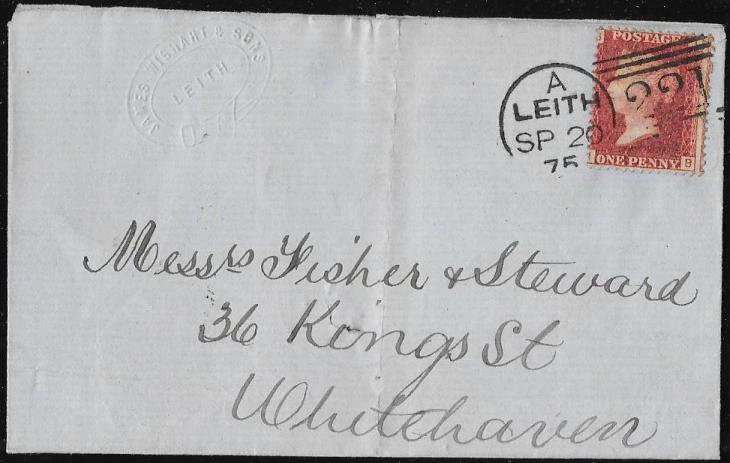
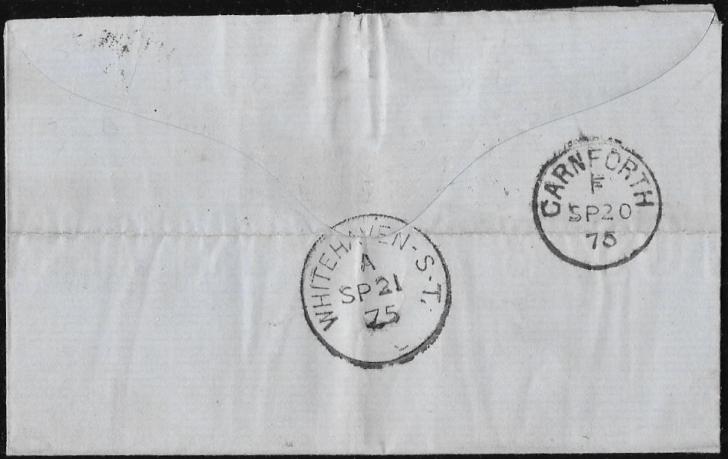
153720.
A fine/very fine 1d Plate 169, tied by a Leith duplex for September 20th 1875,
on a commercial headed letter from Leith to Whitehaven.
On the reverse is a very fine strike of the first type of WHITEHAVEN SORTING TENDER, September 21st 1875.
This cancellation is illustrated by Wilson, figure 160, in Part 1of the publication on TPO’s by the Railway Philatelic Group.
This first Type issued was sent to Carnforth on February 25th 1875.
The example offered here is the earliest usage we have seen and during its first six months of usage.
Also on the reverse is a Carnforth cds, struck away from the Sorting Tender cds, for September 20th 1875.
This scarce item would make a fine display page.
Price: £38.00
Rare usage of a numeral used in error as a backstamp and corrected


153658.
1d SG40, neatly tied to a clean envelope to Paisley by a very fine Glasgow duplex for February 19th 1861.
On receipt in Paisley it was struck on the reverse, in error, by the numeral '277' of Paisley.
This mistake was corrected by being overstruck correctly with a Paisley receiving date stamp for February 19th 1861.
The item was held back until the following day for delivery.
Possibly it was received in Paisley on February 19th too late for delivery.
Hence the Paisley date stamp for February 20th 1861.
We have been able to offer over the years few examples of a numeral used as a backstamp
but this is the first where the incorrect usage was corrected.
A very fine rare item which displays well.
Price: £55.00
There are more Dotted Cricles, including Greenock and Edinburgh Types, to be found lower down this Section.
U4d Post: rare place of usage


153653
Entire from TURIFF to Aberdeen dated December 20th 1839.
A rare usage during the Uniform 4d Post Period from Turiff
that had a population of only around 1,000.
One asks the question how few of these inhabitants could write?
The only example we can recall seeing of mail from Turiff during the short lived U4d Post.
Price: £45.00
Newtown-Limavady Cross

153625.
1d Plate 26, 'BD', fine with almost full margins, just shaved top of NE corner.
Tied to a commercial letterto Ballymoney by a very fine MX of Newtown-Limavady.
On the top flap is a very fine date stamp for April 24th 1843 which displays well.
Rockoff and Jackson, Volume 2 record and illustrate only six examples on cover of this cross:
only five of these are on a 1d red: he example offered here is not one of them.
An attractive and scarce item which would make a fine display item.
Price: £65.00 SOLD
Newtown-Limavady Cross


153627.
1d Plate 36, 'TE', a fine/very fine with full margins, just tied,
by a superb Newtown-Limavady Cross to a commercial letter to Ballymoney.
On the reverse top flap is a fine Newtown-Limavady date stamp for September 26th 1843.
Rockoff and Jackson, Volume 2 record and illustrate only six examples on cover of this cross:
only five of these are on a 1d red: the example offered here is not one of them.
A very scarce display item which displays well.
Price: £85.00
NB: the population of Newtown-Limavady at that time was around only 2,500.
1d Plate 21: NEWTON-LIMAVADY cross

151749. 1d red plate 21, 'EF', fine 4-margined, close at 'F' square but clear:
tied to a clean banking entire from NEWTON-LIMAVADY to Ballymoney.
On the reverse is a blue cds of Newton-Limavady for March 6th 1843
and a superb COMPLETE red wax seal 'Belfast Bank Branch N.Limavady'.
Rockoff in Volume 2 page 210, 'The Maltese Cross Cancellations of GB and Ireland',
illustrates only six examples on cover of this cross.
A late strike, May 30th 1844, shows a cross with an empty centre.
The authors speculate as to whether this is a weakened centre or a result of inking.
This example, March 6th 1843, shows a similar empty centre.
The later examples in 1843, August and December, are complete strikes with the usual diamond in the centre.
Hence the example offered here confirms the empty centres are a consequence of inking.
An attractive and very scarce item.
Price: £75.00 SOLD
Magherafelt Cross

153628
1d Plate 21, 'HD', fine with full margins, tied to an entire by a very scarce
Magherafelt Cross: the population was only around 1,500.
On the reverse top flap is a Magherafelt date stamp for September 3rd 1842.
Rockoff and Jackson record seven examples of this cross: this is not one of them.
A very scarce item which displays well.
Price: £75.00
LARNE Coss


153629
1d 'OA', fine full margined, close at NE square but clear.
Tied to an entire from LARNE to Belfast by a Larne cross for January 28th 1842.
Rockoff and Jackson, Volume 1, record only two examples of this cross and these are for July 1843 and March 1844.
The example offered here is some 18 months earlier.
The population of Larne was around 2,600.
A very scarce item.
Price: £75.00
Dungannon Cross: unrecorded by Rockoff and Jackson


153630
1d Pink embossed envelope, with an original letter content, cancelled by a superb Dungannon cross:
unrecorded by Rockoff and Jackson.
On the reverse are Dungannon date stamps for March 11th 1843 (Saturday) and March 12th 1843 a SUNDAY.
There is a Belfast receiver for March 13th 1843.
It would seem that the item of mail was probably received late on March 11th and then sent on on Sunday March 12th
being received in Belfast the following day, (Monday).
A superb strike of the cross particularly on an embossed envelope.
A rare combination of features.
Price: £80.00
First type of Belfast Cross to Scotland: late usage


153631
1d Plate 23, 'RB', fine with full margins: close but clear at the right.
Tied to a wrapper to Kirkcaldy from Belfast.
On the reverse are fine strikes for Belfast, May 5th 1842, Edinburgh date stamp for May 7th 1842
and a Kikcaldy receiver in red for the same day.
Rockoff and Jackson record the latest Belfast Type 1 Cross as May 21st 1842
so the example offered here is close to the latest recorded usage.
A display item.
Price: £60.00
Early usage of a Scots Local

Rockoff and Jackson, Volume 2 record and illustrate only six examples on cover of this cross:
only five of these are on a 1d red: he example offered here is not one of them.
153586.
1d SG17, ‘GI’, fine used.
Tied to an undated letter from Glasgow to Manchester by a Queens Street Scots Local type XV111.
With the rear flap raised, the m/s date for December 22nd 1854 is clearly seen.
Alcock records the earliest date of usage for Queens Street as November 30th 1854.
Any December 1854 date is rarely found for a Scots Local Cancellations
as the official start of their usage was October 28th 1854.
A very scarce/rare.
Price: £50.00
Glasgow Sorting Tender: the 'cloth' variety



153588.
1d plate 163, tied to an envelope by a London WC duplex. WC/29 for January 13th 1877.
The envelope has some clear tape affixed at the top left.
On the reverse is a Glasgow Sorting Tender for January 14th 1877 and a Parkhead cds for the following day.
The Sorting Tender is Wilson figure 719/20/2: a series of similar types first introduced in March 1876.
Over their long period of usage,1876-1904, the stamps were recut or replaced several times.
On occasion, some form of a machine with a self-inking ribbon seems to have been used giving the so-called ‘cloth’ stamps.
The circle and letterings are in fine lines instead of sold ink: the enlarged scan shows this clearly.
This is the first time we have been able to offer this variety on any Sorting Tender cancellation.
From our researches we have been unable to trace another example.
A rare/very rare item and likely to be the earliest known example of a ‘cloth’ stamp.
Price: £65.00
NB: one suggestion for the use of a machine ribbon was to reduce
the wear of the canceller and therefore extend its life.
Dumfries Distinctive Cross: an early usage



153059.
1d plate 29, ‘RD’, good margins but tight and just clear at the right.
Tied by a distinctive DUMFRIES Cross, lightly struck as is often the case.
An entire dated Dumfries 13th September 1843 to Moffat.
On the reverse top flap are date stamps of Dumfries, lightly struck, for September 13th
and a Moffat for the following day: the year plugs are reading ‘3184’.
Gibbons prices the Dumfries distinctive cross, Spec BItj at £1,100 on cover.
Rockoff and Jackson, Volume 1, list only five earlier dated examples on cover than the one offered here
which is not listed by them.
A fine display item.
Price: £225.00
Dundee dotted circle: unrecorded usage on this 2d Plate number

152536v:
2d Plate 9, ‘SC’, some wrinkling in the NE letter square, tied to a wrapper
by a DUNDEE Type A1 dotted circle for September 5th 1865.
Addressed to a Captain Duncan in Kingston, by Fochabers, and sent by Book Post .
Very unusually the stamp is tied by a double strike of this cancellation which leaves a clear profile.
This 2d plate is not recorded by Arundel with Type A1.
On the reverse is a fine strike of a Ferryport on Craig date stamp for September 5th 1865.
A ferry port for across the Tay: It was closed on June 21st 1870 and renamed Tayport.
There is a lot of info on the internet about this location.
A rare combination of features and an interesting display item.
Price: £85.00
Blue Edinburgh Duplex

SOLD
Athboy: an Irish Blue Cross


152823.
1d red Plate 36, 'NG', full margins, some ragged perfs but clear of the design.
Large dated piece, top part front and back, from ATHBOY to Bath?
The 1d is tied by a lightly struck BLUE cross.
On the reverse is an Athboy date stamp for Febuary 19th 1844 in the same shade of blue ink as
the Athboy Penny Post and the Maltese Cross.
The Athboy MX in blue is unrecorded by Danzig.
Gibbons prices a 1d red with a blue cross on full cover at £1,700 and on stamp alone at £650.
A very rare combination of features and an attractive Irish item item that displays well.
Price: £465.00
NB: the scans do not do justice to the blue ink.
Part inscriptional and Dublin Cross


153579.
1d red, 'ML' ,ragged margins at top and bottom with part marginal inscription,
'In Wetting the (back be careful not to remove the cement)'.
Tied to a wrapper from Belfast to Doneraile, December 6th 1841,
by a very fine strike of the First Type of Belfast Cross.
The 1d affixed sideways, results in the marginal inscription being horizontal.
A scarce item.
Price: £40.00
1/2d Plate 12 with a superb Glasgow NPB on an Invoice


153534.
1/2 Plate 12, 'QG', tied by
an exceptional Glasgow Newspaper Branch for May 15th 1879,
to a printed invoice from a Seed Merchant.
There is a hand written note at the bottom 'P Rail to Inches Station'.
The 1/2d has a some very minor wrinkling caused it would seem
from being affixed over a pre existing fold in the invoice.
This type of NPB is scarce on cover and rare with such a superb strike.
On the reverse top flap are very fine/superb cds's of Lanark and Douglas for May 15th 1879
which display well when the top flap is raised.
An attactive and rare item which displays well.
Price: £50.00
NB: there are more usages og the bantam 1/2d, on and off cover, further down this Section.
Trio of Coleraine Penny Paid: different types and colour

153518.
A trio of items showing different types and colours of Coleraine Paid cancellations.
On the reverse are Coleraine Date stamps in the same
colour of ink as the Paid cancellations on the front.
All are addressed to the same person at the Belfast Bank branch in Ballymony.
The green strike is on a wrapper and the other two items on entires.
The green P.D/C.Raine is dated April 17th 1848; the similar blue strike is dated October 3rd 1846.
The boxed Paid/at Coleraine in green has a date on reverse of May 9th 1845.
The Green P.D/C.Raine is recorded used between 1845 and 1848
the example offered here at April 17th 1848 is hence the last year of its recorded usage.
The last such example we have noted was offered by Gibbons in 2002 at £70, and dated February 9th 1846.
An attractive trio which would make a fine display page.
Price: £110.00
DUNDEE 1739 entire



SS2.
1739 January 23:
Fine two page
letter to
Postal charge of ‘2’ on front for a letter carried up to 50 miles.
On
the reverse a very fine strike of ‘
Aukland records the earliest known date for this first type
of
so this example pre-dates by 6 months.
Very scarce/rare entire.
Price: £125.00 SOLD
DUNDEE February 1760


153312.
Entire to Edinburgh from DUNDEE, dated February 1760.
An interesting address and it appears to be a charge of 6d postage in m/s.
On the reverse is a superb DUNDEE, Auckland AN86, Type S1,
recorded in use between June 25th 1759 and August 22nd 1761.
This is the second Type of single line Dundee.
A very scarce/rare strike so superbly struck.
Price: £65.00
NB: the condition of the item is finer than in the scan.
There is much less browning and cleaner than the scan suggests.
1d Plate 17 multiples with Dumfries Crosses

153398.
Wrapper from DUMFRIES to Edinburgh, April 7th 1842.
The 6d franking is made up of a pair and a strip of four: all from Plate 17 and in the distinctive shade for this Plate.
The pair, ‘RK-RL’ show the listed variety, SGSpec BS6d, and in the strip of four, ‘QI-QL’, ‘QI’ also shows this variety.
A filing crease affects ‘QJ’; the watermark on each stamp is near the bottom.
The pair has full margins as has the strip of four except for ‘QL’.
The stamps are cancelled by the Dumfries Common Cross both noted and illustrated by Rockoff and Jackson in Volume 1;
used from May 10th 1840 to February 13th 1843: no multiple usage of this cross is listed.
Gibbons prices a single of Palte 17 on cover at £225, a pair not on cover at £300
and hence an estimated price on cover of a pair at £500.
A rare item and the largest multiple franking of Plate 17 on cover we have seen.
The canceller needed cleaning hence the impressions show dirt build up.
A fine Display item that could be paired with 153397
making a remarkable and unique pair of covers sent to the same addressee.
Price: £265.00
Plate 21: four singles and a pair with distinctive DUMFRIES crosses on varieties


153397.
Wrapper from DUMFRIES to Edinburgh, June 30th 1843, franked by four singles and a pair from Plate 21.
None are full margins and crossed by a filing crease as seen in the scan.
However, ‘ML’shows clearly the ‘M over K double letter and basal shift’, SG SpecBS10c,
illustrated by Gibbons in QV Volume 1 and priced at £250 on stamp alone: no price given for on cover.
Sadly this stamp is heavily defective.
The six stamps are cancelled by five strikes of the distinctive Dumfries Cross: SG Spec B1tj
and priced by Gibbons at £1,100 for a single on cover.
The quality of the strikes allows the characteristics to be seen.
Rockoff and Jackson Volume 1, record only 15 examples of this distinctive cross on 1d red covers.
The only multiple usage recorded by them is on one cover with a pair of 1d reds.
The EKD they note for this distinctive cross is June 17th 1843 and the only other June 1843 date is for June 19th 1843.
The example offered here at June 30th 1843 is one of the earliest known and the earliest multiple usage.
Despite the faults and lack of margins this is a remarkable item and more than likely unique with such a variety of features.
We have never seen the ‘M over K’ variety on cover.
It would make an interesting Display page.
Apart from Item 15150 in this Section, this is the largest multiple usage of any distinctive and listed cross we have seen.
Price: £295.00
NB: This item and 153398 would make a unique pairing
and is offered at a discounted price of £495.00.
DUNBAR: July 1762


153311.
Large part entire with a part letter from Otterburn, dated July 17th 1762, to Edinburgh.
On the reverse is a fine strike of DUNBAR, Auckland EL3:
the first type of single line name strike for this location.
In the top front left corner is a m/s '2' crossed out and changed to a '4':
apparently a change of the postage charge to 4d.
There is a part of the rear flap missing not affecting the name strike.
A small neat item.
Price: £42.00
1d pair cancelled by a single Glasgow numeral.

153435.
1d pair, 'SK-SL', 'SK' full margins, 'SL' three margins.
The margins are rather wragged
but the stamps are cancelled by a superb SINGLE '159' of Glasgow.
This single strike was Contrary to Post Office Regulations at the time.
Price: £30.00
2d Plate 3: Edinburgh Special Balloon Cross and other varieties


153502.
2d Plate 3, 'EK', full margins and part of the adjacent stamp at the right and a burr rub in the left margin.
Cancelled by an exceptional strike of a Balloon Cross of Edinburgh.
Rockoff and Jackson in Volume 1 have an analysis, with illustrations, of these crosses.
The example offered here is Type 4 which they illustrate and describe it as
'the most elegant and distinctive of the Edinburgh Special Crosses'.
It has been recorded in use between December 29th 1842 and September 9th 1843.
The stamp is printed on unlisted Thin Paper on Plate 3 but listed on Plate 4 at £225 ie with a numeral cancel.
Stamp 'EK' is listed as SG Spec ES11d: 'Shifted transfer, distorted white letters of the value and basal duplication'.
This might explain the burr rub and the basal markings.
On the reverse near where the burr rub is located on the front, there are some markings, and in the corner as per the scan.
Nothing shows on the front of the stamp.
Gibbons prices an Edinburgh cross on stamp at £350.
With the other varieties and the quality of the cross, the combination of features is likely to be unique.
An Exhibition quality.
Price: £185.00
1d imperf sent from Scotland to Europe

153510.
1d imperf, Plate 85, 'AH',
tied to a part front and back, by the '159' of Glasgow.
The 1d, not full margined, shows plate wear.
On the reverse top flap is a fine set of transit marks
including 'QUEEN STREET', a partial double strike, and a Glasgow date for January 23rd 1850.
On the front is a surcharge '8'.
A very scarce usage of the 1d imperf on an item from Scotland going to an overseas destination,
It displays well.
Price: £35.00
Queen Street Scots Local in Black and Blue

153428.
Queen Street Scots Local, Type XV111 on pieces:
The Black example is struck on a 1d perf 16, and the Blue example on piece on a 1d perf 14.
Gibbons prices a Scots Local in black on piece at £40 and in Blue at £110.
BUT they note in SG Line Engraved, Volume 1 2020, that the blue price is for 'Neilston' in blue
and other Offices in blue are generally worth considerably more.
This is the first example of Queen Street in blue we have seen and able to offer.
An attractive, and rare pair, which would make a fine display item.
Price: £75.00 SOLD
Dundee Dotted Circles used as a backstamp


153504.
1d Plate 73, fine, 'RF':
tied to an envelope from Edinburgh to Dundee, August 3rd 1866.
On the reverse is a strike of the Dundee Dotted Circle Type A1
used as a receiving backstamp for August 4th 1866.
This is the first example we have been able to offer or indeed have seen.
A rarity.
Price: £55.00 SOLD
NB: there is some browning but fainter than in the scan.
1d perf 14 misperffed showing parts of three other stamps


153430.
1d perf 14, badly misperffed showing parts of thee other stamps.
Tied to a clean envelope to Edinburgh, vertical filing crease clear of the stamp and the cancellation.
Superb Glasgow duplex for December 5th 1862.
On the reverse is a fine embossed crested insignia of a Glasgow solicitors
that could probably be researched for writing up the item.
An attractive item that would display well.
Price: £45.00
1/2d Plate 3 from DUMFRIES

153353.
1/2d Plate 3, fine vertical pair:
tied to a clean envelope to Edinburgh, a couple of small peripheral faults at the top,
by Dumfries duplexes for April 1st 1873.
Edinburgh receiver on the reverse for the following day.
Gibbons prices a single Plate 3 on cover at £125 and on stamp only at £55.
Price: £45.00
1/2d SG48: Plate 4

153452.
1/2d SG48 Plate 4, 'FV-GW':
very fine lightly used block of four with rich colour.
Montrose duplex cancels for November 15th 1872.
A difficult Plate to find in a block and in this condition.
Gibbons prices a used block of four in the cheapest plate at £200.
An estimated price for this block is £330.
A rare/very scarce item.
Price: £75.00
1/2d Plate 4 from DUMFRIES

153355.
1/2d Plate 4, fine vertical pair:
tied to a clean envelope, a light horizontal crease which crosses the stamps but is not visible on them.
The Dumfries Duplexes, February 24tt 1873, are neatly applied and there is a
very fine Edinburgh receiver on the reverse for the following day.
A single Plate 4 on cover priced by Gibbons at £115 and on stamp only at £50.
An attractive item.
Price: £35.00
1/2d Plate 4 from LOCKERBIE


153357.
1/2d Plate 4, vertical pair lightly cancelled.
Tied only by the bars of a single Lockerbie duplex, February 4th 1873: Contrary to Post Office Regulations.
A clean envelope with a light horizontal crease that crosses the top stamp but is not visible on the front of the stamp.
On the reverse is a very fine strike of the Edinburgh Travelling Post Office,
Wilson figure 691, for February 5th
1873: its last year of recorded usage.
An interesting
combination of usage and cancellations.
A single Plate 4 on cover priced by Gibbons at £115 and on stamp only at £50.
Price:
£45.00
1/2d Plate 20 from Moffat


153461.
1/2d Plate 20, fine, tied by a fine Moffat ‘256’ duplex for February 23rd 1880,
to a printed letter referring to a meeting of the Parochial Board of the Parish of Moffat.
It is giving Notice of a Meeting at the Court House Moffat on March 5th 1880.
The purpose was to adjust the Pauper Roll.
Hence the postage was 1/2d not a 1d, 1/2d being the Printed Letter Rate.
The envelope has a central vertical filing fold well clear of the stamp.
On the reverse is a partial strike of the Edinburgh and Carstairs Sorting Tender for February 24th 1880,
Wilson Figures 714/715.
Code ‘D’ indicates the mail was on the Down trip and
all were used as back stamps as is the example offered here.
Plate 20 has an estimated price on cover by Gibbons of £200 and on stamp only at £85.
This plate is difficult to find on or off cover
but especially the latter
A rare combination of features.
Price: £70.00
4d SG62: very rare internal usage in Scotland


152308.
4d SG62: very fine and tied to a wrapper by the '209' of KIRKCUDBRIGHT
with a date stamp for April 8th 1856 and a Dumfries receiver for the next day.
An internal UK usage of this 4d is very rare and it has been commented in philatelic publications
t
hat such internal usage is almost as hard to find as examples of SG62 used on its Day of Issue.
This is the first example we have seen used within Scotland.
Gibbons prices this stamp on cover at £780.
Filing creases as per the scan but a Scottish rarity.
Price: £430.00
NB: the 4d has NONE of the usual cracking of the highly glazed surface.
Rare internal Scottish usage of a SINGLE 4d and with an Experimental Duplex


153392.
4d SG66, a fine SINGLE wing margin example tied to a large wrapperwith a letter inside referring to
a Life Assurance policy incorrectly dated July 12th 1838 instead of 1858.
The documents would have been enclosed hence the size of the wrapper.
What makes this a rare usage is that few examples are known
with a 4d from the first Garter series, used SINGLY, on INTERNAL UK mail.
We have not however seen any other example SINGLY used internally within Scotland
with any type of Experimental Duplex.
The Aberdeen Experimental duplex, Type 1, tying the 4d shows damage to the first 'E' of Aberdeen:
this damage was caused in March 1856 and not repaired until 1859: this type is referred to as Type 1a.
An example is illustrated, on the contemporary 1d, in 'The Experimental Duplex Cancellations of Scotland' published by the SPHG.
A further feature of interest is the perfing on the wing margin.
It has some indications of double perfing and appears similar to other values with double perfing
including those with a Certificate that we have seen or handled and so it may have this variety.
Although the 4d SG62 is listed with this variety, SG 63, 64, 65 and 66 are not.
Irrespective of whether or not
it is doubly perffed it is an attractive
and very rare item and priced for the other features.
Price: £125.00
NB: the left hand side of the item could be folded to make it easier to display if so wished
and would not affect the Elgin date stamp on the reverse which is also for July 12th 1858.
Despite the expected filing creases, this is a very
clean wrapper.
Colourful Mixed Franking to India.


153517.
4d SG 65, 6d SG69 and a 1d star:
tied to a thin paper envelope from Libberton to India, March 25th 1857.
On the reverse is a fine set of transit marks including the Bombay receiver cds for April 20th 1857.
The numeral cancellations on the stamps are unclear but appear to be in the dull green ink
the same as is the Libberton date stamp on the reverse.
The 4d has a few trimmed perfs in the wing margin and the 1d star has perf faults.
A scarce/very scarce franking: Gibbons prices this 4d on cover at £1,000 and the 6d at £350 in the scarcer deep lilac shade.
The 1d may have been added as a late fee: certainly a rare mixed franking.
The envelope is in an unusually fine condition considering the thinness of the paper, and its journey to Bombay
and finding its way back to the UK.
An attractive item.
Price: £125.00
1/- Plate 1 ie 2 SG90
Roller Cancellation

153472.
1/- SG90, some trimmimg of perfs as per the scan.
Cancelled by the '308' Roller of Stirling.
This is a very scarce cancellation and seldom found
on any other value than the contemporary 1d.
We have not previously seen it used on this 1/- issue.
Gibbons prices SG90 at £300 with an 'ordinary' cancellation.
A very rare item.
Prie: £85.00
A rare usage of the Type 1 Greenock Dotted Circle on overseas mail
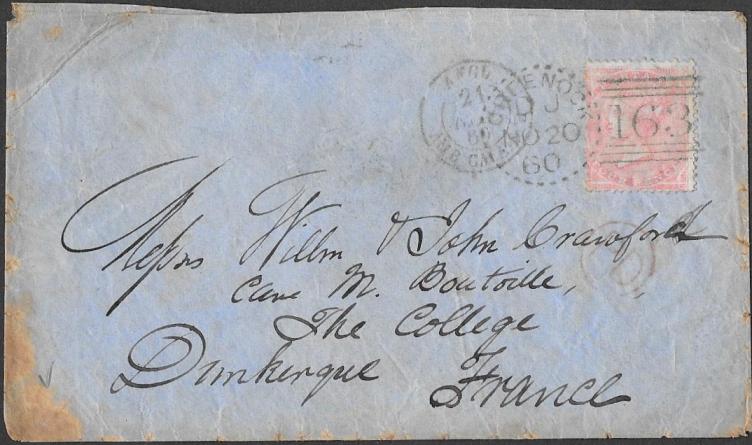
154080
4d SG66, tied to a flimsy envelope to an interesting address in France
by a lightly struck Greenock Type 1 Dotted Circle.
Lightly struck but fully clear for November 20th 1860 Code DJ.
Arundel records this scarcer of the two types as normally found on the Penny Stars issue
and rarely on the Fourpence Rose which he priced at £120.
Some staining but lighter than the scan suggests.
Arundel records usage of Type from June 1860.
The item offered here could be the earliest example of Type 1 to an overseas destination.
A very scarce item that could make an interesting Display page.
Price: £58.00
Greenock Dotted Circle Type 2 on 1d Plate

153497.
1d Plate 87, 'JI', NE blunt corner:
tied to an envelope by a very fine/superb Greenock Dotted Circle Type 2 for Febuary 15th 1865.
There is not a letter inside but an ink impression of some of the writing has transferred
to the inside of the envelope and is visible through the paper back and front.
We can not recall seeing such an effect for some considerable time.
Price: £28.00
NB: there is a horizontal crease well clear of the 1d and cancellation.
Greenock Dotted Circle on 1d Plate

153496.
1d Plate 143,'KN', very fine in a deep shade:
tied to an envelope by a fine strike of the Greenock Dotted Circle Type 2 for November 2nd 1871.
There is a horizontal crease well away from the stamp and cancellation.
On the reverse is printed in a blue oval ' Walter Grieve Son & Co. Greenock'.
An attractive item with a fine strike and a scarcer plate.
Price: £35.00
2d Plate 13: Greenock dotted circle Type 2

153494.
2d SG47, deep blue, 'GI', Plate 13:
fine/very fine, tied to a piece by the
Greenock Dotted Circle Type 2, December 30th 1871.
Unrecorded by Arundel on any 2d issue.
The 2d has a clear profile.
A rare usage and an attractive display item.
Price: £45.00
2d Plate 9 Geenock Dotted Circle Type 2

153495.
2d SG46, 'GG-GH', Plate 9:
very fine used, tied to a piece by a lightly struck Greenock Dotted Circle Type 2
for July 1863 which leaves a clear profile on both stamps.
Unrecorded usage by Arundel on any 2d issue.
A rare multiple usage and a display quality item.
£65.00
NB: this item and the 2d Plate 9 on piece would make a very fine display page.
Unrecorded usage of this issue with any dotted circle

153498.
4d SG79 Plate 'JG':
a fine wing margin example tied to a piece by a very fine
Greenock Circle Type 2 for November 14th 1864 and also by the '163' in bars.
The bars from the complete duplex are on top of the '163'
which suggests the first strike was incomplete so a second was applied.
Arundel does not record this cancellation on this 4d.
nor is any example recorded by him on this 4d stamp
with any other type of dotted circle ie Edinburgh and Dundee.
Gibbons prices the 4d SG79, with an ordinary cancellation, at £170.
An unusual and rare usage.
Price: £75.00
Unrecorded usage on any Dotted Circle

153499.
3d Plate 4 SG92 fine:
cancelled unusually by both parts of the Greenock Dotted Circle Type 2 for October 2nd 1866.
The pale rose shade allows the cancellations to be clearly seen.
This 3d Plate 4 is unrecorded by Arundel on this and any Dotted Circle
ie from Greenock, Edinburgh and Dundee.
Gibbons prices SG92 with an 'ordinary' cancellation a £250.
A very rare/unique item.
Price: £65.00
Rare usage of a dotted circle on this 3d.

153366.
3d SG103 Plate 6, 'JL': tied to a small envelope to Canada,.
Some horizontal creasing well away from the stamp
and a light one appears to cross the stamp but is not visible on it.
tied by a partial strike of the Edinburgh Type A dotted circle for November 29th 1871.
From the number of dots visible and the codes it is possibly A11.
Arundel records A11 on this 3d issue and priced it at £75 some time ago.
It is unrecorded on A10 which this example may be with unrecorded 13 N.
On the reverse is a fine OTTAWA ONT for December 13th 1871.
A rare usage.
Price: £45.00
Unrecorded usage of this dotted circle on this issue

153367.
3d SG102, Plate 6, 'KD' with a
trimmed wing margin on a fine envelope.
Margin trimmed possibly to avoid overlapping the edge of the envelope.
Sent from Dunoon, Dunnnon cds on the reverse for September 28th 1871, to Boston, USA.
The 3d is tied by a very fine Greenock dotted circle Type 2, for the same date.
Arundel doed NOT record this cancellation used on this 3d issue.
In m/s on the front is 'via Liverpool'.
It is likely that this item was carried on the Cunard Line's 'CUBA
which left Liverpool on September 30th 1871 arriving in New York on October 12th.
As it is addressed to Boston, it is also possible it went on the Cunarder 'Parthia',
leaving Liverpool on October 3rd arriving in Boston on October 15th 1871.
The 3d SG102, the scarcer Deep Rose shade, is priced on Plate 6 at £180
without the poremium for the cancellation.
A rare/unique set of features.
Price: £65.00
Unrecorded usage of this type on this issue and a fascinating letter
153368
5d SG169, faults, tied to an envelope, with contents, to India, from Edinburgh, letter dated September 15th 1881.
The stamp is tied by a very fine Edinburgh dotted circle Type C6 also for Sptember 15th 1881.
Arundel notes that this Type was quite extensively used used up to November 1880.
Thereafter its use seems to have dinished until a final burst of activity in December 1881 just before it was removed from service.
The example offered here is an unrecorded usage in September 1881 and close to the end of its usage.
It is NOT recorded on this 5d issue: only on the 1d and 1/2d contemporary issues.
The 7-page letter, is neatly and legibly written, with fascinating descriptions and contents.
The first three pages are the scans above and refer to how he was finding the climate in Scotland, the people and the sea journey.
Some of the other pages refer to his journey throughout Europe.
Gibbons prices this 5d at £325 on cover without adding a premium for the cancellation.
A remarkable item that would make a very interesting Display with some of the letter transcribed.
Price: £85.00 SOLD
A type of dotted circle infrequently used
153369
1d lilac die 2, tied to a clean and uncreased envelope to Edinburgh.
Tied by a very fine Dundee dotted circle for June 20th 1884 and with an UNRECORDED Code R.
Arundel records ONLY one other month of usage in 1884 ie October.
He comments it is quite a scarce cancellation which although in service a long time,
15/2/81 to 22/10/88, its usage was infrequent.
A scarce item which illustrates its infrequent/sporadic usage.
Price: £38.00 SOLD
NB: the yellowish mark near the bottom left corner of the 1d
is barely visible and does not touch the stamp.
Edinburgh Type C2 Dotted
Circle


15070.
Edinburgh C2:
very fine strike of this rare type on fine 1/2d brown postcard, January 22nd 1880.
Unrecorded
stamper and time code and unrecorded usage on a 1/2d postcard.
Printed plumbing message on reverse – scan.
Price: £85.00
Type C2


15072.
Edinburgh C2:
very fine strike with an unrecorded usage on 1/2d brown postcard
and with printed plumbing service message on reverse.
Unrecorded code combination and at November 18th 1879
an early usage of this rare type.
Type C3

15075.
Edinburgh C3:
fine strike overall on 1d pink stationery envelope to Belfast, July 6th 1881.
Very scarce/rare usage.
Price: £40.00
6d Plate 6: rare usage Greenock Type 2 Dotted
Circle

15082. Greenock Type 2:
Clean entire to an address in Portugal, superb strike, June 8th 1868,
tying fine (light wrinkle)
6d plate 6, ‘KC’, SG105.
Unrecorded usage by Arundel of this stamp.
Very fine item with a rare usage.
Price: £135.00
1d Plate 134: Edinburgh Type A11


152576.
1d Plate 134 tied to a clean printed envelope to Linlithgow by the Edinburgh Type A11 dotted circle for August 15th 1878.
Type A11 is common but the envelope was sent from the County Constabulary Office, Edinburgh,
initialled bottom left corner, and with printed at the top 'On Police Service'.
On the reverse is a very fine embossed/imprinted 'County Constabulary Edinburgh'
with a shield surrounded by a lion and a unicorn.
The scan does not do justice to the quality and clarity of the embossing.
The envelope has a very small filing? pin hole below the stamp and the stamp too
has a very small pin hole on a bottom bar below the '131'.
We have not seen previously a dotted circle cancellation used on any Official Police Envelope.
The code combination of 12Y is unrecorded by Arundel.
An attractive and very scarce item.
Price: £58.00
Edinburgh Dotted Circle Type B2

142734.
Edinburgh Dotted Circle Type B2:
fine strike on a locally used envelope, March 9th 1870, and tieing a fine 1d plate 102.
A very scarce type and with an unrecorded month of usage.
Arundel comments that it was used intermittently.
Price: £47.50
Edinburg Dotted Circle Type C3


152730.
Edinburgh Dotted circle Type C3:
fine/very fine strike, on a Halfpenny brown Postcard, sent to a scarce destination ie Kirkwall.
Believed to be only the second recorded example: we sold the first some years ago.
A fine and rare item.
Price:
£65.00
Edinburgh Dotted Circle Type C5

152731.
Edinburgh Dotted Circle Type C5: a fairly common Type but as Arundel comments
very scarce used on the Halfpenny brown Postcard.
Used locally with a generally fine strike on a superb postcard
and an unrecorded usage in October 1879.
A fine item.
Price: £40.00
Edinburgh Dotted Circle Type A: rare usage


152735.
Edinburgh Dotted Circle Type 8d SG156:
we have never previously seen this stamp cancelled by any type of dotted circle
and no example is recorded by Arundel for Edinburgh or Dundee.
On the reverse is what appears to be a pre-printing light crease not visible from the front.
There is some browning on a number of perfs.
SG156 is priced by Gibbons at £350.
A very rare item.
Price: £58.00
NB: SG156 issued in September 1876, hence the cancellation is A9, A10 or A11.
From the appearance of the dots it is more likely A10 or A11.
The browning on the reverse is far less than the scan suggests.
4d SG80: INVERTED WATERMARK
Edinburgh dotted circle

152570.
4d SG80 fine used, with INVERTED WATERMARK and cancelled by a Edinburgh Type A Dotted Circle.
Arundel has NO 4d SG80 recorded with ANY dotted circle including Dundee and Greenock.
We can not recall seeing any type of dotted circle on any value with Inverted Watermark.
Gibbons prices SG80 with Inverted Watermark at £375.
A very rare item and possibly unique with this watermark variety.
Price: £120.00
2d Plate 9: Edinburgh Type A3

152571.
2d SG45 plate 9, good/fine used on a legal entire sent within Edinburgh
and tied by a fine Edinburgh Type A3 Dotted Circle.
Arundel records only Types A1 and A4 used with 2d Plate 8:
2d Plate 9 is UNRECORDED on any other type(s).
Dundee Type 1 is recorded on 2d SG45 but the plate number is not noted.
A rare item.
Price: £70.00
15061. Edinburgh A1:
piece with fine 1d star perf 14, tied by a
very fine A1, April 29th 1857, in BLUE.
Arundel notes that this new type of cancellation was
initially struck in blue then, a short time later, in black.
He also notes that examples in
blue, or in black, prior to May 1857
are decidedly rare and we agree with this from our considerable
experience.
Gibbons prices an ordinary blue duplex on piece at
£375.
Superb and rare item.
Price: £85.00 SOLD
Type B1

15068.
Edinburgh B1:
printed letter to Glasgow, 1d plate tied by fine/very fine strike of the scarce B1, September 14th 1865.
Arundel suggests this canceller was a reserve put in to service at peak times
with A3 and A5 used to cancel the bulk of the mail.
Not an easy type to get so
clearly struck.
Price: £48.00
The Stirling Observer with Advert



152551.
1/2d SG48 fine Plate 5: tied by a STIRLING duplex for August 8th 1872
to an Advertising entire from The Stirling Observer to Blairgowrie.
It contains an actual advert dated August 1st 1872, for a Farm to be let.
An unusual and rare survivor in very fine condition.
Price: £58.00
NB: the brown near the stamp is fainter than in the scan
and does not affect the stamp.
The next six items are all addressed to the same address in Edinburgh
and franked by the bantam 1/2d from various plates.
1/2d Plate 3 from DUMFRIES

153353.
1/2d Plate 3, fine vertical pair:
tied to a clean envelope to Edinburgh, a couple of small peripheral faults at the top,
by Dumfries duplexes for April 1st 1873.
Edinburgh receiver on the reverse for the following day.
Gibbons prices a single Plate 3 on cover at £125 and on stamp only at £55.
Price: £45.00
1/2d Plate 4 from DUMFRIES

153355.
1/2d Plate 4, fine vertical pair:
tied to a clean envelope, a light horizontal crease which crosses the stamps but is not visible on them.
The Dumfries Duplexes, February 24tt 1873, are neatly applied and there is a
very fine Edinburgh receiver on the reverse for the following day.
A single Plate 4 on cover priced by Gibbons at £115 and on stamp only at £50.
An attractive item.
Price: £35.00
1/2d Plate 4 from LOCKERBIE


153357.
1/2d Plate 4, vertical pair lightly cancelled.
Tied only by the bars of a single Lockerbie duplex, February 4th 1873: Contrary to Post Office Regulations.
A clean envelope with a light horizontal crease that crosses the top stamp but is not visible on the front of the stamp.
On the reverse is a very fine strike of the Edinburgh Travelling Post Office,
Wilson figure 691, for February 5th
1873: its last year of recorded usage.
An interesting
combination of usage and cancellations.
A single Plate 4 on cover priced by Gibbons at £115 and on stamp only at £50.
Price:
£45.00
1d Plate 122 used from BALLINASLOE

153346.
1d SG44, Plate 122, 'BE-'CG', fine used block of 6,
lightly cancelled by the '32' of BALLINASLOE.
An attractive and scarce multiple with Irish usage.
Price: £45.00
1d Plate 139 used in Castlebar Co Mayo


153456.
1d Plate 139, 'NG-OH': a very fine fresh block of four in Lake-Red,
cancelled by part strikes of the '107' numeral of Castlebar, Co Mayo
leaving 'OG' with almost a completely clear QV's head.
Some short perforations at the left as per the scan.
A scarcer plate, especially in a block.
Gibbons prices a single at £20 and a block of four at an estimated £145.
An attractive and very scarce Irish usage.
Price: £48.00
1d Plate 211: very scarce block of 4


153348.
1d SG43, Plate 211, 'SB-TC', fine used block of four:
cancelled an Edinburgh duplex with stars, August 1878.
The block has a large part original gum hence the crackly appearance of the reverse.
There are some blind perfs between 'TB' and 'TC' and other stamps that are with partly perforated
as seen in the scan of the reverse.
Plate 211 is a scarce plate especially in a block with an estimated Gibbons price of £225 plus.
A rare combination of features and a fine display item when written up.
Price: £65.00
'TO5': letter written on board Cunarder 'RUSSIA' its 4th Sailing


151487.
1d Plate 89, tied to a small very clean and uncreased envelope to Leith
by an exceptional strike of the very rare 'TO5' Travelling Office.
The recipient inscribed at the top of the envelope:
'22 Oct. 1867 - From Frank. Dated off Queenstown on Board 'Russia' .......... 20th 1867 expect to arrive on Tuesday 29th inst.'
Queenstown cds on the front for October 20th 1867 - a Sunday.
Edinburgh cds on reverse for October 22nd 1867.
The 'Russia' was a Cunard Steamship which began service on the transatlantic run from Liverpool via Queenstown in 1867,
this letter was carried on only its 4th crossing and it stayed on this route until at least 1875.
It left Queenstown on Sunday October 20th 1867 and arrived in New York on Wednesday October 30th.
In a private communication one of the UK's leading postal historians of this period, described the item as a
'Great Rarity and one that could be unique' .
This is arguably one of the, if not the, finest 'TO' covers extant.
Hard to see how a finer strike of the 'TO5' could be found.
A significant rarity from the line-engraved period.
An important item of Exhibition quality.
Price: £1,850.00
NB: understandably Parmenter gives T.0.5 a 'very rare' rating.
2d Plate 8 on wrapper from Edinburgh

153332.
2d SG45 Plate 8, ‘EG’:
superb used tied to a creased banking wrapper by
a lightly applied duplex for June 11th 1861.
The cancellation leaves QV’s profile and most of the head clear.
Gibbons prices this plate at £150 on cover.
2d Plate 12: Leith duplex used as a receving date stamp



152876
2d SG45, Plate 12, 'KE': fine/very fine tied to a clean to Leith by a very fine Glasgow duplex for June 7th 1869.
On the reverse is unusually a partial strike of the Leith '221' used as a receiving date stamp.
We have rarely seen such usage of a duplex.
The 2d is printed in a rich deep blue with a blurring of the printing we have not seen before.
Plate 12 is priced on cover by Gibbons in excess of £450.
A rare/very rare combination of features. and a display item.
Price: £125.00
Large embossed Valentine Envelope to a young man at a Scottish High School

153335.
Embossed Valentine Envelope from DALBEATTIE to Newton Stewart.
The dater portion of the '378' duplex of Dalbeattie, which ties a 1d Plate 159, is unclear but on the reverse top flap,
which displays well when raised, is a fine Newton - Stewart cds for February 15th 1875.
Unusually addressed to a very young man: a Master Laing at Ewart High School in Newton Stewart.
Although vertically creased, this is the first example we have handled, or indeed seen,
of a Valentine Envelope sent to a young man at a School.
A very unusual item.
Price: £55.00
SLIGO Cross


153315.
1d, ‘TC’, Plate 34?, into at bottom margin, tied to a wrapper by a very fine SLIGO MX.
Sent to Dublin with a Sligo date stamp on the front for March 19th 1844
and a Dublin diamond receiver for the next day on the reverse.
Rockoff and Jackson note two variations of this neat small cross: Type 1 and 2.
From their illustrations the example offered here is Type 2.
They record only seven examples, five Type 1 and two Type 2.
The latest of the two Type 2’s is February 12th 1844 so the example here
extends the recorded usage by some five weeks.
A very scarce and attractive item.
Price: £85.00
NB: the 1d stamp appears to have been affixed over an existing paper crease
as the
surface of the 1d is not affected.
Single Queen Street Scots Local: Contrary to PO Regulations


153308.
1d, SG17?, SC perf 16, ‘GI-GJ’, fine pair, cancelled contrary to regulations
by a single strike of the Scots Local Queen Street, Type XV111 on a wrapper and rare as such.
On reverse is a superb hexagonal Glasgow date stamp for March 8th 1855 and an Edinburgh date stamp for the following day.
On the front is a contemporary ink date and Queen Street.
A rare example of a Scots Local used as a single strike on a pair of 1d perforated.
Price: £95.00
NB: it may be an Archer Plate (94) but is sold as SG17
1d Plate 58 pair with RPS Cert: mixed inks


153310.
1d Plate 58, pair, ‘DK-DL’, on a letter sheet to Dunbarton from Stewarton each stamp cancelled by the ‘307’ of Stewarton.
On the reverse are three boxed datestamps: Stewarton for January 10th 1846;
one for Kilmarnock on the same date and and one for Dumbarton on January 11th.
An RPS cert states that the cancellations on the 1d’s are in mixed inks.
The Stewarton date stamp on the reverse is in a blue/green and matches the colour of the ‘307’ numeral cancellations on the 1d’s.
Gibbons prices a single 1d red imperf on cover with a blue numeral cancellation at £650.
Price: £225.00
Greenock characteristic cross with full margins on1d Plate 23


153309.
1d Plate 23, ‘TL’, very fine with full margins
and with a complete and neatly applied GREENOCK characteristic cross.
The entire was sent from Greenock to Edinburgh, Greenock boxed date stamp for September 30th 1843
and an Edinburgh receiver for the following day: a SUNDAY.
This cross priced by Gibbons on cover at £500.
Not a rare cross but very difficult to find on cover with full margins and a neatly applied full cross.
Price: £85.00


153289.
2d, Plate 3, ‘AE’, four margins, close but clear at the NW corner and with the open ‘A’ characteristic of this plate.
Tied to a wrapper from BELFAST to Edinburgh by a fine ‘62’ of Belfast.
On the reverse is a blue Belfast date stamp for JUNE 27th 1844 and an Edinburgh receiver for June 29th 1844.
On the front is a handwritten date of 27 June 1844 and unusually ‘Private & Confidential’.
Although the 2d is creased this a very rare item.
The EKD of any Irish numeral is June 22nd 1844, from Dublin '186', on a 1d red.
The example offered here is believed to be the earliest known usage of the Belfast ‘62’
AND the earliest known usage of any Irish numeral on
the imperf 2d blue.
We cannot trace from our research an earlier used example.
An Irish rarity and an Exhibition item.
Price:
£295.00
2d Plate 3: full margined strip with Double Letter variety

151666. 2d Plate 3, 'SB-SD': a fine full margined strip of three, tied to an
entire from GLASGOW to Birmingham, September 28th 1850, by '159' numerals.
This plate has only FIVE double letter listed varieties and 'SD' is one of them, Spec ES11h.
On reverse is a partial boxed Queen Street and other transit date stamps.
A pair of 2d blues in this plate priced by Gibbons on cover
at £550 in the latest Edition, 2011, QV Volume 1.
Very scarce item.
Price: £280.00
2d Plate 3 superb used large margined strip; Aberdeen '1'.

SS7. 1841 2d blue plate 3 SG14:
exceptional strip of three, ‘TA-TC’, cancelled by
Huge to very large margins and printed on un-catalogued thin paper.
Thin paper is catalogued for 2d plate 4 but not as yet on plate 3.
Exhibition quality and rare item so fine.
2d Plate 3 pair : single '159' of Glasgow

153290.
2d Plate 3, ‘EA-EB’, ‘EB’ almost full margined, in the scarcer deep full blue shade.
‘EA’ has the open ’A’ characteristic of this plate.
Tied to a wrapper to London by a SINGLE strike of the ‘159’ of Glasgow: contrary to PO regulations.
There is a Glasgow date stamp on the front for July 14th 1849 and a London receiver on the top flap for July 16th 1849:
July 15th was a Sunday.
A scarce usage of a single numeral on a cover.
Price: £85.00
Mullingar '545' cancelled Contrary to Regulations

151411.
1d SG17, finevery fine miss perfed strip of three and a single:
tied to piece and cancelled Contrary to Regulations
by two strikes only of the '345'numeral from MULLINGAR, Co. Westmeath.
An attractive and rare item in a deeper shade than the scan shows.
Price: £95.00
SG17 SINGLE '545' of Mullingar

153284.
1d SG17, very fine pair tied to a piece by a single Mullingar ‘345’
leaving both stamps with virtually clear profiles.
The stamps show missperfing with portions of the adjacent stamps in the top margins.
Superb colour.
Price:
£58.00
1d SG17: SINGLE '345' of Mullingar

153283.
1d SG17, fine/very fine pair cancelled contrary to PO regulations
by a single ‘345’ of Mullingar.
Clear profile on ‘PI’ and superb colour.
Price:
£45.00
Blue '58' of Banbridge Co Down

153288.
1d, ‘ED-EF’, Large crown perf 14, ‘ EF’ creased, tied to a piece
by fine strikes in blue of the ‘58’ of BANBRIDGE, Co Down.
A single 1d with blue numeral on piece is priced by Gibbons at £225.
Danzig does not record this numeral on a 1d red imperf.
Priced essentially as a single.
Price:
£55.00
Posted Since 10:30 Last Night: a rare usage

153000.
2d Plate 9 ‘RL’: very fine tied to piece by
the Edinburgh POSTED SINCE 10:30 LAST NIGHT Code 10 for June 12 1863.
This is a Type 2 ie no stars flanking the ‘131’ numeral.
This is listed by Arundel as RA26.
This is a very scarce type but rare usage on other than the contemporary 1d .
Arundel notes only one other usage of RA26 on a value to the1d’s
and that is on a 2d Plate 9 on piece only at £70. No 2d plate on cover is noted.
Not sure if the example on 2d Plate 9 is the one noted by him.
A rare/very rare item.
Price: £60.00
2d Plate 4 with Queen Street Scots Local


153251.
2d SG19 Plate 4, fine/very fine used pair: cancelled by a very fine complete strike
of Queen Street Scots Local of Glasgow Type XV111.
There is a trace of a partial second strike beneath the top one and some hinge remnants on the reverse.
The outline of the strikes can be seen on the reverse as a result of the stamps being printed on Thin Paper.
This variety is not listed by Gibbons but is on the imperforated Plate 4 issue, Spec ES14q.
A single stamp without the Scots Local priced by Gibbons at £100.
A rare item.
Price: £90.00
PERTH Experimental Duplex: entire from LUNCARTY

153226.
1d star, perf 14, ‘RF’: tied to a commercial entire from LUNCARTY, dated July 1st 1856,
by a very fine PERTH experimental duplex for this same date.
The EKD for this strike is April 30th 1856 by the SPHG.
An attractive item of display quality.
Price: £30.00
Very Rare usage of a Dotted Circle

152854.
1d red, ‘CF’, Plate 158?, full margined but with a light horizontal crease.
However, cancelled by a part DOTTED CIRCLE of Edinburgh.
The only example we have seen of ANY type of dotted circle, from any location,
cancelling a 1d red
imperf and unrecorded by Danzig.
An exceptionally rare item.
Price: £65.00
EKD of a Scottish numeral used outside of Glasgow

153222.
1d, ‘GG’, almost three margins, tied to an entire from Granton to Dumfries
by a fine ‘256’ of Moffat: letter dated June 22nd 1844.
On the reverse top flap is a TOO LATE in red of Moffat.
Auckland records a proof strike of this for June 1840 but NO recorded usage.
Also on the top flap is a boxed Moffat date stamp for June 22nd 1844
and a partial Dumfries receiver for June 23rd 1844.
This is believed to be the EKD for any Scottish numeral outside of Glasgow.
A Scottish rarity that displays well.
Price: £125.00
Dublin Special Cross and a very rare Dublin Late Fee mark


153227.
1d red, 2 plus margins, tied to an envelope to Belfast by the Dublin Special Cross.
On the reverse, neatly applied and separate from each other are:
a Dublin date stamp for October 24th 1843; a Belfast receiver for October 25 1843 Mg (morning duty)
and a fine strike of the very rare Dublin postage late mark, McKay Fig 1071.
It is thought that these marks indicated posting after the normal hour of despatch (the earlier time stated)
but before the despatch of the mails (the second time stated),
so that on payment of a Late Fee the letter could be sent forward that evening.
A rare/very item that allows the markings to be displayed well.
Price: £78.00
PAISLEY Cross Double Strike May 28th 1844


153207.
1d, ‘CI’, Plate 40, full margins but very close/touching at right.
Tied by a double strike of the PAISLEY Cross, to a clean wrapper to Glasgow, side flaps removed for display purposes.
On the reverse are boxed date stamps for Paisley: May 28th 1844 and a timed Glasgow for May 29th 1844 7:30AM.
Rockoff and Jackson Volume 2 page 219, devote the whole of this page to the Paisley Cross.
They list only 9 examples on the 1d red on cover
between March 16th
1841 and
January 4th 1843 and none have a double strike of the MX.
Almost all the illustrations of the cross show poor or partial strikes suggesting that the cross was not kept clean.
The example offered here is the latest usage recorded and within a month of the MX being replaced by the numeral ‘277’.
The double strike of the MX was contrary to Post Office Regulations .
A very scarce/rare item which would make a fine display page.
Plate 40 is scarce with a single MX and priced off cover by Gibbons at £140 and on cover at approx £260.
Price: £55.00
1d Plate 77 exceptional margins


153176.
1d red, Plate 77, ‘TA’, fine very large/huge margins.
Tied
to a wrapper from FALKIRK to Glasgow by a fine strike of the ‘139’ of Falkirk.
On the reverse top flap is a fine blue Falkirk date stamp for September 20th 1849.
There are traces of adjacent stamps on three sides and
the fourth has a very small trace of a ‘7’ from the plate number.
The 1d shows signs of plate wear.
An attractive item with a very scarce/rare set of features.
Price: £45.00
1d black plate X1 Edinburgh Cross

153186.
1d Plate X1, ‘GI’: fine with 3 margins and just tied at the top by a superb Edinburgh MX
to a letter from Edinburgh to London, August 19th 1841 receiver on reverse for this date.
An Edinburgh cross Type 1 or 2 is listed by Gibbons on a non-black plate as Spec B1tk
but unlisted on a 1d red from a black plate: this appears to be Type 2.
1d red from this black plate priced by Gibbons on cover at £350.
Price: £48.00
EKD for the Inverary numeral

153175.
1d Plate 43,’QD’: full margins but very close in a number of places,
on an from INVERARY, dated June 24th 1844, to Edinburgh.
The stamp tied by partial strike of the ‘181’ of Inverary.
On the reverse is on the top flap an Inverary date stamp for January 25th 1844
and an Edinburgh date stamp for the following day:
these stamps can be displayed with the top flap raised.
From our researches we cannot find as earliest usage.
This is possibly the Earliest Known Date for the Inverary numeral which replaced the MX.
The EKD for a Scottish MX is Glasgow June 19th 1844.
Other more provincial locations received their replacement canceller later than this.
Price: £45.00
The EKD for the usage of a 2d plate with numeral cancel in Scotland?


153174.
2d Plate 3, fine, SG14, ‘PL’:
three margins with a small part marginal inscription at left and portion of another stamp at bottom.
Stamp tied to an entire from GLASGOW to Inverary by a fine ‘159’ of Glasgow.
On the reverse are date stamps for Inverary (incomplete but '24' is showing), and Glasgow for June 25th 1844.
The EKD for a Glasgow numeral replacing the MX is June 19th 1844.
The example offered here is believed to be the EKD for a 2d plate with a Glasgow numeral
and very possibly the earliest usage on a 2d of any Scottish numeral .
From our reasearches we have not managed to trace an earlier numeral usage of a 2d plate in Scotland.
Very fine item and rare.
Price: £125.00
Archer Plate 94 used in Edinburgh with RPS Certificate



151240.
1d ARCHER Experimental Perforation, SG16b: fine, 'NI', from plate 94,
tied to a letter from The Edinburgh, Perth and Dundee RAILWAY COMPANY.
Used locally within EDINBURGH, June 8th 1854, and tied by the '131' of Edinburgh;
this is and a very rare usage in Scotland.
Filing fold clear of the stamp.
The item is offered with an RPS Certificate.
Priced by Gibbons at £1,700 in this plate.
Price:
£835.00
The Earliest Known Date for the Distinctive DUMFRIES Cross


153057.
1d red ‘SG’, three plus margins, close at the top but clear of the design,
on a legal entire from DUMFRIES to Castle Douglas.
The stamp is tied by an upright strike of the distinctive Dumfries Cross, SG Spec B1tj.
On the reverse is a Dumfries boxed date for JUNE 17th 1843:
the letter is dated similarly inside.
Rockoff and Jackson, ‘The Maltese Cross Cancellations of GB and Ireland’, Volume 1,
discuss in detail, and illustrate examples of, this cross.
The EARLIEST DATE recorded of this distinctive cross
is on a 1d red to Edinburgh on JUNE 17th 1843.
This matches the date of the example offered here.
Gibbons prices this cross on cover at £1,100.
An Exhibition item.
Price: £495.00
AIDRIE numeral in GREEN

153046.
2d perf 14, Large Crown?, ‘BI’,
NW corner fault, and perfs at the right jut touched by
the trimming of the piece to which it is attached.
Tied by the numeral ‘17’ of AIRDRIE in superb GREEN ink.
Gibbons prices a green numeral on a 1d perforated stamp on piece at £500.
No prices are quoted for coloured numerals on any 2d perforated issue,
only on the 2d imperf plates 3 and 4 which are priced on stamp at £6,000.
We have neither previously been able to offer any 2d issue with a green numeral,
nor have been able to trace another example.
An extremely rare item which displays well.
Price:
£285.00
1d Plate 10 without 'O' Flaw: Edinburgh Cross


153019.
1d red Plate 10, ‘CC’: a fine example with three margins.
Tied to an entire by a superb first type EDINBURGH cross and sent within the City.
On the reverse is a March 12th 1841 date stamp of Edinburgh.
Danzig comments in ‘The Cancellations of the 1841 1d Reds’ that the usage of 1d reds
in February and March 1841 is scarcer than 1d blacks used in this same period which is our experience too.
The 1d red Plate 10 offered here has been printed without the ‘O’ flaw and is from the printing in black and red
following the first (Provisional Issue)repair, SG Spec As71 priced at £400 on stamp.
On cover this printing is priced in excess of £800.
A fine item with a rare combination of features.
Price: £175.00
NB: the MX leaves the variety clear at the bottom of
the stamp.
Cupar to Toronto: very interesting links.


153034.
This item is from a Display Collection.

On the internet is a lot of information about George Brown, including a photo of him.
A print out, from the internet, is provided with this item.
Briefly: He was a journalist and statesman born in Alloa, near Edinburgh, in 1818.
In 1838 he emigrated with his father to the United States.
In 1842, the father and son founded, in New York, The British Chronicle but in 1843 moved to Toronto.
They started a number of newspapers including The Globe: a political journal.
In 1851, Brown was elected to the Legislative Assembly of Canada.
In 1858, with A A Dorion, formed the short-lived Brown-Dorion Government.
His political career is detailed in the biopic provided. In 1862 he took a long holiday in Britain.
In Edinburgh he met the daughter, Anne Nelson, of a family friend and fell deeply in love.
They were married on November 27th 1862: he was then 43.
They returned to Canada in late December to a tumultuous mass welcome in Toronto.
Anne Nelson was the daughter of Thomas Nelson the
publisher.
He died in Toronto on May 9th
1880 from a bullet wound inflicted by a sacked employee.
This would make a superb and interesting display item linking Scotland and Canada:
a Scot who made it big in Canada!
Would make an interesting display item with the write up.
Price:
£165.00
Green Dublin Spoon: early usage on 1d Spec C6

153029.
1d red, perf 14, Spec C6, Plate 4: fine with a couple of slightly ragged perfs at the right, tied to a piece
by the DUBLIN spoon duplex Code 1, in a superb bright GREEN, for August 18th 1855.
Arundel records this spoon, struck in green, for barely three months and then in black for almost two years.
A usage on 1d C6 is unrecorded by him.
Gibbons note the EKD for C6 as August 7th1855 and this example for August 18th 1855
is the earliest usage of C6 struck in green that we have been able to trace.
Gibbons prices a green spoon on piece at £500.
A rare item.
Price: £120.00
Edinburgh Paid 6d Extra late fee: very late usage


152819.
1d red, fine 3-plus margins,
tied to an entire from Edinburgh to Paisley by the ‘131’ of Edinburgh.
On the reverse is an Edinburgh date stamp for July 3rd 1851 and the
unusual large double ringed Paisley date stamp for July 4th 1851.
Almost tieing the 1d red is a very fine/fine strike of the rare Edinburgh ‘Paid 6d Extra’.
This cancellation was applied to letters handed in between 7.00 and 7.20pm at the Edinburgh Post Office.
Because of the high late fee charge of 6d, it was rarely used in comparison to the ‘1d Paid Extra’ strike.
This is the latest usage of this rare mark we have seen
and have not managed to trace a later example on cover or piece.
Price: £135.00
1d with Marginal Inscription and Unrecorded UDC


153005.
1d red, ‘GA’, almost full margins very close to touching at the right, with full deckle edge and
inscription ‘’(t)he Back be Careful..’ on an entire from KILLEARN, dated February 27th 1847, to Lennoxtown.
On the reverse is a KILLEARN undated circle in red: this is unrecorded by Auckland.
The only listed postal mark is Killearn/Penny Post but Auckland notes that after this strike ended its usage,
boxed numerals of the Glasgow Penny Post were employed.
The 1d is tied by a smudged Glasgow numeral and on the reverse is a Glasgow date stamp for February 28th 1847.
A tear on the top flap has been strengthened, in the dim and distant past, by a piece of cellotape
the trace of which is on the front at the top but does not touch the stamp margin.
It is visible on the outside of the rear top flap well way from the Killearn udc.
A very rare/unique combination of features.
Price: £150.00
Crown Street Scots Local


153007.
1d perf 14, SE corner fault, tied to a clean envelope to London by a very fine/superb strike
of the Scots Local Type XV111, of CROWN STREET, Parent Post Office was Glasgow.
On the reverse is a Glasgow date stamp for December 19th 1855 and London receivers for the next day.
Alcock in ‘Scots Local Cancellations Illustrated’, on page 59 illustrates an example of the Crown Street Type XV111,
on an envelope to the same addressee and address in London, written in the same hand, as the example offered here.
Arguably the quality of the Alcock strike is not as fine as the example here.
Although Alcock gives this strike the lowest rarity ‘A’ grading, he notes that clear impressions
are exceptionally hard to find and worth a substantial premium over the prices quoted.
The quality of the strike, certainly one of the finest extant, makes it a rare item.
Price: £65.00
2d Plate 4: a rare usage of the Dundee Experimental Duplex .


151923.
2d SG14 Plate 4 'DK-DL':
pair cancelled by the DUNDEE Experimental Duplex for April 19th 1856
The SPHG reported that this break appeared between April and June 1856
in the lower arc of the date circle due to damage.
This at April 19th 1856, is believed to be the earliest example of this damage
and the only one known on the imperf 2d blue.
This is also a late usage of the 1841 2d blue.
Very few examples are known of any of the Scottish Experimental Duplexes
used on the 1841 2d blue and this, and Glasgow Item 152997,
are the only examples we have been able to offer.
A very rare/unique Dundee item.
Price: £195.00
Greenock distinctive cross: a rare usage on 2d blue


153006.
2d blue SG14, ‘DG’, Plate 3: into on two sides, on an entire from GREENOCK to Edinburgh.
On the reverse top flap is a boxed Greenock date stamp for March 25th 1843
and an Edinburgh receiving date stamp for March 27th 1843; March 26th 1843 was a Sunday.
The 2d is tied by the distinctive Greenock Cross, SG Spec E1ug,
and priced by Gibbons on cover at £2,000.
The stamp has been affixed over a ‘pre bump’ in the paper.
An opportunity to acquire an example of the rare usage of this cross.
Price: £325.00
Hoster machine dater used as a backstamp


152981.
A fine/very fine 1d carmine pale blue Letter Card from CALLANDER to London Cheapside,
cancelled by a very fine/superb Callander duplex 64, for May 28th 1892.
On the reverse and used as a backstamp is a strike of the Hoster machine dater in red, Code 7,
for May 30th 1892: May 29th 1892 was a Sunday.
The letter inside refers to a journey from Perth.
An attractive and very scarce item.
Price: £45.00
The Hoster machine dater used as a backstamp


152982.
A fine 1d carmine pale blue Letter Card from DUNDEE to London, Cheapside,
cancelled by a superb Dundee duplex, 114, for June 7th 1892.
On the reverse is a Hoster machine dater in red, used as a backstamp, for June 8th 1992, Code 7.
Inside is a message headed ‘Market Report’.
A scarce item.
Price: £35.00
More examples of the Hoster machine dater used as a backstamp
can be found in the Surface Printed, Stampless and Stationery Sections.
DUBLIN CROSS: 1d Plate 35
superb large margined example on clean wrapper, inside flap repaired,
used locally in Dublin, July 27th 1843.
Stamp tied by a superb DUBLIN Type 11 characteristic cross, Spec B1tf.
Superb item and priced by Gibbons at £300.
Price: £145.00
Dublin Type 11 Cross: an unrecorded SECOND break in the cross.


152957.
1d Plate 31, ‘QK’: three plus margins tied to a wrapper to Nenagh
by a superb Dublin Type 11 distinctive cross.
On the reverse is a DUBLIN diamond date stamp for August 11th 1843
and a Nenagh date stamp for August 12th 1843.
The Dublin cross is dealt with in some detail by Rockoff and Jackson Volume 1, pages 91-93.
The example offered here has a known break/gap in the outer part of the cross
and Rockoff illustrates only five examples, two off cover and three on covers: all are on the 1d red.
This example is not recorded by them and this has a SECOND break
in next section of the outer part of the cross as seen in the scan.
Examples showing the two outer breaks are NOT recorded by them
and we have not seen another such example on or off cover.
Gibbons prices a Dublin Type 11 without the break at £300 on cover.
A superb example of the known, and previously unrecorded, break.
Price: £175.00
DUBLIN Special Cross: rare type with break.

152980.
1d pink embossed envelope, December 27 1843:
with very fine strike of the
characteristic
Seen clearly at the right is the BREAK in the outer cross.
Rockoff Volume 1 page 93, lists only three recorded examples
of this constant variety on cover:
ONE are recorded on the 1d pink envelope.
The Dublin cross without the break is
priced by Gibbons at £300 on a 1d red on cover
but much scarcer used on
embossed envelopes.
Dublin Special Cross with constant break


152672.
A fine 1d pink stationery envelope from DUBLIN to Liverpool, November 2nd 1843.
Cancelled by a superb Dublin Special Cross with the constant break in the outer arm of the cross.
Rockoff and Jackson illustrate in Volume 1, only five examples and none are on a stationery envelope.
Of the five they show, three are on 1d red covers and two are on 1d reds off cover.
Priced by Gibbons on cover at £300 without the break.
A superb example of this rare variety.
Price: £175.00
DUBLIN Cross: constant break variety.

15195.
2d deep blue Plate 2, ‘RD’: large margins but just clear to shaved NW corner.
Very small shallow thin on reverse at top left but cancelled by
a very fine/superb strike of the characteristic DUBLIN CROSS, Spec DS7vj.
This cross clearly shows the constant break in the outer frame which is
illustrated by Rockoff, Volume 1, p 92/3, between March 1843 and March 1844 with
only 3 out of 41 covers showing this variety all on 1d reds.
As far as we are aware, the example offered here of this variety
is the only one known on the 1840 2d blue
and is a late usage within the MX period.
The characteristic Dublin cross, without the rare break, is priced
by Gibbons in the latest, QV Volume 1, at £2,500.
A considerable rarity.
Price: £530.00
Dublin Cross with outer breaks

15196.
2d blue plate 3, ‘IH-II’: pair, ‘II’ full margins, just clear SE square,
with a contemporary written date of 1844,
and tied by two superb strikes of the DUBLIN Type 11 characteristic cross to a piece.
Both crosses clearly show the constant break in the outer frame which is recorded by Rockoff,
Volume 1, p 92/3, between March 1843 and March 1844
with only 3 out of 41 covers showing this variety and all on 1d reds.
None are recorded on the 2d blue and as far as we are aware, the examples offered
here of this variety are the only known strikes on the 1841 2d blue.
The characteristic Dublin cross, without the constant break,
is priced on a single 2d blue by Gibbons at £500.
A very rare and attractive item.
Price: £485.00
NB: Items 15195 and 15196 would make a unique pairing.
The very rare Type 1c Posted Since Last Night duplex

152908.
1d SG40, fine, on a wrapper dated inside June 26th 1858, used locally in Edinburgh.
The stamp is tied by the very rare Edinburgh Posted Since 7.20 Last Night duplex: RA13 Type 1c.
The date is June 27th 1858, a SUNDAY evening usage.
Arundel records this cancellation used in only three months: May and June 1858 and April 1859.
The codes recorded are L and W so this example has an unrecorded Code U.
Arundel notes that Type 1c accounts for less than 0.5% of the known usage
of all Posted Since Last Night cancellations.
He records the EKD for Type 1c as May 20th 1858 and the latest April 17th 1859.
Interestingly this latter date is also a Sunday usage.
He further comments that the extra 20 minutes for posting allowed at the Head Office resulted in less mail
being received late than emanated from the earlier deadline at the Local Receiving Houses.
Hence one die usually sufficed to cancel this late mail and that was RA12.
The second die, Type 1c, was thus rarely required.
Arundel prices Type 1c on a 1d at £150 but in our experience this price significantly undervalues its rarity.
This is the first example we have been able to offer.
Price: £175.00
NB: Arundel’s explanation for Type 1c being rarely used may well be accurate.
It does not fully explain its usage on Sunday evening when, in Scotland, the Sabbath day
was strictly observed for rest and not work though it
may be the exception proving the rule.
A very rare Edinburgh date stamp.


152910.
Printed Mercantile and House Agency letter from Edinburgh to Thurso dated May 9th 1857.
Postage paid by a 1d star perf 14 and tied by an Edinburgh roller: the stamp has a vertical filing crease.
On the reverse is an exceptional proof-quality strike in RED for May 11th 1857 (May 10th 1857 was a Sunday)
of the First Single Circle name and date stamp used by the Capital and introduced in May 1857.
McKay notes that this first type had the name around the top and the year was hand engraved.
The stampers and duty code letter was separated by a hyphen.
It was struck in a colour other than the usual black, in this case RED,
possibly to show it was a totally new cancellation: this was done with the introduction of Dotted Circles in Edinburgh
which were struck initially in blue and later in black.
This is a rare cancellation and this example is believed to be the earliest known usage.
The proof strike for the Edinburgh duplex is May 14th 1857.
The earliest known date of usage is May 15th 1857.
Initially in blue and later in black, it largely replaced the roller cancellation in Edinburgh.
The example offered here at May 11th 1857 is on the cusp of these innovations and changes.
A superb and rare item.
Price: £120.00
NB: The scan does not do justice to the RED colour of the date stamp.
See Item numbers 152164 and 152165 directly below:
the earliest known dates
of the Edinburgh duplex in blue
May 1857
KIRKCALDY Cross


152636.
1d, 'CG' Plate 12: fine example with full margins slightly close at the left but clear.
Tied to an entire to Leslie, October 2nd 1841, by a fine KIRKALDY Cross.
Rockoff and Jackson Volume 1, illustrate a number of examples
but the one offered here, is not recorded by them.
It is the earliest usage on a 1d red with this cross.
1d Plate 12 is priced by Gibbons on cover at £200.
A scarce item.
Price: £95.00
1d Plate 10: unrecorded Double Lined Cross



152711.
1d red Plate 10, ‘ML’, fine with 3-plus margins on an entire,
dated inside July 28th 1841, from LOCHGILPHEAD to Inverary.
On the reverse is a boxed Lochgilphead error date stamp with an inverted ‘3’ instead of a ‘2’.
The letter is addressed to the Procurator Fiscal and is written and signed
by a Police Constable detailing his attempts to catch a number of men.
Although with m/s ‘OHMS’, the postal authorities applied a very fine handstruck ‘2’ and ‘to pay’ alongside.
The 1d red is tied by a very fine Lochgilphead Maltese cross which clearly shows it to be Double Lined.
Rockoff and Jackson do not list this cross.
Gibbons prices a 1d red Plate 10 on cover at £400.
A very fine and unusual item which would make a fine display page.
Price: £140.00
2d Plate 3 with a pre-proof Kirkcaldy date


152818.
2d SG14, Plate 3, ‘CK-CL’ and ‘BG’:
CK has full margins, with part of the stamp ‘DK’, but affected by a light vertical filing crease;
‘CL’ is into at the right but with a very large bottom margin and a portion of ‘DL’.
The stamps are cancelled by the ‘92’ of CUPAR, (Fife).
The wrapper is addressed to ‘Wemys Castle By Kirkaldy’.
On the reverse is a Cupar Fife date stamp for May 10th 1847 and
a Kirkcaldy unframed date stamp in blue for May 11th 1847.
Auckland lists this as FL428, a recut date stamp of Kirkcaldy with a Proof Strike taken on May 28th 1847.
He records its earliest date of usage as August 1847.
Hence the example offered here is earlier than the Proof Strike
and earlier than the recorded earliest usage.
Gibbons prices a single 2d Plate 3 on cover at £350.
A 6d rate on a relatively small wrapper for this which displays well.
Price: £55.00.
NB: The scan does not do justice to the blue Kirkcaldy date stamp.
In the Pre-stamp and Stampless Section is Item 152799,
a superb Kirkaldy Uniform Penny Post 1840 entire,
to the same
addressee at Wemys Castle, Weymss.
GLASGOW crosses: three single 2d Plate 3



152842.
2d Plate 3, SG14, three singles, ‘TI’, ‘SI’ and ‘RI’, none have full margins,
but are tied to a letter by GLASGOW Crosses. ‘SI’ has a partial double strike.
The MX on ‘RI’ has a constant mark near the inner diamond which gets fainter on the MX’s
from right to left as the inking of the cross decreases but is still visible.
On the reverse is a Glasgow hexagonal date stamp for June 27th 1843 and a faint Edinburgh receiver.
The letter, dated June 27th 1843, refers to enclosures hence the 6d rate.
Rockoff and Jackson records almost 50 examples of the Glasgow cross on cover,
two are on a Mulready and the rest are all on 1d values.
NONE are recorded with a 2d on cover.
Gibbons prices a single 2d Plate 3 on cover with a MX cancellation at £650.
This is a rare item.
Price: £125.00
NB: it is much rarer to find on cover three separate 2d’s than a strip of three
and especially so with Maltese crosses.
Cupar handstruck 1 in UPP period: Burmese War Money Prize


152882. Wrapper from CUPAR Fife to London.
No postal markings on the reverse: all the 'action' is on the front.
A boxed Cupar date stamp for May 14th 1840, barely a week after the 1d black was issued.
The 1d postage paid by a handstruck ‘1’ in the same colour as the Cupar date stamp.
This predates by 2 months the EKD by Auckland.
The Paid date stamp for May 14th 1840 is Auckland ED76 but is unrecorded in black,
red being the only colour noted in use up to 1849.
The Paid Tombstone for May 16th 1840 was applied in London.
On an inside flap is a statement ‘Robert Hagden to be paid Burmese Prize money’.
In view of this note, it is very likely the wrapper was addressed to
‘The Burmese Prize Agent’, East India House’, even though some spellings are incorrect.
On the internet are references to Prize Money awarded during the Burmese Wars.
A very attractive item which displays well with all the postal markings on the front:
neatly applied and spaced; not overlapping and all upright.
Price: £60.00
Cupar Cross


152893.
1d red ‘GK’, tied a clean wrapper from CUPAR, to Blairgowrie.
On the reverse is a very fine Cupar Angus boxed date stamp for September 8th 1843 and a
partial Blairgowrie same date stamp indicating the item was delivered on the same day it was posted.
The 1d red is not full margined but is neatly tied by a superb strike of the Cupar cross.
Rockoff and Jackson in Volume 1 illustrate seven examples of this cross on 1d red covers.
The example offered here is unrecorded by them and the quality of this strike
is arguably as fine, if not finer, than any recorded by them on a 1d red.
An attractive example of this very scarce cross.
Price: £60.00
2d Plate 12 from Edinburgh

152906.
2d blue, SG45, very fine Plate 12.
Tied to a clean commercial banking entire to Haddington by
a fine/very fine EDINBURGH duplex for July 12th 1869.
There is a Haddington date stamp on reverse for the same date.
Hence the letter was delivered the same day it was posted.
Plate 12 is by far the scarcer of these 2d plates ie plates 7-12,
and priced by Gibbons on cover in excess of £400.
This is before adding the Gibbons premium for such
a fine example so lightly cancelled.
A very scarce item which would display well.
Price: £125.00
Scots Local Type IV DUROR RUROR


152904.
1d perf 14, some light creasing and scuffing near the top.
Tied to an envelope to Glasgow by a typical partial strike of the
Scots local Type 1V of DUROR DUROR.
On the reverse is a BONAW cds for February 6th 1858: the parent Post Office.
In the Meredith Collection of Scots Locals, Robson Lowe Auction 1971, Lot 33
was an envelope with a clearer but similar partial strike and a piece with a damaged 1d.
It sold for the equivalent in modern money of approx £220.
A difficult cancellation to find.
Price: £70.00
4d SG64: Glasgow Experimental Duplex

152903.
4d SG64, watermark medium garter: fine used, a pulled perf bottom left,
cancelled by the second type of Glasgow Experimental Duplex, the so called ‘Madeleine Smith’.
The first example of this cancellation we have been able offer on any of the 4d medium garter series.
Gibbons prices the basic SG64 at £500.
A rare combination of stamp and postmark.
Price: £75.00
9d SG87: Leith duplex and other cancellations.

152889.
9d SG87 ‘RL’, cancelled by a partial ‘221, and cds of LEITH.
There is also a small part of the blue Aus England transit date stamp
and portion of a red PD in oval?
There are a few short perfs at the bottom.
Gibbons prices this stamp at £475.
Unusual to have portions of so many different cancellations
and a rare item as such.
Price:
£85.00
GREENOCK CROSS on 2d Blue Plate 3

260.
1841 2d blue SG 14 plate 3:
tied
to entire by very fine
Not 4-margined but a rare usage of this cross
Priced by Gibbons at £2,000 on cover.
Very few examples are known with this cross on a 2d blue cover.
Price: £480.00
KIRRIEMUIR Cross on 2d Blue Re-entry


151364.
2d Plate 3, SG 15, DeepFull Blue, 'OD' and 'OG':
Tied to an entire, no enclosures, from Kirriemuir to Edinburgh,
superb Kirriemuir boxed date stamp in orange for August 26th 1843 on reverse top flap
which displays well when raised. 'OD' is a large full margined example, 'OG' with 3 plus margins.
Each tied by a black cross of KIRRIEMUIR, 'OG' with part of a third cross. Discussed by Rockoff and Jackson in
Volume 1 of 'The Maltese Cross Cancellations of GB and Ireland' and with
only four examples of dated covers which does not include the example offered here.
Population of Kirriemuir in 1841 was only 3,000.
Stamp 'OG' has the ONLY re-entry on Plate 3, Spec AS12b,
illustrated in QV Volume 1 p295, and grossly under-priced.
The MXs leave most of the re-entry marks visible especially in the top margin.
A non-variety single 2d with black cross on cover is priced by Gibbons at £650.
This is the only example we have seen of this rare re-entry on cover with a MX cancellation.
An Exhibition quality item.
Price: £375.00
The rare KILMARNOCK Cross


152859.
1d red, fine, full margins but very close to just clear NE corner.
Cancelled by the distinctive KILMARNOCK cross,
SG Spec B1tp, priced at £1,400.
On the reverse is a fine ivory head.
A rare item.
Price: £185.00
KILMARNOCK Cross

1019.
1841 1d red plate 21, ‘PE’:
3+ margined with a very fine and almost complete strike
of the rare and distinctive Kilmarnock cross, SG spec B1tj.
Seldom found with such a clear strike of this cross
and priced by Gibbons at £1,400.
Price: £280.00
The rare KILMARNOCK Cross


152860.
1d red, plate 38, ‘IF’, almost full margins, just touched NW square and possibly light scuffing in this same area.
Tied to a wrapper by a partial strike of the rare KILMARNOCK distinctive cross,
SG Spec B1tp and priced at £5,000.
This characteristic cross is recorded in use only between January 25th 1844 and June 20th 1844.
On the reverse is a Kilmarnock boxed date stamp in red for April 13th 1844
and an Edinburgh receiver for SUNDAY April 14th 1844.
A very collectable example of this rarity
offered at a small percentage of the Gibbons’ price.
Price: £420.00
DUMFRIES distinctive cross: the largest known multiple on cover.


15150.
1d reds Plates 34, ‘GE and 38,’TH-TL’ strip of five, on wrapper to Glasgow from DUMFRIES,
April 13th 1844. Most are 3-margined and ‘TJ’ with a filing crease, but each stamp cancelled
by the characteristic DUMFRIES CROSS.
Rockoff Volume 1, records only 16 examples of this distinctive cross on 1d red covers.
The only multiple usage recorded by him is on one cover with a pair of 1d reds.
Gibbons prices this cross on a single 1d red on cover at £1,100.
A unique multiple franking with two different 1d red plates
and SIX strikes of this distinctive cross.
An Exhibition item.
Price: £725.00
NB: we do not recall seeing a longer strip of a 1d red with any distinctive cross on cover.
Inverary Cross: very close to its end of usage

152831.
1d red Plate 41, ‘OB’: fine/very fine with exceptional margins all around.
There are portions of FOUR other stamps.
It is tied to a legal entire to Edinburgh by an INVERARY Maltese cross
the central area of which is clogged by debris.
On the reverse top flap are date stamps for Inverary, June 15th 1844 and
an Edinburgh receiver for Sunday June 16th 1844.
The Maltese cross cancellations in Scotland were replaced by numerals from around June 20th 1844
and hence the example here is close to the time when its use was discontinued.
We have not seen a later usage of the Inverary cross.
The cross being clogged with debris may be because the canceller
was within a few days of being taken out of service and not cleaned.
A superb and rare item that displays well.
Price: £275.00
NB: Plate 41 is
scarce with a Maltese cross.
Belfast split numeral

152647.
1d red, ‘TH’, an exceptional full margined example,
very small surface scratch mark in margin below ‘H’ square,
parts of two other stamps and with a very clean back.
Cancelled by a fine strike of the ‘split 62’ numeral of BELFAST.
This variety was first seen in the 1850’s and may have been caused
by filing through the bars, McKay fig 62 and Alcock fig. 341.
We have not seen an explanation as to the reason for this distinctive and unique variety.
A superb item of Exhibition quality and very rare as such.
Price: £75.00
Kircaldy: Uniform Penny Post

152799.
Entire from Kircaldy, (spelt inside with a ‘K’) and dated July 1st 1840, to Wemys Castle, Wemyss.
The well written letter refers to various costings for road works and other projects and
a detailed listing of various costs already incurred or proposed: the contents would benefit from more research.
No postal markings on the reverse but on the front, in the position where a 1d black could have paid the postage,
is a very fine/superb strike of the Kircaldy date stamp in red, Auckland FI 422, for July 1st 1840.
Alongside it is a superb strike of the handstruck Kircaldy ‘1’, of the UPP Period, in the same colour, Auckland FI 438d.
This cancellation is recorded in use from January 22nd 1840 to August 1st 1840 and rated very scarce.
A superb and rare item which could make an excellent display page.
Price: £100.00
NB: Gibbons recently were offering an example of these same strikes
on a letter but not as fine as the examples offered here.
They noted it was
from the Chadwick Collection and priced at £150.
The very rare Inverness Type 1 Experimental Duplex

152796.
1d perf 14, ‘PC’, some shortish perfs and crossed by a light horizontal filing crease.
However, it is tied to a clean envelope to Elgin by a fine/very fine strike
of the very rare INVERNESS Type 1 Experimental Duplex.
The Scottish Postal History Group, (SPHG), note this cancellation as the 17th rarest of the 18 types listed.
An article in the ‘Scottish Post’, the Journal of SPHG, note that the Proof Strike
for this rare cancellation is in the work book for March 4th 1856.
The EKD is noted as April 24th 1856: we do not know if this is on piece or cover.
The very early example offered here is for May 22nd 1856 and
is the earliest example we have been able to offer of this very rare type.
Price: £225.00
The unique GLASGOW Late Posting cancellations.




152791.
The FIRST item: 2d Plate 3, 'TI', 3 margins, tied to an entire to Liverpool, by the '159' numeral of GLASGOW leaving a clear profile.
Part of the letter is missing inside at the bottom, having been roughly opened at the right.
On the reverse is a Glasgow hexagonal date stamp for December 16th 1847 and on the front is a fine strike of the unique tiny Glasgow stamp.
It has a miniature single-arc with the name round the top and a letter ‘L’ above a date.
In this case the year slug, for 1847, is present however the month and day are missing.
McKay notes that often this was the case as the office date stamp was usually struck elsewhere on the item of mail: this is the case with this entire.
This unique cancellation was introduced in December
1844; the ‘L’ denoted a
late posting for which a fee of 1d was charged.
The SECOND item: a wrapper from Glasgow to London, October 6th 1853.
The unique Glasgow tiny cancellation has been applied with all the date plugs removed but with the ‘L’ still in place.
The postage and the late posting fee of 1d has been paid by two 3-plus margined 1d reds, 'BK' and 'NI', Plate 156?
On the reverse is a Glasgow 10 -
sided date stamp and a London receiver for the next
day.
The date and year plugs it is believed were removed before the end of 1847 and we have not seen an example later than Item 1.
It is possible that
Item 1 is the latest usage with the year date slug still in place.
In the case of Item 2: we have not seen a later usage with only the ‘L’ in place.
A very rare and attractive pairing: the first we have been able to offer.
They would make a fine Display/Exhibition page and also show the 2d total postage charge paid in different ways.
Price the
pair: £180.00
4d SG62: rare cancellation

152725.
4d SG62a, paper very slightly blued, very fine colour and several short perfs.
The stamp is cancelled by a superbly crisp strike of the
rare LEITH Experimental Duplex for November 9th 1855.
The SPHG record its earliest known date of usage as October 29th 1855.
It is also rated 13/18 in rarity of the 18 Types of Scottish Experimental duplexes.
Not only is it one of the earliest usages we have seen
but rarely is this Type found on any other value than the contemporary 1d.
For the example offered here to be on the first issue of the 4d surface printed stamp,
and with such an early usage, is remarkable and the only one we have seen.
The wing margin allows the year to be clearly visible.
An extremely rare item with, very likely, a unique combination of stamp and cancellation.
Price: £165.00
NB: Gibbons prices the basic stamp at £450.
1/- SG101: vertical pair with variety


152728.
1/- SG101, Plate 4, fine/very fine used vertical pair, ‘DI-EI’, and cancelled
by a DUNDEE duplex ‘114’ for May 16th 1867.
The top frame line of ‘DI’ is thinned with several breaks
and, as a pair, can be conveniently compared with ‘EI’.
On the front and reverse can be seen in the wing margin
the watermark sheet position lines.
An attractive multiple priced by Gibbons at £550 as two singles.
Price: £80.00
CLOSEBURN Scots Local: very rare


152721.
2d Plate 7, SG45, pair ‘EA-EB’: ‘EA’ has a small crease at top left corner and ‘EB’ a blunt NE corner.
They are cancelled by an indistinct ‘323’ of Thornhill.
On a small envelope to Paris from THORNHILL, Dumfrieshire, date stamp on the reverse for September 15th 1859.
Also on the reverse is a superb strike of CLOSEBURN, Scots Local Type V, in BLUE.
This is unrecorded by Alcock and by Auckland.
Closeburn was the only Receiving House of the Thornhill Penny Post.
In ‘The Scots Local Namestamps 1840- 1860’ by Stephens and Erskine, no example for Closeburn was recorded.
However, one example of Type V is now known, cancelled in Black, for May 1859.
From our researches the Blue example offered here is the only one known.
On receipt in Paris the letter was redirected, possibly twice,
and the latest date stamp added was for September 18th 1859 – a Sunday.
A remarkable Scottish rarity which would make a very fine display page.
Price: £135.00
NB: difficult to
see how a finer strike of the blue Closeburn
will be found.
St Petersburgh to Perth


152675
An usual and rare envelope from ST PETERSBURGH to Perth,
received in Perth on September 24th 1848.
All the date stamps are on the reverse which display well.
We cannot recall seeing an item of mail sent from St Petersburgh
to a Scottish destination during this period.
Price: £65.00
6d S69 with CORK Spoon


152659.
6d SG69, fine used: the brown marks are a lot fainter than in the scan.
The stamp has the dater portion of the CORK, English Type a: the date of December 15th 1856
confirms this Type: the Irish Type was not introduced until March 1857.
The date is also an early usage of SG69.
This is a scarce spoon and not recorded by Arundel other than on the contemporary 1d.
It is not recorded used in December 1856.
He lists 80 Irish Spoons and Types and only SIX are recorded on a surface printed value
and they are on the 4d, SG62/66.
NONE of the 80 Types are recorded on a 6d value.
A very rare/unique item.
Price: £120.00
NB:
Gibbons prices this stamp at almost £400 allowing the premium for a date cancel
but before a premium for the Irish cancellation.
The watermark guide lines indicate a corner position on the Mill Sheet.
India Street Scots Local in Dull Green




152651.
1d SG29, fine, tied to a clean neat envelope from EDINBURGH to Drumlithie by the
Scots Local Type V11 of INDIA STREET struck in a dull GREEN ink.
No Edinburgh Type V11 has been recorded struck in other than black ink.
On the reverse is an Edinburgh date stamp for August 18th 1856;
a Stonehaven date stamp and an indistinct boxed name stamp in green.
This rarity is offered with a part entire, no side flaps, used locally in Edinburgh, with a
fine 1d SG29 tied by the INDIA STREET Type V11 struck in the usual black ink.
On the reverse is a superb strike of the very scarce Posted Since 7 Last Night Edin, June 11th 1858.
Gibbons prices a Scots Local in Green on cover, SG Spec C8yc, at £3,500.
An Exhibition item of significant rarity.
Price: £600.00
NB: the green ink does not show well in the scan.
The vertical line at the right of the envelope, and
the attached line at the bottom, are in green ink.
DUMFRIES Special Cross

152652.
1d, 'SC', Plate 38, very fine, square margins on a FRONT with Kirkcudbright, November 21st 1843, date stamp.
The 1d red is tied by a fine DUMFRIES Special cross, SG Spec B1tfa, priced by Gibbons at £1,100 on full cover.
Rockoff and Jackson record and illustrate examples from June 1843
but the example offered here is NOT listed by them: none are recorded for November 1843.
A very scarce cross and especially so on this plate.
Price: £180.00
The next four items show the range of coloured cancellations that
TULLAMOORE, Co. Offaly, used in the 1840's and 50's.
This rare grouping was put together over a long period of time:
we know this because we found one of these items for our client
and that was a long time ago!
The TULLAMOORE numeral in GREEN


152629.
1d, Plate 60, 'OH', 3-margined example, very close but clear at the bottom, part of the adjacent stamp at the right
and just crossed at the far left side by a vertical filing crease.
The 1d red on this wrapper to Dublin is tied by a double strike of the '438' of TULLAMOORE, in GREEN.
Alongside is a Tullamoore date stamp in the same GREEN as the numeral cancellations, for February 27th 1846.
Danzig note a green example for December 1845 and a green usage in 1848 but no date is given.
Gibbons prices a green numeral, Spec B1xc, on cover at £9,000.
The scan does not do justice to the green.
An extremely rare item that displays well.
Price: £1,185.00
NB: Neither the Lady Mairi Bury nor the Chartwell Collections had an example
of a green numeral cancellation on stamp or on cover from any location.
From our researches we have not found another example offered for sale.
The Tullamoore numeral in Deep Blue


152631.
1d red, 'IF', full margins to just clear/ barely touching the bottom corner of the 'I' letter square,
on a wrapper from TULLAMOORE to Ballinasloe.
The stamp is tied by a very fine '438' of Tullamoore in a deep blue.
On the reverse is a blue supporting Tullamoore date stamp for February 11th 1852.
Danzig notes a blue usage in 1852 but no date is given,
Priced by Gibbons as a blue numeral at £750 on cover without an allowance for an Irish location:
Danzig prices Irish blue numerals higher than those from England or Scotland.
A fine display item.
Price: £385.00
NB: there is a filing spike hole near the Ballinasloe date stamp on the front.
The Tullamoore numeral in Blue on 1d pink envelope


152632.
1d pink stationery envelope to Westminster from Tullamoore, cancelled by a BLUE numeral '438' of TULLAMOORE.
On the reverse is a Tullamoore date stamp, in the same shade of blue, for January 31st 1853;
a Dublin date stamp for the same day and a London receiver for February 1st 1853.
Danzig notes a blue usage of the '438' on the 1d red in 1852, no date given.
The example offered here extends the usage of this blue numeral into 1853.
Danzig prices Irish blue numerals higher than those from England or Scotland and
Gibbons prices a blue numeral on a 1d red at £750 without allowance for the scarcer Irish usage.
The envelope is in a finer condition than the scan suggests:
the apparent browning at the top left is a trick of the scanner.
A fine and very scarce item.
Price: £325.00
NB: In our experience, blue numeral cancellations are much scarcer on stationary envelopes
than on the 1d red on cover and seldom found with blue Irish numerals.
The Tullamoore numeral in Blue



152630.
1d red, 'EA-EB', Plate 69?, not full margins but in a deep rich shade
with some signs of plate wear especially on 'EB': the scan does not do justice to the shade.
The stamps are tied to an envelope to Dublin by lightly applied strikes of the '438' of TULLAMORE.
Alongside the 1d's is a Tullamore date stamp, in the same shade of BLUE as the numerals, for September 6th 1846.
On the reverse, in red, is a Dublin receiving date stamp for September 7th 1846.
On the inside flap of the envelope is an interesting message:
'I have been offered a seat in The Privy Councll but I have declined the offer. D.M.'
There is a complete wax seal that may provide clues as to the sender, 'D.M.
Danzig prices Irish blue numerals higher than those from England or Scotland and
Gibbons prices a blue numeral on a 1d red at £750 without allowance for the scarcer Irish usage.
An atractive and scarce item.
Price: £285.00
NB: the addressee was from a well known Irish family being himself a lawyer.
There is a lot of information on the website about the Corballis family
which could enhance the write up of this item.
EDINBURGH Handstruck 4: Second Day of usage
in the Uniform 4d Post Period

S1.
Entire
the first day of the U4dPost,
with
a very fine/fine handstruck
'4' of
SECOND DAY of the Uniform Fourpenny Post.
A very scarce item of Display rarity.
Price: £225.00
NB: perhaps the letter was held back to December 6th
to make sure of the reduced postage rate to 4d?
Uniform 4d Post: Edinburgh handstruck '4' on Christmas Eve.
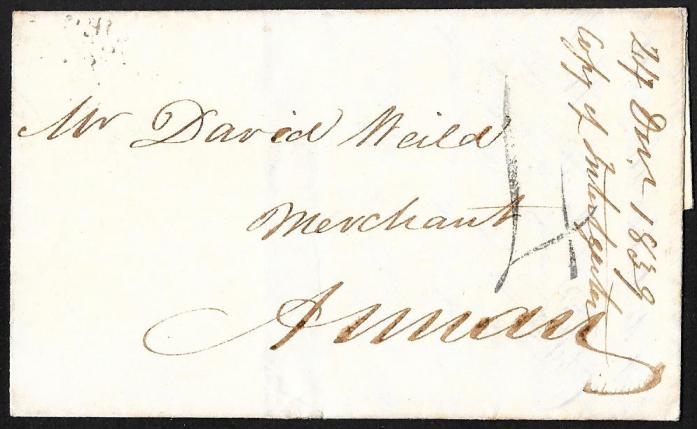
153993.
Clean wrapper from Edinburgh to Annan,
Edinburgh date stamp on reverse top flap for December 24th 1839.
Cancelled by a fine strike of the Edinburgh handstruck '4'.
A fine example from the short lived Uniform 4d Post period.
Price: £85.00
EDINBURGH Handstruck 4:
early usage in the Uniform 4d Post Period

152627.
A rather tired letter from 12, Charlotte Street, Edinburgh to writers in Melrose.
On the front is a fine strike of the Edinburgh handstruck '4'
and a very early usage during the short-lived Uniform 4d Post.
The letter, which could be displayed well, is dated December 7th 1839
and refers to financial matters including tenants of the DUKE of BUCCLEUCH.
No postal markings but with the top flap raised, as in the scan,
the date of December 7th 1839 displays well.
Price: £75.00
NB: the Duke of Buccleuch became famous when in 1946,
a mint block of 48 2d blues Plate 2, ie the bottom four rows of the sheet,
was discovered at his home: the press articles are on the internet.
The 2d blues would have been bought only a few months after this letter.
Portadown: late usage of 1d red


152611.
1d red, 'RB', Plate 167: fine/very fine, full margins, on a wrapper from PORTADOWN to Lurgan.
Stamp tied by a legible strike of the '375' of PORTADOWN.
On the reverse are very fine date strikes for Portadown, April 29th 1857 and
for Banbridge and Lurgan for the following day.
The 1d red imperf was replaced by 1d SG17 on March 12th 1854.
The example offered here is a rare Irish LATE USAGE of the 1d imperf issue.
Price: £95.00
One of the, if not the, earliest usage of any Railway Letter stamp

152609.
1d lilac Die 2, with a Railway Letter 2d stamp of the BELFAST AND NORTHERN/ COUNTIES RAILWAY:
each with a BELFAST duplex for February 3rd 1891, and pen cancellation, and tied to a large piece.
Capt. Jackson in 'The Railway and Airway Letter Stamps of the British Isles 1891-1971',
notes these railway stamps came into use in February 1891.
He lists the Belfast and Northern as received from the printers on January 27th 1891
and notes only one used example of this issue known at that time.
It was replaced by the next issue in April 1891.
One of the, if not the, earliest known example of any Railway Letter Stamp.
An item of Exhibition importance.
Price: £170.00
NB: The Railway Letter Service was the only real express letter service,
a service which the Post Office, in spite of its monopoly, could not provide.
Capt.Jackson's Book was the result of over 20 years study
of more than 80,000 of these stamps including 4,000 covers.
Trio of 2d Blue Plate 4 on letters from COLERAINE







152587.
A very rare/unique TRIO of banking letters from the same bank in COLERAINE
and each sent to the same bank, Belfast Bank, in Ballymoney.
The First: 2d SG 13 Plate 4, scarcer pale blue shade,
two fine singles 'NB', 'KK', tied by a SINGLE partial strike of the '149' numeral of COLERAINE.
'NB' has full margins to very close/touching in the NE corner; 'KK' has full margins.
Remarkably, both stamps have the listed variety SC Spec ES13e; 'Shifted transfers: upper shifts'.
On the reverse are date stamps for Coleraine February 7th 1852 and
a Ballymoney date stamp for SUNDAY February 8th 1852.
The Shaida Collection contained a long cover with a pair of 2d blues plate 4
cancelled by a single inverted '186' of Dublin.
A photocopy of the Shaida cover is provided with this item.
It appears that only four such examples are known.
The example offered here has two SINGLES, rarer to find on a 'normal' cover than a pair.
From our researches we cannot find an example of a pair on cover, except for the Shaida item,
cancelled by a single numeral from any location,
With TWO SINGLES cancelled by a single numeral, this example appears to be the ONLY ONE KNOWN.
In addition, with the varieties on the 2d blues, we are confident that this example will be UNIQUE.
The Second: 2d SG13 Plate 4, pale blue shade, a fine single with full margins, 'ND',
tied by a fine upright strike of the '149' numeral of Coleraine.
On the reverse are date stamps for Coleraine, June 17th 1852
and a partial strike of Ballymoney for the following day, a Friday.
This stamp lettered 'ND', in the same pale shade as those affixed to the first letter,
is only two stamps away on the sheet from the 2d 'NB' used on the first letter.
Although separated in date by some months, it is possible the bank had 2d's from the same sheet
already cut up into singles for ease of using.
This could explain why two singles were used in the first item and not a pair.
The Third: 2d SG19 Plate 4, 'CF', fine and missperfed, tied by an inverted '149' of Coleraine.
On the reverse is a date stamp of Coleraine for September 9th 1854 and
a SUNDAY Ballymoney date stamp for September 10th 1854.
A unique grouping that would make a memorable display.
Price: £750.00
NB: two of the three letters have SUNDAY receiving date stamps and
each shows a different orientation of the '149' numeral.
2d Plate 3 on an early Railway Letter 1842



152526.
2d SG14, fine/very fine Plate 3, 'JE', almost full margins, close but clear at left until just touching the NW square.
Lightly cancelled by an underinked Edinburgh Cross on an interesting entire to Irvine, October 7th 1842,
addressed to a Mr B H Blythe, Resident Engineer, Glasgow and Ayr Railway,
it contains references to the purchase of railway sleepers, railway lines and slate: a note on the rear top flap also refers to these.
The addressee was Benjamin Blythe who trained as a Railway Engineer with Grainger and Miller.
Wikipedia has a lot of detail about this man and his famous family members briefly:
in 1848 he established an engineering practice on the prestigious George Street (at no 124) in Edinburgh
where it would remain for the next 100 years.
In 1854, after his brother Edward Lawrence Ireland Blythe, finished his own apprenticeship with Grainger & Miller,
Benjamin took him into partnership of the renamed B & E Blyth.
On the front is a very fine strike of the Edinburgh 'Paid 1d Extra', McKay Fig 1150.
For an extra 1d, mail could be handed in late at the Edinburgh Post Office between 6pm and 7pm.
Hence the 2d stamp paid the 1d postage plus the 1d Late Fee.
We have seen few examples of the 2d used in this way.
A rare item which the internet information would enhance as a display page.
Price £350.00
NB: there is a great deal on information on the internet about the Glasgow, Paisley, Kilmarnock and Ayr Railway,
including drawings of the early rolling stock,and a print out from the internet is available with this item.
Superb example of the 'dot in centre' variety


152590.
1d Plate 28, 'CG', fine full margined, the filing crease at the right crosses below the 'G' square.
Tied to a wrapper to Paisley by a very fine/superb GLASGOW cross.
On reverse is a fine Glasgow date stamp for April 13th 1843 and
a Paisley receiving date stamp for the same day:
a better service than we have today, 177 years later!!
1d Plate 28 is priced on cover by Gibbons at £135.
The cross shows the variety 'dot in the centre' which is listed by Danzig.
It was caused by the nail holding the metal cross in place
to the handle of the canceller becoming 'proud' by usage.
An excellent example of this variety which is seldom found on cover.
Price £50.00
Dublin to Falmouth: a very rare back stamp


152568.
Wrapper from DUBLIN to Falmouth February 26th 1841.
On the reverse is a strike of the very rare Dublin: 'FROM 8 to 8.30 P.M' in diamond.
McKay, 'Irish Postmarks Since 1840', notes these very rare types, Fig 1071, are thought to indicate posting
after the normal hours of despatch, (the earlier time stated), but before the despatch of the mails, (the second time stated).
On payment of a late fee the letter could be sent forward that evening.
On the front is a boxed paid date stamp in red for February 26th 1841 and a red m/s '1' in red.
The latter was the late fee payment relating to the timed back stamp.
A rare item.
Price: £80.00
Edinburgh Roller Cancellation

152503.
A pair of 6d SG70, horizontal crease close to the bottom, and
a fine/very fine pair of 2d SG34 plate 5, 'DA-DB'.
The 2d 'DB', has the only major re-entry on this plate, SG Spec F6(d);
the cancellation allows the re-entry marks to be clearly seen in the NE corner star.
This variety is illustrated by Gibbons in QV Volume 1 and much underpriced at £200.
The stamps are cancelled and tied by the '131' Edinburgh roller, McKay fig 428,
recorded in use from March 1856 and the third type to be introduced ie with vertical division bars.
An attractive combined usage with both surface printed and line engraved issues:
a very rare/unique combination of features and a Display item.
Price: £95.00
Edinburgh Roller on 2d Plate 5


152504.
2d blue SG 34 Plate 5, 'MK' very fine, deep shade of blue:
tied to a banking entire to Cromarty, March 17th 1857, by a fine '131' EDINBURGH Roller, McKay Fig 427,
which was the Second Type to be introduced ie the '131' in bars separated by gaps.
2d SG34 priced on cove rby Gibbons at £200.
An attractive and scarce Display-quality item.
Price: £80.00
Lafayette Photographers: Dublin to Scotland 1891


152533.
Separated cardboard, front and back (enlarged image),
which originally would have contained photographs from LAFAYETTE, Artistic Photographers,
sent from DUBLIN to Glasgow, May 7th 1891.
There is a considerable amount of information about these photographers on the internet.
Briefly:
Lafayette Photography has one of the oldest histories of any photographic business in the world,
having been founded in Dublin in 1880 by James Stack Lauder, the eldest son of Edmund Lauder, a pioneering and successful
photographer who had opened a daguerreotype studio in Dublin in 1853.
In adopting the name 'Lafayette', James created a new image for the family business, seeking to prosper from the cachet of a French name
(Paris was then the centre of the art world and of avant-garde photography in particular).
By 1885 the firm was registering some of its best work for copyright, and had attracted the attention of the Royal family
with its best-selling portraits of Princess Alexandra, taken to mark the Royal visit to Ireland of that year.
In 1887 James Lafayette was invited to Windsor to photograph Queen Victoria and
was granted a Royal Warrant as 'Her Majesty's Photographer in Dublin'.
This Royal Warrant, which was subsequently renewed by King Edward VII and George V,
conferred enormous prestige and brought with it the title of 'Photographer Royal'.
This item could make a very interesting display when information about Lafayette was expanded and included.
A rare survivor and the first we have seen.
Price: £70.00
2d Plate 3: Dublin Special Maltese Cross


152530v.
2d Plate 3, 'OE', fine three margined each with traces of an adjacent stamp.
On an envelope, some light creasing, from Dublin to Drogheda, April 13th 1843.
The stamp is tied by the distinctive Dublin Cross, SG Spec ES11ul, leaving a clear QV's profile.
Priced by Gibbons in the latest, QV Volume 1 at £2,000 on cover.
The 2d has been placed top left Contrary to Post Office Regulations
that stated the stamp should be affixed at the top right.
An attractive item that displays well.
Price: £345.00
NB: There is a reference on the internet to Alderman Thomas Ennis,
Westgate Ward, Drogheda, in an 1843 Handbook to Carlingford Bay.
Derry(Co.Derry) to New Jersey in the Retaliatory Period


152489.
A stampless envelope from DERRY(Co.Derry) to New Jersey, USA.
On the front is a m/s 1/- in red; a boxed Derry in red and a red Paid date stamp for October 27th 1848.
The latter was struck in Dublin, McKay figure 919, 'Irish Postmarks Since 1840' and recorded from 1849:
this example is for October 27th 1848 and therefore pre-dates.
On the reverse ia a Derry date stamp in blue for October 26th 1848 and a Liverpool date stamp,
of the type used on maritime mail, for October 28th.
This envelope would have been carried to America on the Cunarder 'America' leaving
Liverpool on October 28th 1848 and arriving in New York on November 28th 1848.
In New York, it was struck with a '29' (cents) this being the REPRISAL rate to be charged to the addressee on delivery
for up to 300 miles radius of New York during the period of postal conflict between GB and the USA.
Despite the peripheral faults and wear and tear to the envelope, this is a very rare example of mail
sent to the USA from IRELAND during this time of postal 'war' between these two countries.
This is the only such example we have seen.
A very rare item and one worthy of display.
Price: £170.00
1/- SG72 : pair with INVERTED Watermark.


152472.
1/-SG72 pair and 4d SG66 pair:
tied to entire to Canada by Edinburgh duplexes, April 13th 1859
with an additional strike clear of the stamps.
The right hand stamp of the 4d pair has a small fault at the right side
but the 1/- pair is very fine with one stamp having the Edinburgh cds.
The 1/- pair have INVERTED WATERMARK and this is the first example we have been able
offer of this 1/- with a cds and watermark inverted even on a stamp not on cover.
Gibbons price for a single 1/- with inverted watermark is £700 and the CDS single at £875.
Allowing for just these 1/-'s being on cover, Gibbons price increases to well in excess of £2,000.
An attractive and very rare Scottish entire.
An Exhibition item.
Price: £620.00
Letter describing a journey from Belfast to Edinburgh in 1845


152437.
1d 'QG', fine 4-margined, tied to a letter from Edinburgh to BELFAST, dated Sunday August 10th 1845, by the '131' of Edinburgh.
On the reverse is an Edinburgh date stamp for SUNDAY August 10th 1845 and a Belfast receiver for August 12th 1845.
In the three page letter, sent from the Albion Hotel, Edinburgh, the writer describes
first of all the rail journey from Glasgow to Edinburgh, a distance of 46 miles.
He comments that 'they arrived safely at Greenock after a very rough passage in about 8 hours having both wind and tide against us.
The most severe gale by far the Captain has encountered'
He desribes going onto the principal business street in Glasgow and the thousands of people in the thoroughfare
and from '9 to 10 all the shops being brilliantly lighted with gas'.
He comments that 'the crops look well but not much further forward than at home. I saw no wheat as good or heavy as ours'
Mentioned is made of the appearance of potatoes that they look well as they were conveyed by special train to Glasgow.
A fascinating letter giving a glimpse of the journey from Belfast via Glasgow to Edinburgh.
The letter would warrant a full transcipt in making an excellent display.
A rare item.
Price: £135.00
Dublin Special Cross: superb Type 1


15160. 2d blue, plate 3, ‘AK’:
very fine
square 4-margined example in the scarcer deep full blue shade and
with the catalogued variety ‘guideline in the NE
corner’.
Tied to a wrapper used internally within Ireland from DUBLIN to CORK,
April 16th 1844, by a
superb distinctive DUBLIN Type 1 cross, SG Spec E1ul and
priced on cover by SG in the latest, 2011, QV
Volume 1, at £2,000.
The MX leaves a largely clear profile; Cork receiving cds on reverse for
April 17th 1844.
This cross is seldom found on cover with a full
margined 2d blue.
A very scarce item.
Price: £675.00
Rare mixed Plates 6 and 8: Belfast to Armagh



15143:
1d black, TWO 4-margined examples, ‘TD’ Plate 8 and ‘AD’ Plate 6
tied to a wrapper from Belfast to Armagh, September 29th 1840.
The rear flap raises to show the dates.
Plate 8 is very fine used in an intense black shade and
Plate 6 is fine used,
a VERY RARE MIXED PLATE franking.
The EKD usage of Plate 8 is
September 5th 1840 and this item used, on September 29th 1840,
is believed to be the earliest
known mixed plate franking with plate 8 in Ireland.
A significant Irish rarity.
Price: £1,150.00
Greenock Characteristic Cross: superb example


152384.
1d red Plate 15?, 'DB': fault at the top, tied to an interesting letter by
an exceptional/superb strike of the GREENOCK characteristic cross, SG SpecB1th.
On the reverse top flap a Greenock boxed date stamp in red for September 27th 1841.
The letter is from a man writing to ask for a job in the Customs House or in Excise.
He mentions that Lord James Stewart promised his father he would support his son in a job application.
Rockoff and Jackson record this cross with only four earlier usages,
of which the first two are on 1d blacks ie May 1st 1841 and May 15th 1841.
The other two are on 1d reds ie September 13th 1841 and September 23rd 1841.
They record, and illustrate, a 1d red cover example used on September 27th 1841,
the same date as the example ofered here, but it is not the same one.
Gibbons prices, in the latest Edition of QV Volume 1 this cross at £500 on cover.
An very early, and interesting usage, of this distinctive cross on a 1d red.
Could make a fine display item when enhanced by the contents of the letter.
Price: £95.00
NB:
On the internet is a wealth of information re the Stewart Family going back to the 16th Century.
There appears to be an outline of a handstruck '1' in black on the front
which may have transferred from another item of mail.
The next two items are the only 'B' Types of Edinburgh Dotted Circles.
More examples of the different Dotted Circle Cancellations
can be found in this Section so please scroll down.
KELSO Distinctive Cross

152150.
1d, 'TA', almost full margins, vertical crease, tied to a small piece
by the distinctive KELSO CROSS, SG Spec B1ti.
Priced by Gibbons on stamp at £800 in QV Volume 1, Edition.
An opportunity to obtain a collectable example of this very scarce cross
at a small fraction of the Gibbons price.
Price: £65.00
Scroll down for a selection of
Edinburgh, Dundee and Greenock
Dotted Circles
1d Plate 48: Dublin '186' on Block of 8 with Certificate

152406.
1841 1d red plate 48, ‘SA-TD’, block of 8: very fine/superb used block, Dublin ‘186’.
Touched or just in to at places but the central block of 4, ‘SB-TC’,
is fine 4-margined: very close but clear at NW corner of 'SB'.
The ‘T’ row all show a degree of double bottom as noted in QV Volume 1 page 100, SG spec BS27h.
Superb rich shade of red brown and with a German, H Richter, Certificate of Authenticity.
Gibbons prices a block of 4 at £320 without the variety.
A very scarce item of Display quality.
Price: £375.00
SLIGO Cross and Penny Post


152382.
1d 'EK', fine, 4-margined except just touching at 'E' square:
clean entire to Dublin requesting advice on applying for a post with Customs and Excise.
Stamp tied by a fine strike of the Type 2 SLIGO cross:
Rockoff and Jackson Volume 2, note that Moxter records
the Sligo cross on covers between July 1840 and February 1844.
However Rockoff and Jackson have been able to record only seven examples,
from October 1841 to February 1844, and they classify two types of cross.
Of these, only two examples December 1843 and February 1844, are of Type 2.
The example offered here is a later usage than recorded by either Moxter or Rockoff and Jackson.
On the front all struck in the same shade of blue are:
a Sligo March 26th 1844; a Sligo Penny Post; a No.1 and a TOO LATE.
The TOO LATE strike explains the Sligo March 27th 1844 on the reverse.
Also on the reverse is a fine red Dublin receiver for the following day.
An attractive and rare item which would make an interesting display.
The scan does not do justice to the blue of the cancellations.
Price: £330.00
NB: The address is interesting: below 'Dublin' the writer has added
'or else where'.
Does he mean Dublin or Ireland?
Would certainly be a challenge for the Postman!
1d Reserve Plate 50: SG42


152353. 1d SG42, 'SF', very fine tied to an envelope from KELSO to Glasgow, May 26th 1864.
The stamp is printed from Plate 50, experimental engraved letters on the plate rather than the usual hand punched ones.
The envelope has a part of the rear flap missing but is very fine otherwise.
Priced by Gibbons at £70 on cover which is undervalued in our experience.
Price: £45.00
NB: this item is from the Statham Collection.
The envelope is finer than the scan suggests.
For exampes of Reserve Plate 51 and Reserve Plates 16 and 17
see the 'Other Line Engraved' Section.
Earliest Recorded Usage of a numeral cancellation in IRELAND


152347.
1d red, 'KF', 3-plus margins just tied to a very clean mourning envelope by the '186' of DUBLIN.
On the reverse is a Dublin date stamp for JUNE 22 1844 and
a Six Mile Bridge date stamp for June 23rd 1844 - a SUNDAY.
This is the earliest recorded usage of a numeral cancellation in Ireland.
A superb Exhibition item.
Price: £395.00
2d Plate 4: Single ABERDEEN numeral Contrary to Regulations

152314. 2d SG14 Plate 4, 'BA-BB': a very fine 4-margined pair, close at the NW corner on 'BA' but just clear.
Cancelled contrary to Post Office regulations by a SINGLE number '1' of ABERDEEN.
The cancellation leaves both stamps with a clear QV profile.
The pair is printed on THIN PAPER, listed by Gibbons as ES14q and priced as a single at £225.
With SG's premium for a pair, their price increases to £700 without a premium for the single cancellation.
An attractive and very scarce item which would display well.
Price: £225.00
2d Plate 3 used in ABERDEEN

152315. 2d SG14, 'AD-AE', Plate 3, very fine with fresh colour:
A full margined pair lightly cancelled by Aberdeen numeral '1's.
The stamps show the characteristic letters 'A' and 'D' of plate 3.
Printed on THIN PAPER which is NOT listed by Gibbons
on this plate 3 but is for plate 4 - see item 152314.
Priced by Gibbons as a pair at £280.
A very fine and attractive item.
Price: £120.00
4d SG62: very rare internal usage in Scotland


152308. 4d SG62: very fine and tied to a wrapper by the '209' of KIRKCUDBRIGHT
with a date stamp for April 8th 1856 and a Dumfries receiver for the next day.
An internal UK usage of this 4d is very rare and it has been commented in philatelic publications
that such internal usage is almost as hard to find as examples of SG62 used on its day of issue.
This is the first example we have seen used within Scotland.
Gibbons prices this stamp on cover at £780.
A Scottish rarity.
Price: £475.00
NB: unusually the 4d has NO cracking of the highly glazed surface.
LIMERICK Cross: very rare usage on a Stationery Envelope.


152306. A fine/very fine 1d pink stationery envelope from LIMERICK to Woodbrook,
cancelled by a fine strike of the Limerick cross with a superb Limerick date stamp for March 26th 1844 on reverse.
In 'The Maltese Cross Cancellations of GB and Ireland', Volume 1 page 157,
the examples listed do NOT include one used on a stationery envelope and only one example, on a 1d red, is recorded for 1844.
Gibbons in the latest Edition, 2011, of QV Volume 1, prices this rare cross on a 1d red cover at £1,900.
Usage on a stationery envelope is significantly rarer.
An Exhibition item.
Price: £475.00
NB: we cannot recall seeing previously this cross used on a stationery envelope.
Envelope to TOBAGO: very rare usage of 1d red


152297.
1d red, 'NC', 3-plus margins, tied by a smudged numeral '159' of GLASGOW
to a very clean and uncreased envelope to TOBAGO (West Indies).
On the front is a good strike of the very scarce and miniature single-arc stamp
with a letter 'L', McKay figure 422 in 'The Postal History of Glasgow'.
This stamp was used to denote a late posting and as usual here it is used in conjunction with a late fee paid by a 1d red.
On the front are superb/very fine strikes of 'Insufficiently Stamped' and 'Part-Paid/More to Pay'
both in the same shade of red: these were applied in London.
The latter of the two strikes is very scarce and Johnson in 'Unpaid and Underpaid Mail' notes that
this strike is 'rare/important enough to be included in a collection of unpaid marks'.
A m/s '11d' in black on the front indicates an underpayment and the paper seal has the initials of a Company.
A very rare destination and extremely rare bearing a 1d red: the first we have seen to Tobago.
Also, we have not previously seen this unique type of Glasgow late fee, McKay figure 422,
used with a 1d red imperf going to an overseas destination.
A very rare and attractive Exhibition quality item.
Price: £685.00
NB: it is possible that the post office worker in the London Office,
who probably put on both underpayment strikes, initially applied the 'Insufficiently Stamped'
but then put on the 'Part-Paid/ More to Pay' because
he thought the 1d was paying part of the postage fee to Tobago,
not realising the significance of the tiny Glasgow late fee strike.
The colour of the strikes suggests the same ink pad was used for both.
Mixed perfs and cancellation types on turned envelope




152296
1d fine SG26 perf 16, 'GB',Spec C5(1) tied by a partial strike of the HAWICK '174' numeral, on an envelope to Hull, November 12th 1855.
Soon after the envelope was received on November 13th 1855, it was turned inside out and addressed to LIVERPOOL.
A fine 1d perf 14, 'OJ', Spec C6(1) added which was cancelled by a fine/very fine HULL spoon, Type D for November 14th 1855.
A very rare combination of perf types and cancellations.
Price: £130.00
NB: this item would make a superb Exhibition pairing with item 152295.
1d SG26 Spec C5 priced by Gibbons on cover at £240 and Spec C6 at £75 with a numeral cancellation.
Observance of the Lord's Day and the rare Edinburgh UPP 2d



152288.
This item is from a Display and the description was as follows:

The small selection of scanned pages give a flavour of the questions asked
and the written replies to Questions 1-12 from a total of 35.
The black marks are caused by the scanner and are not on the pages.
The description could be expanded to include: steamers, ferries, public houses, funerals etc etc.
A truly remarkable document that gives a deep insight to the demands and influence of the Church in Scotland in 1840.
This rare document is made rarer, possibly unique, by it being sent postage unpaid and receiving a fine strike of
the rare Edinburgh, Uniform Penny Post, Auckland ED262, for April 2nd 1840: this variety was in use for only a few months.
This would make a memorable display item which could be expanded in its description in so many ways.
Price: £290.00
NB: the brown marks on the front of the document are NOT present: a trick of the scanner.
More details of George Burns, Minister of Tweedsmuir, are available on the internet.
As is more information about, and photos of, CROOK INN: which claims to be the oldest inn in Scotland.
Welsh Social History 1844: Office for Stamps and Taxes



152284.

Superb window into passenger vehicle hire in 1844.
Price: £55.00
An 1822 Document sent in 1842 in Wales



152278.
A remarkable item: an official document, dated 1822 with another dated note inside for 1835, turned into a letter and
sent locally within CORWEN, Merioneth, on May 2nd 1842 and received the following day.
On the front is written 'Stamped Sunday Night': May 1st 1842 was a Sunday.
The postage fee has been paid by a 2d blue Plate 2, SG5, and two 1d red imperfs.
The 2d blue, NL', is just 4-margined has a large portion of the Queen's head clear though with faults.
One 1d red is almost full margined and the other is only a partial stamp.
The three stamps would all have been marginal and the margins have been folded on to the back of the letter to help to seal it.
The staining on and around the stamps and on the back of the letter, appear to be largely from the gum of the stamp margins.
The partial 1d stamp was damaged when the letter was opened.
A 4d rate with an 1840 2d blue used in conjunction with the 1d red
is a rare combination and especially so on a complete cover or letter.
The 'Daisy' Collection, The Dr Pichai Collection, The Chartwell Collection and the Lady Mairi Bury Collection:
none of these contained a 4d rate with this combination on cover or letter.
The 2d Plate 2 on cover is priced by Gibbons at £3,250.
A very rare Welsh usage.
A truly remarkable survivor which despite the faults would make a memorable Exhibition item.
Price: £550.00
STONEHAVEN: the none double-lined cross variety


152294. 1d 'SA', Plate 30:
a very fine/fine 4-margined example from this scarce plate tied to an entire from
STONEHAVEN to Montrose, July 22nd 1842 and delivered this same day.
The Stonehaven cross here shows no double-lined effect.
Rockoff and Jackson Volume 2, list and illustrate 18 examples of the double-lined cross,
but only 11 examples of the Stonehave cross with no double-lined effect.
Only one 1842 example is listed, that on a 1d pink envelope.
Stonehaven had a population in 1841 of only 3021 and
even the none double-lined cross on cover is very scarce.
Gibbons in the latest 2011 Edition Of QV Volume 1, prices a 1d plate 30 on cover at £250.
A rare combination of plate and cross.
Price: £125.00
COLUMBA GK & ARDRISHAIG PACKET

152236. 1/2d SG 215:
fine/very fine example, very small wrinkle at right, tied by a superb strike of the
Columba steamer GK & Ardrishaig Packet, July 4th 1904 with the scarce Code A.
Postcard with a view of the Ruel River at Glendaruel.
The card is in excellent condition apart from a small corner crease and sent to West Cliffe on Sea, ESSEX.
Very attractive item.
Price: £45.00
COLUMBA GK & ARDRISHAIG PACKET

152237. 1d SG 219, very fine used:
tied to a postcard in exceptional condition by a fine/very fine strike of the
Columba steamer GK & Ardrishaig Packet for July 11th 1906, Code B.
The postcard was sent to the USA with a fine receiver date stamp for July 23rd 1906.
We have seen only a few postcards to the USA with this steamer cancellation.
Superb item.
Price: £50.00
NB: the Columba strike is better than in the scan.
The view on the p/card is of Derwentwater from Castle Hill.
OP-PC ERROR Used in Scotland


151253. SG53, three halfpence, Plate 1:
Error of Lettering, 'OP-OC' for 'CP-PC'.
Good used example of this popular rarity
tied to small piece by the '135' of ELIE, Fife.
Bluntish perf at bottom left but a very collectable example and
one of the few we have seen used in Scotland.
It is offered with a very fine Plate 3, SG51,
with the correct lettering 'CP-PC', lightly used.
The error is priced by Gibbons at £2,000.
An attractive pairing that would display well.
Price: £350.00
Madeleine Smith Cancel in GREEN

152197. 1d SG29, fine, 'GB':
tied to a small piece by a strike of the Glasgow Type 2 Experimental Duplex in GREEN.
Green ink is known used from May 5th 1856 to May 15th 1856: a period of only ELEVEN days.
The date, not a full strike, is MAY 5th 1856: the first day of this ink being used.
Priced by Gibbons in QV Volume 1, 2011 - latest Edition, at £550 on piece for an Irish duplex
with a note that green duplexes in England or Scotland command a significant premium.
It is very hard to find any example in green with such a short period of usage.
A very rare item.
Price: £220.00
Madeleine Smith in GREEN


152196. A pair of SG29, light horizontal crease:
tied to a piece by two fine strikes in GREEN of the Type 2 GLASGOW Experimental Duplex.
This cancellation in green is known in use for ELEVEN days only between MAY 5th 1856 and May 15th 1856.
The strikes on this piece are for MAY 6th 1856 - the second day of usage.
Priced by Gibbons in QV Volume 1, 2011, latest Edition, at £550 for a SINGLE strike on piece for an Irish duplex
with a note that green duplexes in England or Scotland command a significant premium.
It is very hard to find any example in green with such a short period of usage.
From our researches, the example offered here is the only known multiple usage of this rare colour.
On MAY 16th 1856 green ink was replaced by the usual black
as seen in the piece which is included with this item.
An extremely rare/unique pair of Exhibition importance.
Price: £445.00
NB: the scan does not do justice to the green colour.
Missent to Glasgow: a rare SUNDAY usage

152180.
1d red, corner crease on entire written in Edinburgh and sent to Stiirling.
1d red would have been cancelled in Edinburgh; Edinburgh type of cds on reverse for June 13th 1847.
On the front is a fine strike of the MISSENT TO GLASGOW, Aukland GW184, rated very rare.
On the reverse top flap is a fine Glasgow date stamp also for June 13th 1847
which displays well the flap is raised'
There is also a small part of a Stirling date stamp in blue for the 14th.
June 13th 1847 was a SUNDAY so this is a rare Sunday usage of a Missent mark
and the ONLY example we have seen of a Missent strike used on the Sabbath.
Attractive item with a rare combination of features.
Price: £85.00
Perth Experimental Duplex: very rare New Years Day usage


152158.
1d SG29, fine used, tied to a part wrapper, no side flaps, from PERTH to Kirriemuir by
the Perth Experimental Duplex for JANUARY 1st 1857.
Of the 18 types of Scottish Experimental Duplexes, this is the ONLY example of any type
we have seen used on New Years Day.
On the reverse is a fair strike of the South Metheven Street Receiving House struck in green.
This strike is recorded in black from 1846 to 1857 and in green in 1857 and 1858.
Hence its usage on January 1st 1857 is the earliest recorded in this ink and may well be a First Day usage in this shade.
Also on the reverse is a Kirriemuir cds for January 2nd 1857 also in green.
On the inside is a printed heading: Edinburgh Perth & Dundee and Scottish Central Railways
Superintendent's Department Perth. More info on the internet about this early Railway Company.
A rare/very rare item.
Price: £85.00
NB: one wonders if the slightly blurred impressions of the Perth duplex and the Receiving House
could be a consequence of the postmaster/mistress recovering from the Hogmanay celebrations!
Scroll down for more examples of Experimental Duplexes including some of the rarest varieties.
Arbroath Cross on 1d Plate 8

152124.
1d red Black Plate 8, 'OG', 3 plus margins but defective at the right, tied to an entire from ARBROATH to Irvine:
very fine strike of the Arbroath Cross with an Arbroath date stamp for July 4th 1842 on the top flap which displays well when raised.
Rockoff and Jackson record this cross in Volume 1 but not the example offered here.
Only five examples with an earlier date are recorded by them.
Although this cross is unlisted by Gibbons, in our experience it is rarer than Greenock, Perth and Stirling which
together with Dundee are the 'Post Road Crosses' and difficult to distinguish from each other unless on cover.
Gibbons prices the Greenock cross on cover with a 1d red from a black plate at £1,500 and the Perth cross at £3,000.
This is only the second example we have been able to offer and the first for some years.
Price: £130.00
PERTH CROSS: a letter from and to interesting individuals


152131.
1d red, a very fine 4-margined example, plate 21, 'IG': tied to an entire by a fine/very fine PERTH CROSS, SG Spec B1tt.
On the top flap is a superb Perth boxed date stamp for November 29th 1842 and a similar Dundee receiver for the same day.
The letter is from a Rev Kerr Johnston, wax seal with his intitial 'J', to a Dr Thomas Dick of Broughty Ferry Nr Dundee.
The Rev Johnston is asking Dr Dick if he could stand in for him on the next Sunday and give the sermon.
He mentions that the STEAMER sails on Saturday from Dundee at 1 0'Clock so he could have a comfortable seat and cabin.
An engraved picture of Dr Thomas Dick is in the Scottish National Portrait Gallery and his picture, and a detailed biopic, is on the internet.
Briefly: he was a scientist and a natural philosopher who in his writings assured readers of the compatibility of science with religion.
Also on the net is a portrait of the Rev Kerr Johnston of Perth and a detailed biopic of him too.
The PERTH CROSS on cover is priced by Gibbons at £1,000 in the most recent Edition, 2011, QV Volume 1.
A superb and rare item that would, when written up fully, make an interesting Exhibition page.
Price: £325.00
Distinctive PERTH Cross on Banking Entire


152125.
1d red, 3-margined, clear profile, tied to a clean Perth Bank letter to Edinburgh
by a very fine/superb strike of the PERTH characteristic cross, SG Spec B1tt.
Perth date stamp on the top flap for March 5th 1842: this example is unrecorded by Rockoff and Jackson.
Priced by Gibbons at £1,000 in the latest, 2011 Edition, QV Volume 1.
An attractive example of this cross.
Price: £125.00
Envelope from Abergavenny to Prussia


The 6d ship letter rate to Prussia has been paid by three imperf plate 4, 2d blues,
AJ, AK-AL in a single and a pair with consequetive letterings.
Stamp ‘AJ’ has 4-margins and shows plate corrosion marks in both ‘Postage’ and ‘Twopence’ areas.
The 1d imperf, plate 172, almost 4-margined, and was probably added as a late fee.
Aus England Per Aachen in orange on the front. Stamps tied by the numeral ‘1’ in oval of bars for Abergavenny.
On the reverse are overlapping date and transit markings including one for Abergavenny, January 28 1854.
The first such item, with the imperf 1d or 2d sent overseas
from a location other than from Cardiff, we have been able to offer.
A rare Welsh item to an overseas destination.
Price: £275.00
NB: envelope in finer condition than the scan.
Duke Street Leith Scots Local: two stampless entires to same addressee in France




152043.
Duke Street Leith: Scots Local cancellation Type V11, very fine strikes on two fine stampless commercial entires to the same addressee in France.
The first sent on April 19th 1858, the last year of usage recorded by Alcock, and the second on June 21st 1859 with an Edinburgh duplex next to it.
The first has a handstamped '8' and the second a m/s '8' ,both in black, as they were sent unpaid and charged the double rate.
In the Robson Lowe Meredith Sale of 'Scots Local Cancellations', there was NO example of any Scots Local cancellation used on a stampless letter or cover.
A rare and attractive pair of Exhibition quality.
Price: £155.00
Uniform 4d Post: a rare FIRST SUNDAY usage


152041. Uniform Penny Post Period: a Scottish Widows Fund and Life Assurance Office printed request for
a statement of health on the Revd James Porteous, Parish Minister of RICCARTON, Ayrshire.
Also printed inside are details of the 18th Annual AGM, 1832, listing of the Court of Directors and the value of insurance policies.
The letter is hand dated inside December 4th 1839, AYR - the day before the introduction of the Uniform 4d Post.
However the letter was posted to Edinburgh on DECEMBER 8th 1839:
the FIRST SUNDAY of this short lived uniform 4d post period, a m/s '4' in black on the front.
There are only five Sunday date usages possible in this perod which ended on January 9th 1840.
On the top flap is a fair but legible boxed date of AYR, December 8th 1839, and an Edinburgh cds for the next day.
The letter was possibly held back until after the 5th December to take advantage of the reduced postage charge.
This the first example we have been able to offer of this rare first Sunday usage and can not recall seeing another one.
A Scottish item with an extremely rare combination of dates:
the day before the U 4d Post period was introduced and a First Sunday usage in its period.
A first Sunday usage is considerably rarer than a first day December 5th 1839 usage.
An Exhibition item.
Price: £490.00
1d Plate 1b: INVERTED and Upright Watermark in Matched Pairing



152039.
1d Plate 1b, 'FI', double letter 'F', SG Spec A55f: two very fine 4-margined examples
both with this variety and each with a vertical guide line in the NE corner square.
The first is on a wrapper from Paisley to Edinburgh, September 7th 1840, and tied by a fine/very fine PAISLEY cross.
There is a vertical filing crease close to, but clear of, the stamp at the left.
The stamp has been affixed over a pre-existing light horizontal crease in the wrapper near the top.
The stamp has an INVERTED watermark, SG Spec AS55l.
The margin at the bottom shows part of 'GI': stamp 'GI' is also
one of only EIGHT double letters listed on this plate.
The second is on a front with the top flap from Edinburgh to Prestonpans, December 18th 1840,
sent from the Edinburgh and Glasgow Railway;
the stamp tied by a lightly struck Edinburgh cross and Its watermark is UPRIGHT.
Plate 1b with inverted watermark is priced by Gibbons in this plate at £2,500 for a stamp not on cover.
Allowing for being on cover and with the double letter variety, an estimated Gibbons price is £5,700.
This is the first example we have seen with inverted watermark on cover.
An Exhibition quality pair both used within Scotland.
Price: £1,875.00
NB: Rockoff, in Volume 2 of 'The Maltese Cross Cancellations of GB and Ireland', the earliest listed example of the
Paisley cross is for March 16th 1841, all the examples illustrated are on1d red covers, and are poor debris-filled strikes.
The Edinburgh and Glasgow Railway was opened to passengers in 1842.
1d SG 40 pair: Single Scots Local Contrary to Regulations


152040. 1d SG40, very fine vertical pair on a wrapper from GLASGOW to PAISLEY, March 8th 1857.
Cancelled Contrary to PO Regulations by a fine/very fine single Scots Local of Queens Street, Type XV111.
Recorded in use from 1854-57 so this the last year of usage.
An attractive and very scarce item.
Price: £76.00
NB: seldom find vertical pairs on cover so cancelled.
Rare combination with a Scots Local Cancellation.
15005.
1/- SG55, Die 2, full margined, very slight buckling, priced by Gibbons at £1,100:
used in combination with a fine 4d SG63, priced by SG at £575.
Tied to piece by a fine strike of Scots local SAUCHIHALL, Type X111 with a hand written 1856 date.
Very rare to find this cancellation on either of these two stamps
and possibly unique in combination.
Price: £375.00
d SG62: Queen Street Scots Local

151309. 4d small garter, SG62:
a fine pair tied to piece by the Queen Street (Glasgow) Scots Local Type XV111.
The Meredith Sale of Scots Locals had no examples of any type on the 4d SG62.
Gibbons only prices Scots Locals on the contemporary 1d value but
their price for two single SG62's is £900.
A very rare item.
Price: £230.00
DUMFRIES distinctive cross

151903.
1d red 'LH', on entire from TERREGLES, a small village near DUMFRIES, sent to DUMFRIES
with on the reverse a lightly struck but legible Dumfries boxed date stamp in red for August 17th 1843.
The 1d red, good margins on three sides but in to at the top, tied by a fine strike of the
distinctive DUMFRIES CROSS, priced by Gibbons, Spec B1tj, at £1,100.
The letter refers to rent arrears for the past NINE YEARS totalling £5.13.3:
barely the price of a gallon of petrol in today's money!!
This example is NOT listed by Rockoff in Volume 1,
and only four earlier examples are noted - the EKD is June 17th 1843.
None of the examples listed by Rockoff are used locally in Dumfries.
An attractive example of this small cross on an interesting local entire.
A very fine display item.
Price: £245.00
NB: the vertical filing crease at the right does not cross the 1d red.
DUBLIN ADDITIONAL 1/2d's
The next three items are examples of the very rare DUBLIN Additional 1/2d tax.
May 1834 Dublin to Edinburgh

151846.
Long letter from one brother to another describing largely his lengthy journey from Scotland to Dublin,
the weather conditions, his sleeping arrangements and
the number of people affected with sickness because of the rough seas.
He was not one of them!
On the front a superb strike of the very rare DUBLIN Additional 1/2 with on the reverse
a Dublin date stamp for May 30th 1834 and a complete wax seal.
This Additional 1/2 strike is in the first of the three periods of usage.
In the recent publication, April 2017, of the Additional Mail Tax by Baker et al,
the Dublin Additional 1/2 is priced at up to £175 on cover.
The latest date they record for this first period of usage is May 27th 1834
so the example offered here extends it by 3 days!
A very rare item.
Price: £135.00
January 1837 Dublin to Edinburgh


151847.
Printed request from an Insurance Company asking for an opinion as to the health of a named person.
On the front is a very fine strike of the DUBLIN Additional 1/2 and on the reverse top flap and
a Dublin date stamp for January 19th 1837 which displays well when raised.
This is the third and final period of usage of this very rare 1/2 strike.
In the recent publication, April 2017, of the Additional Mail Tax by Baker et al,
the Dublin Additional 1/2 is priced at up to £175 on cover.
A rare item.
Price: £120.00
July 1837 Dublin to Edinburgh

151848.
Entire from Dublin to Edinburgh with on the front a fine strike of the very rare DUBLIN Additional 1/2
and on the reverse a Dubil date stamp for July 27th 1837 and an
Edinburgh receiver for July 29th 1837 and a m/s charge of 2/8.
This is the third and final period of usage of this Additional 1/2.
In the recent publication, April 2017, of the Additional Mail Tax by Baker et al,
the Dublin Additional 1/2 is priced at up to £175 on cover.
A rare item.
Price: £105.00
Experimental Duplex cancellations on the contemporary 1d value.
Second day of usage

One day after the earliest known date of usage
and the earliest recorded multiple franking.
Price: £95.00
The RARE Glasgow Type 1 Experimental Duplex


151249.
Glasgow Type 1 Experimental duplex:
fine 1d SG21, clear profile, tied to a wrapper to Manchester by this RARE,
and sporadically used cancellation for November 28th 1855;
Manchester receiver on the reverse.
This cancellation is usually smudged and this example is a fine strike for it.
Price: £390.00


151250.
Glasgow Type 1 Experimental duplex:
fine 1d perf 14, tied to a letter, large part missing on central reverse,
by an EXCEPTIONAL strike of this RARE cancellation, for February 1st 1856
and one of the finest examples we have seen.
There is a similar quality of strike, for the same date,
in the Dendy Marshall Colection now housed in the National Postal Museum.
The last day of recorded usage is February 4th 1856.
This cancellation is made even rarer by the Code 'H' being to the left:
very few examples on cover are known.
Without doubt, one of the, if not the, finest examples in private hands.
Price: £525.00
Rare Greenock Type 1 Experimental Duplex


151842.
1d perf 14, SG 29, on an envelope to Burntisland, tied by a fine strike of
the rare GREENOCK Experimental Duplex Type 1 for December 2nd 1856.
The '6' in the year plugs is dropped: the proof strike does not show this.
Only four other types are listed as rarer than the Greenock Type 1.
The latest recorded usage in the Scottish Postal History Group publication is December 8th 1856.
This example is hence very close to the latest date of usage.
The 1d SG29, is in the period, October 1856 to March 1857.
Known as the transitional period, the printers were gradually
trying to remove the blueing of the paper.
The example here shows some blueing.
A rare item which displays well.
Price: £165.00
NB: on the reverse is a normal Greenock date stamp which contrasts neatly
to that of the Experimental Duplex.
Aberdeen Experimental Duplex



151844. 1d SG29, corner fault and crossed by a very light folding crease,
tied to an envelope to Kintore by a very fine/fine Aberdeen Experimental Duplex Type 1b.
October 31st 1860 code H with a superb boxed KINTORE date stamp for the following day.
The envelope could not be delivered and marked 'Removed gone no address' in red .
Aberdeen cds in blue next to the duplex for November 7th 1860.
The envelope has its original contents - a demand for 4d to be sent to the School-house in Kintore!
Attractive item.
Price: £45.00
Edinburgh Cross: Last Day of Usage


151845.
1d plate 38, strip of 4, 'GA-GD', 'GB' affected by a filing crease, on a wrapper from EDINBURGH to Brechin.
Stamps tied by the Edinburgh Special Type 6 (Balloon) cross.
This was the last type of cross used in Edinburgh before replaced by the 131 numeral canceller.
Rockoff and Jackson note the last day of usage to be June 24th 1844
and only record it used on a 1d pink envelope with this date.
The example offered here has a very fine Edinburgh date stamp for JUNE 24th 1844 on the top flap
and a Brechin date stamp for the following day.
This is the only example of which we are aware of the 1d red used on this last day, and this item
with a strip of four 1d reds, is very likely to be a unique mulitiple usage of this cross on its last day.
A Scottish rarity.
Price: £385.00
Uniform 4d Post Period: rare Free Front Sunday Usage



151792. Very fine front, mounted on card, from Haddington, SUNDAY December 15th 1839,
to Lady (Elizabeth) Grosvenor, Eaton Hall, Chester: signed TWEEDDALE, George Hay, 8th Marquess of Tweeddale.
On the front is a Haddington P.P.Pay One Penny, Auckland EL 78a, for December 15th 1839, struck in Blue.
Auckland only records this cancellation struck in black and red.
As it was not struck in red to denote 'paid' one wonders if the recipient was surcharged.
December 15th 1839 was the SECOND SUNDAY of the Uniform 4d Post Period which began on December 5th 1839.
There were only FIVE Sundays in the short lived Uniform 4d Post period, which ended on January 9th 1840.
The painting, image available on the internet, is of Lady Elizabeth just before she married, in 1819,
Richard Grosvenor, 2nd Marquess of Westminster: he became Earl Grosvenor in 1831 and they had 10 children.
A very rare and fine item.
Price: £95.00
NB: see item 151793 in the Stampless Section.
Waterford Cross on 1d Plate 5


151780.
1d red, Plate 5, 'LH', very fine 4-margined example on a clean wrapper from WATERFORD to Dublin.
Stamp tied by a superb strike of the Waterford cross
with a superb Waterford date stamp on the top flap for May 13th 1841.
Rockoff records only three earlier examples of this cross.
Plate 5 priced by Gibbons on cover at £400.
Very fine item and scarce as such.
Price: £210.00
PAID 6d EXTRA of Edinburgh


151736.
1d red, 'AD', very fine 4-margined, Plate 49:
tied to a clean wrapper to Hamilton by the '131' of Edinburgh
with an Edinburgh cds on the reverse for August 15th 1845.
Next to the 1d red is a good strike of the
Edinburgh boxed: ' PAID 6d EXTRA', Auckland ED184.
This is a rare strike and was applied as a Late Fee
which for the high price of 6d, a letter could be handed in between 7 and 7.20pm
before the Post Office closed for the day and would be processed that evening.
Considerably rarer than the 'PAID 1d EXTRA' variety.
Price: £90.00
Paisley Cross: 1d red Plate 9 repaired state

151735.
1d red Plate 9, 'EC-ED': fine full margined partially severed pair,
prepared by the postmaster/postmistress for ease of separation.
Both stamps are from the 2nd repair printing, 'no 'O' flaw', SG Spec AS61.
Tied to a cross written entire by three strikes of the PAISLEY cross with a boxed
Paisley date stamp on the reverse for September 2nd 1841.
The stamps placed at the bottm left side contrary to Post office Regulations.
Rockoff in 'The Maltese cross Cancellations of GB and Ireland', Volume 2 page 219, illustrates and describes this cross.
Its appearance is similar to the so-called 'Post Road' crosses of Arbroath, Dundee, Perth and Stirling.
Of the 10 examples he lists and illustrates, this is the third earliest at September 2nd 1841.
He comments that from September 1841, the cross was poorly struck with evidence
of varying amounts of debris in the obliterator: the cross does not appear to have been regularly cleaned.
The 1d red Plate 9 without 'O' flaw is priced as a single stamp by Gibbons
in the latest, 2011, Edition of QV Volume 1, at £325.
A pair in this repaired state would be priced at £850 and on cover at £1,450.
A very rare item.
Price: £250.00
NB: the condition of the letter is much finer than the scan suggests and there is NO browning.
Plate 55: 306 of Lisnaskea

151678. 1d Plate 55, SG40, 'FL-GL':
overall a fine used block of 4, cancelled, Contrary to Regulations,
by only two '306' numerals of LISNASKEA.
Gibbons, in the latest Edition, 2011, of QV Volume 1,
prices a block of four in this plate at £150.
Unusually, there is a plate sratch on 'GL' to the left of QV's head.
A misalignment of the stamps is also visible.
A very scarce/rare Irish usage.
Price: £85.00
Plate 55: 302 of Letterkenny

151679. 1d Plate 55, SG40, 'GC-HD':
some light wrinkling, short/pulled perfs on 'HD' and a brownish reverse,
but cancelled by the '302' of Letterkenny.
Gibbons, in the latest Edition, 2011, of QV Volume 1,
prices a block of four in this plate at £150.
Scarce Irish usage.
Price: £45.00
Plate 59: 28 of Ballaghaderin

151681. 1d Plate 59, SG40, 'DJ-EK':
short perf 'E' square of 'EK' otherwise fine/very fine block.
Cancelled by inverted '28' numerals of BALLAGHADERIN.
Gibbons, in the latest Edition, 2011, of QV Volume 1,
prices a block of four in this plate at £150.
Very scarce Irish usage.
Price: £55.00
Plate 60: 272 of Killarney

151682. 1d Plate 60, SG40, 'GI-HJ':
some light wrinkling on 'HJ' otherwise a fine block of 4.
Incomplete numeral cancellations but appear to be '272' of KILLARNEY.
Two stamps with clear profile.
Plate 60 is a scarce plate and Gibbons, in the latest Edition, 2011, of QV Volume 1,
prices a block of four in this plate at £250.
A very scarce Irish usage.
Price £82.50
Plate 60: 141 of Ballygawley

151683. 1d Plate 60, SG40, 'NH-NK':
strip of 4 cancelled by superb strikes of the '141' of BALLYGAWLEY.
Each of 'NI-NK' cancelled by an inverted, numeral single type of '41' but
'NH' by the upright numeral portion of the '41' Ballygawley duplex.
'NI-NK' are very fine used, 'NH' has a light vertical crease.
A most unusual combination of the types of numeral '41' used on a scarcer plate.
Gibbons, in the latest Edition, 2011, of QV Volume 1, four singles are priced at £120.
A rare and possibly unique usage of the '41' numeral:
we cannot recall seeing any similar combination.
An attractive and very rare item.
Price: £75.00 SOLD
Plate 62 SG40

151686. 1d SG40, 'AL-BK':
very fine used block, very faintly and indistinctly cancelled leaving virtually each stamp with clear profile .
'BL' has a small piece of black hair 'impressed' into the surface - perhaps as a love token from the sender?
Gibbons, in the latest Edition, 2011, of QV Volume 1, prices a block of four in this plate at £150
before the 125% premium is added for so light a cancellation.
Unusual and scarce.
Price: £68.00
2d Plate 4 strip of 4 on envelope from CATRINE to SIDNEY


151655. 2d Plate 4, strip 'MB-ME':
full margins except 'ME' which has faults, on a small, uncreased, envelope to SIDNEY, New South Wales, Australia.
'MD' has a paper wrinkle/crease around the NE corner but is cancelled by the
Ship-Letter London date stamp, May 14th 1852, in RED and extremely rare as such.
Sent from CATRINE with a MAUCHLINE boxed date stamp for May 13th 1852
and a red London Ship letter date stamp for May 14th 1852.
On receipt in Australia, various transit marks applied on reverse,
and on the front is a handstruck '3' and a m/s '5' both in black.
Also there is a boxed ADVERTISED UNCLAIMED applied in Sidney.
A remarkable item and especially rare with a 2d blue cancelled
by the red London Ship Letter date stamp: the only example we have seen and quite likely unique.
Gibbons prices this 2d blue with a RED 1844 numeral cancellation,
Spec E1wc, at £28,000 on a stamp OFF COVER
and unpriced on cover in the latest Edition, 2011, of QV Volume 1.
A superb line engraved rarity.
Price: £735.00
NB: the envelope is in better condition than the scan suggests especially on the reverse.
Dublin to Port Philip Australia


151656. 2d blue Plate 3, 'block of 4', split into two pairs, 'FH-GI':
on an envelope from DUBLIN to a very scarce destination, PORT PHILIP, Australia.
Dublin date stamp on reverse for April 1st 1852 and a Ship-Letter London date stamp for the following day on the front.
Top left corner of letter with 'p First Ship Direct'.
M/s '3' in black applied on receipt and a Melbourne Ship letter mark on the reverse for July 1852.
The two pairs of the 2d are each cancelled Contrary to PO Regulations, at that time, by a SINGLE strike
of the DUBLIN '186' numeral applied upside down.
Although this was again Contrary to PO Regulations perhaps appropriate as it was sent 'down under'!
The envelope has an embossed crest of The Royal Dublin Society 1731.
This Society was founded on June 14th 1731 by 14 men who met in Trinity College: the 'Royal' prefix was added in 1821.
It was formed to promote 'husbandry, manufacturers and other useful arts and sciences'.
Further information available on the internet.
A very rare item.
Price: £520.00
NB: in 1999, a long/large envelope, not to Australia,
was offered with an untied pair of 2d blues, cancelled by an upside down '186' of Dublin.
It was described as ex Shaida and that only four such examples were known.
We have seen only one other item, (in 2004), addressed to Port Philip (1852), with a
strip of four 2d blues: it was sent from Sheffield.
1d red Plate 9: February 20th 1841


151579. 1d red Plate 9, 'SE': large square margined example, crossed by a filing crease,
tied by a very fine MX to a financial entire, dated February 20th 1841, from BALLINLEA to BALLYMONEY, Co Antrim.
Superb Ballymoney date stamp on reverse for February 21st 1841 - a SUNDAY.
The 1d red was issued on February 10th 1841and the earliest known usage of the 1d red Plate 9 on cover
was in the Pichai Collection: a 3 plus margin on a cover used locally within London on February 19th 1841.
The example offered here is the earliest known example used in Ireland.
In fact, it is believed to be the earliest known Irish usage of a 1d red from any plate.
It is also one of the earliest known Irish usages of the BLACK cross:
black ink officially replaced red ink on February 10th 1841.
The letter is in a cleaner condition than the scan suggests.
An Irish rarity.
Price: £725.00
NB: the Pichai cover was last seen in 2005 in a London Sale: the cover torn, creased and rather dirty.
In 2009, a 1d red Plate 9, with only 2 plus margins, on a wrapper from DUBLIN to WEXFORD,
February 25th 1841, was offered for sale by a specialist London dealer at £2,250.
1d black Plate 2 from Glasgow

151581. 1d black Plate 2, 'FK': very fine/fine 4-margined
tied by a light red MX to an entire from Glasgow to Dorset, September 16th 1840.
On the reverse a wafer seal with the inscription: 'Please Do It'.
The well written letter is from a young man thanking his uncle for acting as a Cautioner in connection with a loan.
Filing crease and a light wrinkle on the front but the stamp printed in the scarcer Intense black shade, Spec AS14
and priced by Gibbons on cover in this shade in excess of £1,100.
Price: £435.00
Plate 1b: INTENSE SHADE

151373. 1d plate 1b, 'HJ', INTENSE black shade, SG Spec AS4:
very fine square margined example, affixed over a light bump in the paper before posting.
Tied to a wrapper from Edinburgh to Galashiels by an orange cross which leaves QV's profile virtually clear.
Priced by Gibbons in this scarcer shade at £1,100 on cover.
Edinburgh cds on reverse top flap for January 6th 1841.
Attractive item.
Price: £380.00
5d SG169 from Glasgow to the US

151560. 5d Indigo, SG169:
fine/very fine example on envelope to Chicago from Glasgow, May 17th 1884.
Chicago cds on the reverse for May 27th 1884.
Gibbons prices this 5d on cover at £325.
Price: £69.00


151507. Wrapper to ARDMADDY, near Oban, m/s ‘Meteorological Instruments’, on the front.
Inverness and Oban date stamps on reverse both for April 30th 1857.
The 1d perf 14, defective at the bottom, tied by an exceptional strike of DALMALLY, Scots Local Type 111.
In the 1971 Meridith Sale of Scots Local Cancellations, there was one example,
illustrated, on a soiled part-entire, it realised £22.00: a very good weekly wage at that time!
The example offered here is a finer strike.
A rare item with such a superb strike.
Price: £245.00
Superb used example: SG137


15183.
cancelled
with a finely struck 1896 Edinburgh cds and leaving a clear Queen’s profile.
One of the finest we have seen for some time and the scan does not do it justice.
Gibbons priced at £4,750 plus 75% for superb used.
NB: there is NOT a crease under the cancellation as
the scan may be suggesting: it is the watermark.
Scarce 1d Plate 142 pair and 2d Plate 3

Edinburgh to Canada


October 1 1863 with 1/- SG71 - the scarcer deep green shade.
Superb and neatly tied leaving at least 90% of the Queen’s head and profile clear.
Gibbons price, £1500 plus allowing the SG premium for such a light cancellation.
Price: £295.00
Plate 1b on redirected
Irish wrapper.



15161. 1d black plate 1b, ‘IJ’, 3-plus margins:
wrapper from CAVAN to Hastings, January 21st 1841 received in Hastings January 24th 1841.
The 1d black was affixed top left over the boxed ‘Paid at Cavan’, the letter re-addressed to
Mincing Lane,
London and received in London on January 25th.
A very scarce Irish item.
Price: £320.00
Belfast to Holland



15158.
1d red, ‘ML’, 3-plus margined example tied by a BELFAST ‘62’ numeral on a wrapper to
ROTTERDAM.
On
reverse two Belfast EVg for November 8th 1850 Blue single arc cds’s
and other transit date stamps
with a Rotterdam receiver for November 11th.
A rare usage of the 1d red from Ireland to
Holland.
Price: £195.00
Rare mixed Plates 6 and 8: Belfast to Armagh



15143:
1d black, TWO 4-margined examples, ‘TD’ Plate 8 and ‘AD’ Plate 6
ied to a wrapper from Belfast to Armagh, September 29th 1840.
he rear flap raises to show the dates.
Plate 8 is very fine used in an intense black shade and
Plate 6 is fine used,
a VERY RARE MIXED PLATE franking.
The EKD usage of Plate 8 is
September 5th 1840 and this item used on September 29th 1840
is believed to be the earliest
known mixed plate franking with plate 8 in Ireland.
An Irish rarity.
Price: £1,150.00
Limerick to Calcutta 1834
15109:
Entire from LIMERICK addressed to a Captain in Calcutta, April 12th 1834.
Inside is a long letter to the parents and a further letter, on the end page,
to an Aunt and other relatives ending ‘God
Bless you all here and there’.
On the front a fine boxed ‘Paid at Limerick’, a London
Ship letter in red
and on the reverse, a Limerick cds for April 12th 1834 and
Indian GPO and
postal rate markings.
Fine item.
Price: £110.00
Dublin Distinctive
Cross


15118.
1d pink envelope cancelled by a
superb characteristic DUBLIN cross, October 16th 1843,
and rarely found so fine on a
stationery envelope.
The envelope was then written across referring to the return of books
and enclosed with the books.
Very unusual but economical with paper!
Price:
£50.00
Hand drawn front

15112.
1854: Front, mounted, to CASTLETOWN- DELVIN
within County West Meath, Ireland February 22nd 1854.
A
pen and ink drawing of a drummer with children.
Struck largely away from the drawing are red cds’s of
KILLUCAN and CASTLE DELVIN.
Very early example of a hand drawn item used internally
within Ireland.
A charming, amusing and very scarce item.
Price: £75.00
WELSH ITEMS
W1.
Entire from Abergavenny to Usk, October 6 1856, with a 1d imperf, plate
162 tied by a superb number ‘1’ of Abergavenny and the RED receiver of Usk.
The 1d red has 4-margined
except just touched at the corner of the SW letter square. On the reverse is a
cds of Abergavenny for October 6 1856 in black and a red Usk receiver for the
following day. A rare late usage of
the 1d red imperf from a Welsh location – the latest from any Welsh location
that we have seen. Price:
£85.00 Image
1 Image 2 Image 3